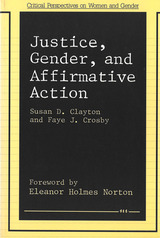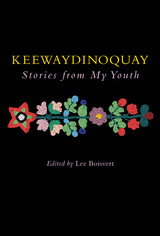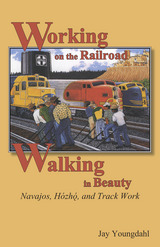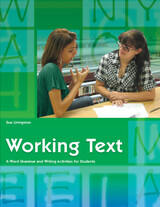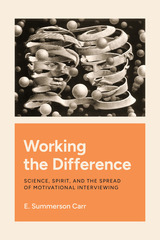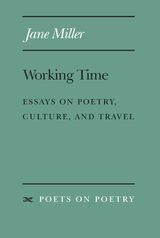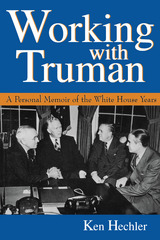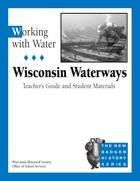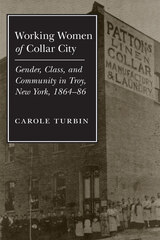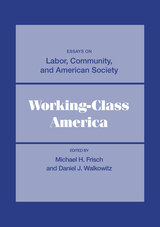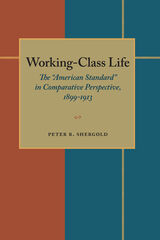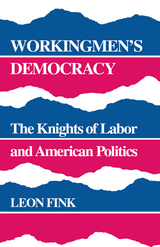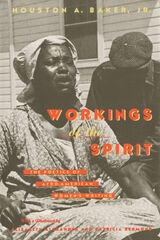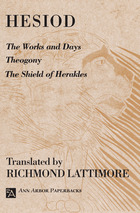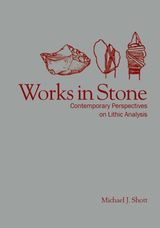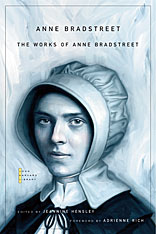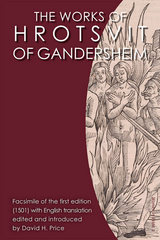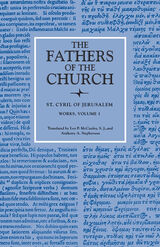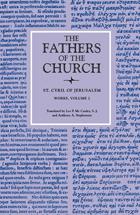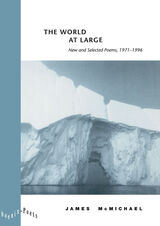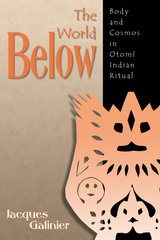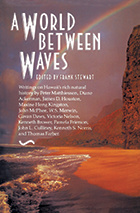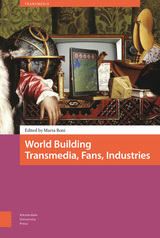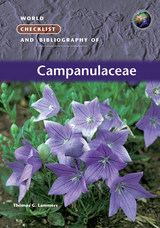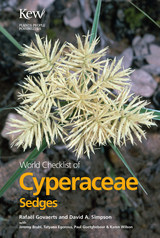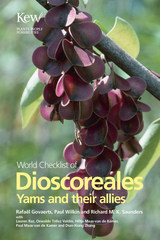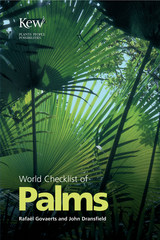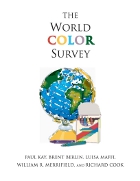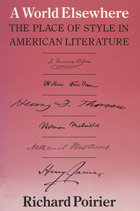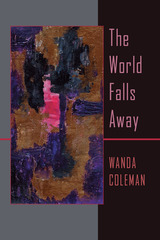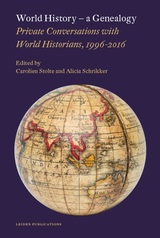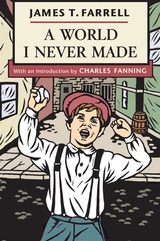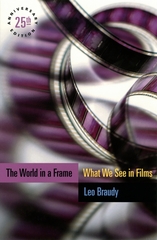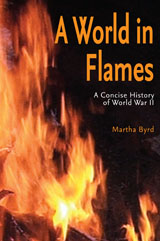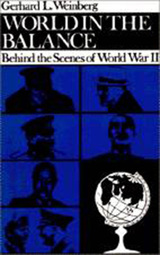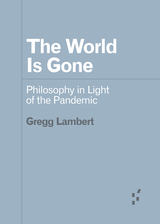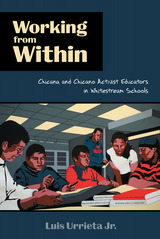 Working from Within: Chicana and Chicano Activist Educators in Whitestream Schools
Luis Urrieta Jr.
University of Arizona Press, 2009 Combining approaches from anthropology and cultural studies, Working from Within examines how issues of identity, agency, and social movements shape the lives of Chicana and Chicano activist educators in U.S. schools. Luis Urrieta Jr. skillfully utilizes the cultural concepts of positioning, figured worlds, and self-authorship, along with Chicano Studies and Chicana feminist frameworks, to tell the story of twenty-four Mexican Americans who have successfully navigated school systems as students and later as activist educators.
Working from Within is one of the first books to show how identity is linked to agency—individually and collectively—for Chicanas and Chicanos in education. Urrieta set out to answer linked questions: How do Chicanas and Chicanos negotiate identity, ideology, and activism within educational institutions that are often socially, culturally, linguistically, emotionally, and psychologically alienating? Analyzing in-depth interviews with twenty-four educators, Urrieta offers vivid narratives that show how activist identities are culturally produced through daily negotiations.
Urrieta’s work details the struggles of activist Chicana and Chicano educators to raise consciousness in a wide range of educational settings, from elementary schools to colleges. Overall, Urrieta addresses important questions about what it means to work for social justice from within institutions, and he explores the dialogic spaces between the alternatives of reproduction and resistance. In doing so, he highlights the continuity of Chicana and Chicano social movement, the relevance of gender, and the importance of autochthonous frameworks in understanding contemporary activism. Finally, he shows that it is possible for minority activist educators to thrive in a variety of institutional settings while maintaining strong ties to their communities.
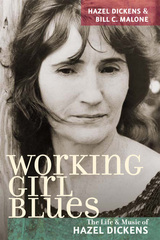 Working Girl Blues: The Life and Music of Hazel Dickens
Hazel Dickens and Bill C. Malone
University of Illinois Press, 2007 Hazel Dickens was an Appalachian singer and songwriter known for her superb musicianship, feminist country songs, union anthems, and blue-collar laments. Growing up in a West Virginia coal mining community, she drew on the mountain music and repertoire of her family and neighbors when establishing her own vibrant and powerful vocal style that is a trademark in old-time, bluegrass, and traditional country circles. Working Girl Blues presents forty original songs that Hazel Dickens wrote about coal mining, labor issues, personal relationships, and her life and family in Appalachia. Conveying sensitivity, determination, and feistiness, Dickens comments on each song, explaining how she came to write them and what they meant and continue to mean to her. Bill C. Malone's introduction traces Dickens's life, musical career, and development as a songwriter, In addition, Working Girl Blues features forty-one illustrations and a detailed discography of Dickens's commercial recordings.
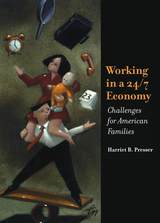 Working in a 24/7 Economy: Challenges for American Families
Harriet B. Presser
Russell Sage Foundation, 2003 An economy that operates 24/7—as ours now does—imposes extraordinary burdens on workers. Two-fifths of all employed Americans work mostly during evenings, nights, weekends, or on rotating shifts outside the traditional 9-to-5 work day. The pervasiveness of nonstandard work schedules has become a significant social phenomenon, with important implications for the health and well-being of workers and their families. In Working in a 24/7 Economy, Harriet Presser looks at the effects of nonstandard work schedules on family functioning and shows how these schedules disrupt marriages and force families to cobble together complex child-care arrangements that should concern us all. The number of hours Americans work has received ample attention, but the issue of which hours—or days—Americans work has received much less scrutiny. Working in a 24/7 Economy provides a comprehensive overview of who works nonstandard schedules and why. Presser argues that the growth in women's employment, technological change, and other demographic changes over the past thirty years gave rise to the growing demand for late-shift and weekend employment in the service sector. She also demonstrates that most people who work these hours do so primarily because it is a job requirement, rather than a choice based on personal considerations. Presser shows that the consequences of working nonstandard schedules often differ for men and women since housework and child-rearing remain assigned primarily to women even when both spouses are employed. As with many other social problems, the burden of these schedules disproportionately affects the working poor, reflecting their lack of options in the workplace and adding to their disadvantage. Presser also documents how such work arrangements have created a new rhythm of daily life within many American families, including those with two earners and absent fathers. With spouses often not at home together in the evenings or nights, and parents often not at home with their children at such times, the relatively new concept of "home-time" has emerged as primary concern for families across the nation. Employing a wealth of empirical data, Working in a 24/7 Economy shows that nonstandard work schedules are both highly prevalent among American families and generate a level of complexity in family functioning that demands greater public attention. Presser makes a convincing case for expanded research and meaningful policy initiatives to address this growing social phenomenon.
 Working In America: A Humanities Reader
Robert Sessions
University of Notre Dame Press, 1992 Caught in the whirlwind of the postindustrial revolution, many members of today’s labor force look upon the changing job landscape and feel displaced and devalued. Robert Sessions and Jack Wortman have compiled this selection of humanities readings to explore the many ways that work shapes and defines us, and to anticipate the ever-changing demands of the contemporary workplace. Although the humanities approach to studying work offers no predictions, statistics, or prognostications, it provides images and visions that aid in understanding the multiple meanings, values, and effects of work. Working in America is organized into three sections. Section I examines in detail the personal dimensions that underlie our experiences of work. Its purpose is to help the reader imagine, conceptualize, and deal with issues concerning work. Here the focus is on immediate experiences of work. Section II is concerned with broader social and historical questions and offers a brief look at some of the historical foundations (ancient Greece, medieval Europe, modern times) of contemporary work. Section III presents images of working from other cultures that will challenge the reader to imagine what work will be like in the coming decade—how it will affect our identities and personalities—based on our knowledge of the past and our view of other cultures.
 Working in group care: Social work and social care in residential and day care settings
Adrian Ward
Bristol University Press, 2007 Working in group care (ie residential and day services) is a challenging and complex task, demanding great skill, patience, knowledge and understanding. This book explains how the best practice can be achieved through the focused and engaged work of individuals and teams who are well supported and managed. Detailed attention is paid to the value of everyday practice and its underlying principles.The book brings together theory, practice and research findings from across the whole field of group care for all user-groups - including health, education and probation settings as well as social work and social care. The first edition was warmly welcomed as 'well organised and accessible ... and a valuable addition to the literature' (British Journal of Social Work). This second edition is updated and expanded, including new material on the concept of 'opportunity-led work'.The book will be an essential text for all those involved in residential and day care practice whether as practitioners, students, managers or trainers. It argues strongly for seeing group care as valuable and skilled work and for a holistic understanding of good practice.
 Working in Music on the Semiperiphery: Local Cultural Production and Global Capitalism
Emília Barna
Central European University Press, 2025 While music as labor feeds into the capitalist cultural industries, this book proves that in this sector informality greatly permeates and governs power relations and the allocations of resources. The significant level of informal involvement of the household in the creative and reproductive processes is also explored. It is particularly in the semiperipheral context that the relationship between home-based work and paid work is unbalanced: Emília Barna's field data are from Hungary and range from 2018 to 2021. The same context also implies considerable involvement of the state and its subsidies, as well as the important role of gatekeepers’ political capital.
This book embraces the widest possible range of workers in the music industry. It deals with all music genres from high-flying to commercial and observes various workers in the production chain beyond musicians. Niche segments of the sector, such as YouTube-based commercial hip hop, are given special treatment. Using a variety of empirical research methods, the study examines the trends as workers are pushed towards digital entrepreneurship and platform work, on the one hand, and live performance, on the other. The focus on domestic work and informality offers a feminist analysis of work in music. This approach sheds light on gendered divisions of labor and forms of (self-)exploitation that usually remain invisible. The book proposes a new model of cultural autonomy that takes account of the semiperipheral relationship of music industry workers and institutions to both the market and the state.
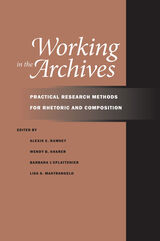 Working in the Archives: Practical Research Methods for Rhetoric and Composition
Edited by Alexis E. Ramsey, Wendy B. Sharer, Barbara L'Eplattenier, Lisa S. Mastrangelo
Southern Illinois University Press, 2010 Archival research of any magnitude can be daunting. With this in mind, Alexis E. Ramsey, Wendy B. Sharer, Barbara L’Eplattenier, and Lisa Mastrangelo have developed an indispensable volume for the first-time researcher as well as the seasoned scholar. Working in the Archives is a guide to the world of rhetoric and composition archives, from locating an archival source and its materials to establishing one’s own collection of archival materials. This practical volume provides insightful information on a variety of helpful topics, such as basic archival theory, processes, and principles; the use of hidden or digital archives; the intricacies of searching for and using letters and photographs; strategies for addressing the dilemmas of archival organization without damaging the provenance of materials; the benefits of seeking sources outside academia; and the difficult (yet often rewarding) aspects of research on the Internet. Working in the Archives moves beyond the basics to discuss the more personal and emotional aspects of archival work through the inclusion of interviews with experienced researchers such as Lynée Lewis Gaillet, Peter Mortensen, Kathryn Fitzgerald, Kenneth Lindblom, and David Gold. Each shares his or her personal stories of the joys and challenges that face today’s researchers. Packed with useful recommendations, this volume draws on the knowledge and experiences of experts to present a well-rounded guidebook to the often winding paths of academic archival investigation. These in-depth yet user-friendly essays provide crucial answers to the myriad questions facing both fledgling and practiced researchers, making Working in the Archives an essential resource.
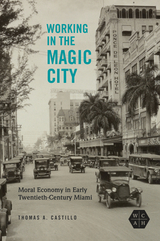 Working in the Magic City: Moral Economy in Early Twentieth-Century Miami
Thomas A. Castillo
University of Illinois Press, 2022 In the early twentieth century, Miami cultivated an image of itself as a destination for leisure and sunshine free from labor strife. Thomas A. Castillo unpacks this idea of class harmony and the language that articulated its presence by delving into the conflicts, repression, and progressive grassroots politics of the time. Castillo pays particular attention to how class and race relations reflected and reinforced the nature of power in Miami. Class harmony argued against the existence of labor conflict, but in reality obscured how workers struggled within the city's service-oriented seasonal economy. Castillo shows how and why such an ideal thrived in Miami’s atmosphere of growth and boosterism and amidst the political economy of tourism. His analysis also presents class harmony as a theoretical framework that broadens our definitions of class conflict and class consciousness.
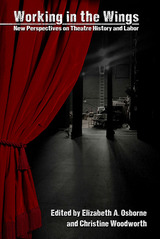 Working in the Wings: New Perspectives on Theatre History and Labor
Edited by Elizabeth A. Osborne and Christine Woodworth
Southern Illinois University Press, 2015 Theatre has long been an art form of subterfuge and concealment. Working in the Wings: New Perspectives on Theatre History and Labor, edited by Elizabeth A. Osborne and Christine Woodworth, brings attention to what goes on behind the scenes, challenging, and revising our understanding of work, theatre, and history. Essays consider a range of historic moments and geographic locations—from African Americans’ performance of the cakewalk in Florida’s resort hotels during the Gilded Age to the UAW Union Theatre and striking automobile workers in post–World War II Detroit, to the struggle in the latter part of the twentieth century to finish an adaptation of Moby Dick for the stage before the memory of creator Rinde Eckert failed. Contributors incorporate methodologies and theories from fields as diverse as theatre history, work studies, legal studies, economics, and literature and draw on traditional archival materials, including performance texts and architectural structures, as well as less tangible material traces of stagecraft. Working in the Wings looks at the ways in which workers' identities are shaped, influenced, and dictated by what they do; the traces left behind by workers whose contributions have been overwritten; the intersections between the sometimes repetitive and sometimes destructive process of creation and the end result—the play or performance; and the ways in which theatre affects the popular imagination. This collected volume draws attention to the significance of work in the theatre, encouraging a fresh examination of this important subject in the history of the theatre and beyond.
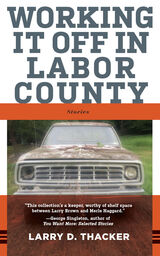 Working It Off in Labor County: Stories
Larry D. Thacker
West Virginia University Press, 2021 Humorous and wry stories of misfits and ordinary people in an Appalachian community struggling creatively to make sense of an often nonsensical world.
“It seems like everybody but people from here are sure about what we’re about, and they make money being wrong about it.” The residents of Labor County, a fictional small community in the mountains of southeastern Kentucky, may be short on cash, but they are rich in creativity and tirelessly inventive as they concoct new schemes to make ends meet, settle old scores, and work off their debts to society and, in a way, to themselves.
A zealous history professor is caught stealing from the local museum in protest of petty theft; an arsonist strikes it lucky—twice; a skilled leatherworker saddles a turkey and finds a rider; an angel aspires to be a punk rock Roller Derby princess; a grieving artist carves a miracle into a roadside rock face; and affable Uncle Archie produces a seemingly unending supply of new and bizarre items to display in his Odditorium.
More than a collection of tales, Working It Off in Labor County assembles memorable characters who recur across these seventeen linked stories, sharing in one another’s struggles and stumbling upon humor and mystery, the grotesque and the divine, each in many forms.
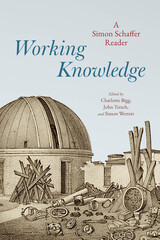 Working Knowledge: A Simon Schaffer Reader
Simon Schaffer
University of Chicago Press Collects key articles by Simon Schaffer, one of the most important historians of science working today.
Working Knowledge is the first English-language collection of essays by Simon Schaffer, coauthor of Leviathan and the Air-Pump, a landmark text in the history of science. Though the latter may be his most famous book, Schaffer is also renowned for seminal articles on Isaac Newton and the cultures of popular spectacle, nineteenth-century physics and its practices of labor discipline and standardization, the history of anthropology and collecting, and the globe-spanning cultural interactions that have shaped modern science. Working Knowledge compiles these well-known pieces alongside newer selections, making them accessible in a single place and representing the huge scope and impact of Schaffer’s oeuvre.
The Reader divides sixteen of Schaffer’s articles across five thematic sections, which take up timely issues like the turn toward global histories of science; the intersection of science and capitalism; the interaction between bodies and machines; and the connection between science, politics, and the environment. Eight new essays by notable historians such as Adrian Johns, Lissa Roberts, and Steven Shapin bring Schaffer’s pieces into discussion with current scholarship. Illustrations and brief commentaries by Schaffer and the artist Adam Lowe, a longtime collaborator, are included throughout the volume.
Bringing together essential articles that were previously scattered across several publications, Working Knowledge is an insightful introduction to Schaffer and his ever-relevant writing.
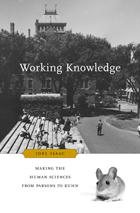 Working Knowledge: Making the Human Sciences from Parsons to Kuhn
Joel Isaac
Harvard University Press, 2012 The human sciences in the English-speaking world have been in a state of crisis since the Second World War. The battle between champions of hard-core scientific standards and supporters of a more humanistic, interpretive approach has been fought to a stalemate. Joel Isaac seeks to throw these contemporary disputes into much-needed historical relief. In Working Knowledge he explores how influential thinkers in the twentieth century's middle decades understood the relations among science, knowledge, and the empirical study of human affairs.
For a number of these thinkers, questions about what kinds of knowledge the human sciences could produce did not rest on grand ideological gestures toward "science" and "objectivity" but were linked to the ways in which knowledge was created and taught in laboratories and seminar rooms. Isaac places special emphasis on the practical, local manifestations of their complex theoretical ideas. In the case of Percy Williams Bridgman, Talcott Parsons, B. F. Skinner, W. V. O. Quine, and Thomas Kuhn, the institutional milieu in which they constructed their models of scientific practice was Harvard University. Isaac delineates the role the "Harvard complex" played in fostering connections between epistemological discourse and the practice of science. Operating alongside but apart from traditional departments were special seminars, interfaculty discussion groups, and non-professionalized societies and teaching programs that shaped thinking in sociology, psychology, anthropology, philosophy, science studies, and management science. In tracing this culture of inquiry in the human sciences, Isaac offers intellectual history at its most expansive.
Working Knowledge: Skill and Community in a Small Shop
Douglas Harper
University of Chicago Press, 1987 A number of years ago, Douglas Harper moved to northern New York to teach in a small college. Upon his arrival there his department chairman noted his eight-year-old Saab and said, "You'll be meeting Willie." Haper spent the next years establishing not only a working relationship but a friendship with Willie. In Working Knowledge, he introduces us to Willie, a mechanic and jack-of-all-trades. With this engaging and insightful profile—part biography, part ethnography, and part photo essay—Harper documents what Willie does and how he does it. Harper's dignified portrait captures a disappearing feature of modern life—the essential human factor in the world of work.
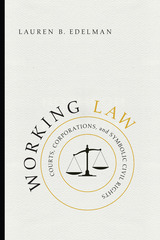 Working Law: Courts, Corporations, and Symbolic Civil Rights
Lauren B. Edelman
University of Chicago Press, 2016 Since the passage of the Civil Rights Act, virtually all companies have antidiscrimination policies in place. Although these policies represent some progress, women and minorities remain underrepresented within the workplace as a whole and even more so when you look at high-level positions. They also tend to be less well paid. How is it that discrimination remains so prevalent in the American workplace despite the widespread adoption of policies designed to prevent it?
One reason for the limited success of antidiscrimination policies, argues Lauren B. Edelman, is that the law regulating companies is broad and ambiguous, and managers therefore play a critical role in shaping what it means in daily practice. Often, what results are policies and procedures that are largely symbolic and fail to dispel long-standing patterns of discrimination. Even more troubling, these meanings of the law that evolve within companies tend to eventually make their way back into the legal domain, inconspicuously influencing lawyers for both plaintiffs and defendants and even judges. When courts look to the presence of antidiscrimination policies and personnel manuals to infer fair practices and to the presence of diversity training programs without examining whether these policies are effective in combating discrimination and achieving racial and gender diversity, they wind up condoning practices that deviate considerably from the legal ideals.
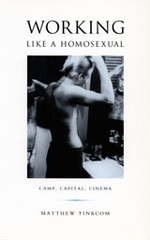 Working Like a Homosexual: Camp, Capital, Cinema
Matthew Tinkcom
Duke University Press, 2002 What does camp have to do with capitalism? How have queer men created a philosophy of commodity culture? Why is cinema central to camp? With chapters on the films of Vincente Minnelli, Andy Warhol, Kenneth Anger, and John Waters, Working Like a Homosexual responds to these questions by arguing that post–World War II gay male subcultures have fostered their own ways not only of consuming mass culture but of producing it as well.
With a special emphasis on the tensions between high and low forms of culture and between good and bad taste, Matthew Tinkcom offers a new vision of queer politics and aesthetics that is critically engaged with Marxist theories of capitalist production. He argues that camp—while embracing the cheap, the scorned, the gaudy, the tasteless, and what Warhol called “the leftovers” of artistic production—is a mode of intellectual production and a critical philosophy of modernity as much as it is an expression of a dissident sex/gender difference. From Minnelli’s musicals and the “everyday glamour” of Warhol’s films to Anger’s experimental films and Waters’s “trash aesthetic,” Tinkcom demonstrates how camp allowed these gay men to design their own relationship to labor and to history in a way that protected them from censure even as they struggled to forge a role for themselves within a system of “value” that failed to recognize them.
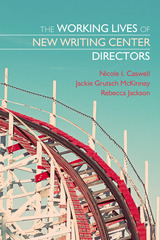 The Working Lives of New Writing Center Directors
Nicole I. Caswell
Utah State University Press, 2016 The first book-length empirical investigation of writing center directors’ labor, The Working Lives of New Writing Center Directors presents a longitudinal qualitative study of the individual professional lives of nine new directors. Inspired by Kinkead and Harris’s Writing Centers in Context (1993), the authors adopt a case study approach to examine the labor these directors performed and the varied motivations for their labor, as well as the labor they ignored, deferred, or sidelined temporarily, whether or not they wanted to. The study shows directors engaged in various types of labor—everyday, disciplinary, and emotional—and reveals that labor is never restricted to a list of job responsibilities, although those play a role. Instead, labor is motivated and shaped by complex and unique combinations of requirements, expectations, values, perceived strengths, interests and desires, identities, and knowledge. The cases collectively distill how different institutions define writing and appropriate resources to writing instruction and support, informing the ongoing wider cultural debates about skills (writing and otherwise), the preparation of educators, the renewal/tenuring of educators, and administrative “bloat” in academe. The nine new directors discuss more than just their labor; they address their motivations, their sense of self, and their own thoughts about the work they do, facets of writing center director labor that other types of research or scholarship have up to now left invisible. The Working Lives of New Writing Center Directors strikes a new path in scholarship on writing center administration and is essential reading for present and future writing center administrators and those who mentor them.
 Working Mandarin for Beginners: , Student's Edition
Yi Zhou with M. Lynne Gerber
Georgetown University Press Working Mandarin for Beginners is designed to enable English-speaking business students and professionals with no prior knowledge of Chinese to develop the basic communication skills necessary for a business trip to China or another work environment in which Mandarin is spoken. Major features: • Twenty-four lessons, including five review lessons • Clear objectives for acquiring language skills, grammar, and cultural understanding • Lessons cover important basics such as introductions and greetings, counting, reserving a hotel room, taking public transportation, and asking for directions • Lessons cover business tasks such as coordinating and conducting meetings, selling products, and negotiating agreements—all in Chinese • Lessons provide dialogues and vocabulary lists for reading and listening, language points, cultural points, pronunciation drills, grammar, and interactive homework • Course concludes with a special independent project in which the student applies the language to his or her area of business study • Pinyin is used throughout so students can start speaking Mandarin immediately • Includes some basic lessons in the formation of Chinese characters • Course can be combined with affordable online access to self-grading exercises (available through Quia.com, $24.95 per student for 18 months of access) Student Book • Includes MP3 tracks of dialogues, vocabulary lists, and audio exercises on CD • Lessons are valuable to the classroom student as well as self-directed independent learners Teacher's Edition • Includes a CD-ROM with all MP3 tracks of dialogues, vocabulary, and audio exercises found on the students' disk • CD-ROM also provides quizzes and exams (including necessary audio), approximately 300 supplementary PowerPoint slides for classroom use, and creative guidance for conversation practice, mini-immersion, and skit Online teaching features at Quia.com • Instructor-managed class activities and exercises • Monitoring of student progress • Customized grading options online • Students can complete exercises online, submit their answers electronically to their instructor, and receive automatic feedback • Teachers can also use Quia templates to build their own exercises or use exercises developed by other instructors to provide added help for students • Motivated self-directed learners can also access the self-grading online exercises at Quia.com (no instructor feedback will be provided) SYSTEM REQUIREMENTS Student's Edition Textbook/MP3 CD (Mac and PC) • CD drive on a computer or conventional CD player with MP3 capability • MP3 player, such as iTunes, RealPlayer, or Windows Media Player • Speakers Teacher's Edition Textbook/CD-ROM Mac and PC • CD drive on a computer • MP3 player, such as iTunes, RealPlayer, or Windows Media Player • speakers • Adobe Acrobat Reader (available as a free download from http:///www.adobe.com) PC • Windows XP • Microsoft Office 2000 or higher with Service Pack 3 installed (Word and PowerPoint are needed to view and edit some files) • Or, to view the PowerPoints only, download Microsoft PowerPoint Viewer 2003 or higher (free from http://www.microsoft.com) • Fonts for PowerPoints: Arial Unicode and Simsun, which are included in all editions of Office 2000/XP/2003 Mac • Microsoft Word, version Office 2004 or higher • Microsoft PowerPoint, version Office 2004 or higher (Word and PowerPoint are needed to view and edit some files); or view the PowerPoints as PDFs • Fonts for PowerPoints: Arial and Simsun, which are included in Office 2004 and higher Interactive Exercises on Quia (Mac and PC) • Computer with Internet access, preferably a high-speed connection • Java-enabled browser: Internet Explorer 5 or higher, or any version of Firefox or Safari • The program QuickTime (available as a free download from http://www.quicktime.com) • Microphone to record answers or responses
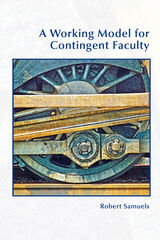 A Working Model for Contingent Faculty
Robert Samuels
University Press of Colorado, 2023 In A Working Model for Contingent Faculty, Robert Samuels offers an outline of fair and effective practices for improving the working conditions of faculty in precarious positions. Drawing on more than twenty years of union activism and university teaching, Samuels examines programs, policies, and practices that work for non-tenure-track faculty in the University of California system. His detailed analysis of facts on the ground offers a foundation upon which faculty in contingent positions can build arguments for improved working conditions. Throughout the book, Samuels focuses on the central issues of academic freedom, job security, compensation, shared governance, evaluation and promotion, benefits, and dispute resolution as well as critical but less often addressed concerns such as funding for professional development family leave policies, technology training, and summer teaching. A Working Model, as a result, offers resources that can support progress well beyond the University of California system.
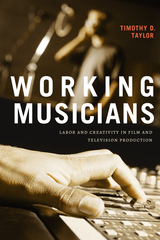 Working Musicians: Labor and Creativity in Film and Television Production
Timothy D. Taylor
Duke University Press, 2023 In Working Musicians Timothy D. Taylor offers a behind-the-scenes look at the labor of the mostly unknown composers, music editors, orchestrators, recording engineers, and other workers involved in producing music for films, television, and video games. Drawing on dozens of interviews with music workers in Los Angeles, Taylor explores the nature of their work and how they understand their roles in the entertainment business. Taylor traces how these cultural laborers have adapted to and cope with the conditions of neoliberalism as, over the last decade, their working conditions have become increasingly precarious. Digital technologies have accelerated production timelines and changed how content is delivered, while new pay schemes have emerged that have transformed composers from artists into managers and paymasters. Taylor demonstrates that as bureaucratization and commercialization affect every aspect of media, the composers, musicians, music editors, engineers, and others whose soundtracks excite, inspire, and touch millions face the same structural economic challenges that have transformed American society, concentrating wealth and power in fewer and fewer hands.
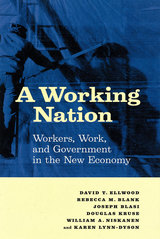 A Working Nation: Workers, Work, and Government in the New Economy
David T. Ellwood
Russell Sage Foundation, 2000 The nature of work in the United States is changing dramatically, as new technologies, a global economy, and more demanding investors combine to create a far more competitive marketplace. Corporate efforts to respond to these new challenges have yielded mixed results. Headlines about instant millionaires and innovative e-businesses mingle with coverage of increasing job insecurity and record wage gaps between upper management and hourly workers. A Working Nation tracks the profound implications the changing workplace has had for all workers and shows who the real economic winners and losers have been in the past twenty-five years. A Working Nation sorts fact from fiction about the new relationship between workers and firms, and addresses several critical issues: Who are the real winners and losers in this new economy? Has the relationship between workers and firms really been transformed? How have employees become more integrated into or disconnected from corporate strategies and performance? Should government step into this new economic reality and how should it intervene? Among the topics investigated, David T. Ellwood explores and explains the apparent paradox between the steady rise in per capita national income and the stagnant wages of middle- and working-class workers. Douglas Kruse and Joseph Blasi study relative changes in long-term vs. temporary work, and evaluate the introduction of profit-sharing schemes and high performance workplace programs. William A. Niskanen and Rebecca M. Blank, both former members of the president's Council of Economic Advisers, offer their perspectives on what direction government might take to make this a working nation for everyone. Though Niskanen and Blank take alternative approaches, they both conclude that the primary policy emphasis ought to be on the problems of the least skilled more than on inequality per se, and that a focus on childhood education and tax supports for low-income working families should be of primary concern. A Working Nation paints a compelling and surprisingly consistent picture of today's workplace. While the booming economy has created millions of new jobs, it has also lead to an alarmingly unbalanced system of rewards that puts less-skilled, and many middle-class, workers at risk. This book is essential reading for those seeking the most efficient answers to the challenges and opportunities of the evolving economy.
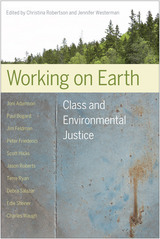 Working on Earth: Class and Environmental Justice
Christina Robertson
University of Nevada Press, 2015 This collection of essays examines the relationship between environmental injustice and the exploitation of working-class people. Twelve scholars from the fields of environmental humanities and the humanistic social sciences explore connections between the current and unprecedented rise of environmental degradation, economic inequality, and widespread social injustice in the United States and Canada.
The authors challenge prevailing cultural narratives that separate ecological and human health from the impacts of modern industrial capitalism. Essay themes range from how human survival is linked to nature to how the use and abuse of nature benefit the wealthy elite at the expense of working-class people and the working poor as well as how climate change will affect cultures deeply rooted in the land.
Ultimately, Working on Earth calls for a working-class ecology as an integral part of achieving just and sustainable human development.
Working on the Railroad, Walking in Beauty: Navajos, Hozho, and Track Work
Jay Youngdahl
Utah State University Press, 2011 For over one hundred years, Navajos have gone to work in significant numbers on Southwestern railroads. As they took on the arduous work of laying and anchoring tracks, they turned to traditional religion to anchor their lives. Jay Youngdahl, an attorney who has represented Navajo workers in claims with their railroad employers since 1992 and who more recently earned a master's in divinity from Harvard, has used oral history and archival research to write a cultural history of Navajos' work on the railroad and the roles their religious traditions play in their lives of hard labor away from home.
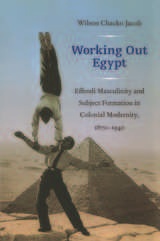 Working Out Egypt: Effendi Masculinity and Subject Formation in Colonial Modernity, 1870–1940
Wilson Chacko Jacob
Duke University Press, 2011 Working Out Egypt is both a rich cultural history of the formation of an Egyptian national subject in the late nineteenth century and early twentieth and a compelling critique of modern Middle Eastern historiography. Wilson Chacko Jacob describes how Egyptian men of a class akin to the cultural bourgeoisie (the effendiyya) struggled to escape from the long shadow cast by colonial depictions of the East as degenerate, feminine, and temporally behind an active and virile Europe. He argues that during British colonial rule (1882–1936), attempts to create a distinctively modern and Egyptian self free from the colonial gaze led to the formation of an ambivalent, performative subjectivity that he calls “effendi masculinity.” Jacob traces effendi masculinity as it took hold during the interwar years, in realms from scouting and competitive sports to sex talk and fashion, considering its gendered performativity in relation to a late-nineteenth-century British discourse on masculinity and empire and an explicitly nationalist discourse on Egyptian masculinity. He contends that as an assemblage of colonial modernity, effendi masculinity was simultaneously local and global, national and international, and particular and universal. Until recently, modern Egyptian history has not allowed for such paradoxes; instead, Egyptian modernity has been narrated in the temporal and spatial terms of a separate Western modernity.
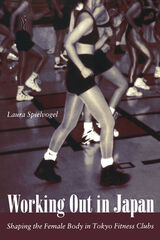 Working Out in Japan: Shaping the Female Body in Tokyo Fitness Clubs
Laura Spielvogel
Duke University Press, 2003 Beer, ice cream, and socializing; thighs, abs, and pecs—Japanese fitness clubs combine entertainment and exercise, reflecting the Japanese concept of fitness as encompassing a zest for life as well as physical health. Through an engaging account of these clubs, Working Out in Japan reveals how beauty, bodies, health, and leisure are understood and experienced in Japan today. An aerobics instructor in two of Tokyo’s most popular fitness club chains from 1995 to 1997, Laura Spielvogel captures the diverse voices of club members, workers, and managers; women and men; young and old.
Fitness clubs have proliferated in Japanese cities over the past decade. Yet, despite the pervasive influence of a beauty industry that values thinness above all else, they have met with only mixed success . Exploring this paradox, Spielvogel focuses on the tensions and contradictions within the world of Japanese fitness clubs and on the significance of differences between Japanese and North American philosophies of mind and body. Working Out in Japan explores the ways spaces and bodies are organized and regulated within the clubs, the frustrations of female instructors who face various gender inequities, and the difficult demands that the ideal of slimness places on Japanese women. Spielvogel’s vivid investigation illuminates not only the fitness clubs themselves, but also broader cultural developments including the growth of the service industry and the changing character of work and leisure in Japan.
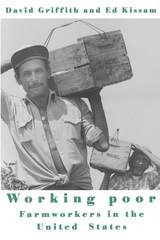 Working Poor: Farmworkers in the United States
David Griffith
Temple University Press, 1995 Working Poor investigates the lives and working conditions of migrant farmworkers in seven regions of the United States. The community studies in this volume include descriptions and analyses of the low-income neighborhoods of Immokalee, Florida; Parlier, California; Weslaco, Texas; and Mayagüez, Puerto Rico, where growers and farm contractors put immigrants to work in fruit and vegetable harvests. The authors link farmworker communities that have winter growing seasons with summer labor supply demand regions in the northern United States, in particular south-western Michigan, New Jersey, and the Delmarva Peninsula of Maryland and Delaware. The authors investigate ethnic succession in the farm labor market and the ways individual farmworkers, farmworker families, and networks organize these migrations and attach themselves to farming operations by a variety of social relations. Framing the portraits of crowded households, the histories of networks, and the ethnic vignettes are three chapters placing the community studies into historical and theoretical perspectives. This broad framework underscores the importance of housing, transportation, networks, labor contracts, and ethnic relations in the organization of low-wage labor markets.
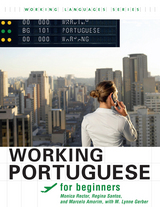 Working Portuguese for Beginners: , Student's Edition
Monica Rector, Regina Santos, and Marcelo Amorim, with M. Lynne Gerber
Georgetown University Press, 2010 Working Portuguese for Beginners enables English speakers with no prior knowledge of Brazilian Portuguese to develop the basic communication skills and cultural knowledge needed to visit Brazil and to function in a work environment in which Portuguese is spoken. This language program presents not only all the situations and grammar normally covered in an elementary Portuguese textbook but also includes situations set in a business context in every lesson. Major Features:• Twenty-four lessons, the last four concluding with a special independent project in which the student applies the language to his or her area of professional interest• Clear objectives for acquiring language skills, grammar, and cultural understanding• Lessons cover the important basics normally covered in any beginning Portuguese textbook such as introductions and greetings, counting, making travel plans, taking public transportation, and asking for directions• Lessons cover business tasks such as negotiating a contract, presenting a new product, writing a business memo—all in Brazilian Portuguese• Lessons provide dialogues and vocabulary lists for reading and listening, grammar, cultural reading, and interactive homework• Portuguese-English and English-Portuguese glossaries offer additional help with vocabulary• Course can be combined with affordable online access to self-grading exercises (available through Quia.com, $24.95 per student for 18 months of access) Student’s Book• Includes MP3 tracks of vocabulary, dialogues, and audio exercises on CD• Lessons are valuable to the classroom student as well as self-directed independent learners Teacher’s Edition• Includes a CD-ROM with all MP3 tracks of vocabulary, dialogues, and audio exercises found on the student’s disk• CD-ROM also provides quizzes and a midterm, materials for special activities, and approximately 300 supplementary PowerPoint slides for classroom presentation Online teaching features at Quia.com • Instructor-managed class activities and exercises • Monitoring of student progress • Customized grading options online • Students can complete exercises online, submit their answers electronically to their instructor, and receive automatic feedback • Teachers can also use Quia templates to build their own exercises or use exercises developed by other instructors to provide added help for students • Motivated self-directed learners can also access the self-grading online exercises at Quia.com (no instructor feedback will be provided) SYSTEM REQUIREMENTS System Requirements for Student's Edition Textbook Disk• Windows 2000 or later or Mac OS 10.2 or later• DVD-ROM drive on a computer or conventional DVD-ROM with MP3 player• Sound card and speakers or earphones for audio• An MP3 player, such as Windows Media Player or iTunes (available as a free download) System Requirements for Teacher's Edition Textbook DVD-ROM • Windows 2000 or later (including Windows XP, Windows Vista, Windows 7) or Mac OS 10.2 or later (including OS X 10.3, 10.4, 10.5, 10.6)• DVD-ROM drive• Sound card and either speakers or earphones (for MP3 files)• For PCs, Microsoft Word 2000 or later or for Macs, Microsoft Word X or later (for .doc files)• For PCs: PowerPoint 2000 or later (to edit PowerPoint PPT files) or to view PowerPoints only, PowerPoint Viewer 2003 or higher (available as a free download from www.microsoft.com); for Macs: PowerPoint X or later (for PowerPoint files)• An MP3 player, such as Windows Media Player or iTunes (available, respectively, as a free download from www.microsoft.com and www.itunes.com)• For PCs, Adobe Acrobat or Reader 9 or later, or for Macs Adobe Acrobat or Reader 6.0 or later (Adobe Reader is available as a free download from www.adobe.com) System Requirements for the Online Exercises (Mac and PC)• Computer with Internet access, preferably a high-speed connection• Java-enabled browser: PC: Internet Explorer 6.x or higher, or Firefox 3.x or higherMac: Firefox 3.x or higher, or Safari 3.x or higher• The program QuickTime (available as a free download from http://www.quicktime.com) is needed to play audio• Speakers or headphones to hear audio• Microphone to record answers or responses
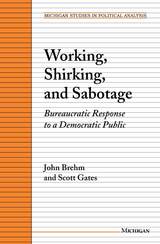 Working, Shirking, and Sabotage: Bureaucratic Response to a Democratic Public
John Brehm and Scott Gates
University of Michigan Press, 1999 Bureaucrats perform most of the tasks of government, profoundly influencing the daily lives of Americans. But who, or what, controls what bureaucrats do?
John Brehm and Scott Gates examine who influences whether federal, state, and local bureaucrats work, shirk, or sabotage policy. The authors combine deductive models and computer simulations of bureaucratic behavior with statistical analysis in order to assess the competing influences over how bureaucrats expend their efforts. Drawing upon surveys, observational studies, and administrative records of the performance of public employees in a variety of settings, Brehm and Gates demonstrate that the reasons bureaucrats work as hard as they do include the nature of the jobs they are recruited to perform and the influence of both their fellow employees and their clients in the public. In contrast to the conclusions of principal-agency models, the authors show that the reasons bureaucrats work so hard have little to do with the coercive capacities of supervisors.
This book is aimed at students of bureaucracy and organizations and will be of interest to researchers in political science, economics, public policy, and sociology.
"This book is breathtaking in its use of models and techniques. . . . The approach developed by Brehm and Gates allows us to re-open empirical questions that have lain dormant for years." --Bryan D. Jones, University of Washington
John Brehm is Associate Professor of Political Science, Duke University. Scott Gates is Associate Professor of Political Science, Michigan State University.
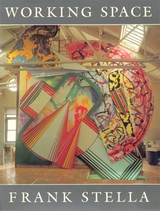 Working Space
Frank Stella
Harvard University Press, 1986 “A bombshell...this is a book that explodes many received ideas about abstraction...[It] is certainly one of the most remarkable books ever written on the subject. What makes it so remarkable, of course, is that Stella is unquestionably the most celebrated abstract painter of his generation.”—Hilton Kramer, Atlantic
Working Space affords a rare opportunity to view painting from the inside out, through the eyes of one of the world’s most prominent abstract painters. Frank Stella describes his perception of other artists’ work, as well as his own, in this handsomely illustrated volume.
Stella uses the crisis of representational art in sixteenth-century Italy to illuminate the crisis of abstraction in our time. The artists who followed Leonardo, Michelangelo, Raphael, and Titian searched for new directions to advance their work from beneath the shadow of these great painters. Caravaggio pointed the way. So today, Stella believes, the successors to Picasso, Kandinsky, and Pollock must seek a pictorial space as potent as the one Caravaggio developed at the beginning of the seventeenth century. Stella sees Caravaggio as the pivot on whom painting turns, his consummate illusionism prompting the advance of a more flexible, more “real” space that allows painting to move and breathe, to suggest extension and unrestricted motion. Following Caravaggio, Rubens’ broad vision of fullness and active volume gave painting a momentum that helped propel it into the nineteenth century, where it came to rest in the genius of Géricault and Manet, themselves the precursors of modern painting.
Unfortunately, both contemporary abstract art and figurative painting have become trapped by ambiguous pictorial space and by a misguided emphasis on materiality (pigment for pigment’s sake). Pictorial qualities have given way to illustrational techniques. Abstract art has become verbal, defensive, and critical, caught up in theology masquerading as theory. Stella asserts that painting must understand its past, make use of the lucid realism of seventeenth-century Italy, and absorb a Mediterranean physicality to reinforce the lean spirituality of northern abstraction pioneered by Mondrian and Malevich. Working Space will provoke discussion and argument, not least because Stella offers nontraditional evaluations of the works of giants such as Raphael, Titian, Michelangelo, Picasso, and Pollock, as well as lesser-known figures including Annibale Carracci, Paulus Potter, and Morris Louis. The artist’s powers of discernment and the profusion of his ideas and opinions will dazzle and engage professionals, amateurs, and students of art.
Working Text (Student Workbook): X-Word Grammar and Writing Activities for Students
Sue Livingston
Gallaudet University Press, 2010 Working Test: X-Word Grammar and Writing Activities for Students features 86 X-Word Grammar reading and writing exercises divided into five parts of increasing complexity. Deaf, second-language, and other students experiencing difficulty with English composition can perform these exercises as homework or as in-class activities. Through these exercises, they can master English grammar, improve their facility with language constructions, and meet the challenges of becoming better writers.
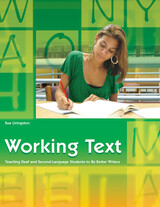 Working Text (Teacher's Guide): Teaching Deaf and Second-Language Students to Be Better Writers
Sue Livingston
Gallaudet University Press, 2010 After teaching developmental writing to deaf students for may years, Sue Livingston found that students who can read and analyze written texts become better writers. They achieve their improvement by reading, then writing about what they have read. Livingston has embodied her successful approach in Working Text: Teaching Deaf and Second-Language Students to Be Better Writers. In this straightforward instructional book, Livingston first explains what is involved and why her methods work with deaf students, second-language students, and other students who need to improve their writing ability. Upon this foundation, Working Text delineates how to teach students to write through reading and writing exercises. These exercises have been carefully crafted using the X-Word Grammar approach to help students discover common language constructions that they can apply to their own writing. As the students progress, their understanding of the elements of good writing will grow. Working Text also includes all of the exercises and appendices featured in the Working Test: X-Word Grammar and Writing Activities for Students workbook, both in print and on on a special CD. The answers for the exercises are included as well, as are sample quizzes, and the CD can be used in the classroom for interactive lessons in conjunction with the student workbook. Working Text: Teaching Deaf and Second-Language Students to Be Better Writers, in concert with its companion student workbook, will help deaf, second-language, and other students develop into markedly better, more confident writers.
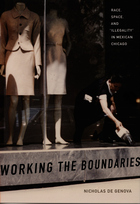 Working the Boundaries: Race, Space, and "Illegality" in Mexican Chicago
Nicholas De Genova
Duke University Press, 2005 While Chicago has the second-largest Mexican population among U.S. cities, relatively little ethnographic attention has focused on its Mexican community. This much-needed ethnography of Mexicans living and working in Chicago examines processes of racialization, labor subordination, and class formation; the politics of nativism; and the structures of citizenship and immigration law. Nicholas De Genova develops a theory of “Mexican Chicago” as a transnational social and geographic space that joins Chicago to innumerable communities throughout Mexico. “Mexican Chicago” is a powerful analytical tool, a challenge to the way that social scientists have thought about immigration and pluralism in the United States, and the basis for a wide-ranging critique of U.S. notions of race, national identity, and citizenship. De Genova worked for two and a half years as a teacher of English in ten industrial workplaces (primarily metal-fabricating factories) throughout Chicago and its suburbs. In Working the Boundaries he draws on fieldwork conducted in these factories, in community centers, and in the homes and neighborhoods of Mexican migrants. He describes how the meaning of “Mexican” is refigured and racialized in relation to a U.S. social order dominated by a black-white binary. Delving into immigration law, he contends that immigration policies have worked over time to produce Mexicans as the U.S. nation-state’s iconic “illegal aliens.” He explains how the constant threat of deportation is used to keep Mexican workers in line. Working the Boundaries is a major contribution to theories of race and transnationalism and a scathing indictment of U.S. labor and citizenship policies.
Working the Difference: Science, Spirit, and the Spread of Motivational Interviewing
E. Summerson Carr
University of Chicago Press, 2023 A history of motivational interviewing and what its rise reveals about how cultural forms emerge and spread.
Motivational interviewing (MI) is a professional practice, a behavioral therapy, and a self-professed conversation style that encourages clients to talk themselves into change. Originally developed to treat alcoholics, MI quickly spread into a variety of professional fields including corrections, medicine, and sanitation. In Working the Difference, E. Summerson Carr focuses on the training and dissemination of MI to explore how cultural forms—and particularly forms of expertise—emerge and spread. The result is a compelling analysis of the American preoccupations at MI’s core, from democratic autonomy and freedom of speech to Protestant ethics and American pragmatism.
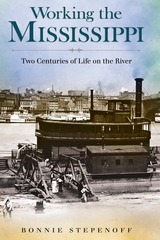 Working the Mississippi: Two Centuries of Life on the River
Bonnie Stepenoff
University of Missouri Press, 2015 The Mississippi River occupies a sacred place in American culture and mythology. Often called The Father of Rivers, it winds through American life in equal measure as a symbol and as a topographic feature. To the people who know it best, the river is life and a livelihood. River boatmen working the wide Mississippi are never far from land. Even in the dark, they can smell plants and animals and hear people on the banks and wharves. Bonnie Stepenoff takes readers on a cruise through history, showing how workers from St. Louis to Memphis changed the river and were in turn changed by it. Each chapter of this fast-moving narrative focuses on representative workers: captains and pilots, gamblers and musicians, cooks and craftsmen. Readers will find workers who are themselves part of the country’s mythology from Mark Twain and anti-slavery crusader William Wells Brown to musicians Fate Marable and Louis Armstrong.
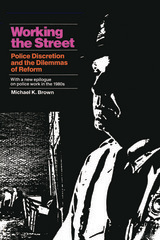 Working the Street: Police Discretion and the Dilemmas of Reform
Michael K. Brown
Russell Sage Foundation, 1981 Now available in paperback, this provocative study examines the street-level decisions made by police, caught between a sometimes hostile community and a maze of departmental regulations. Probing the dynamics of three sample police departments, Brown reveals the factors that shape how officers wield their powers of discretion. Chief among these factors, he contends, is the highly bureaucratic organization of the modern police department. A new epilogue, prepared for this edition, focuses on the structure and operation of urban police forces in the 1980s. "Add this book to the short list of important analyses of the police at work....Places the difficult job of policing firmly within its political, organizational, and professional constraints...Worth reading and thinking about." —Crime & Delinquency "An excellent contribution...Adds significantly to our understanding of contemporary police." —Sociology "A critical analysis of policing as a social and political phenomenon....A major contribution." —Choice
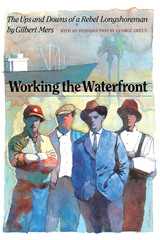 Working the Waterfront: The Ups and Downs of a Rebel Longshoreman
By Gilbert Mers
University of Texas Press, 1988 "Somebody said, 'History is written by the winners. The losers have nothing to say.' This book is by one of the losers, a bit player, not the star of the drama." So begins Gilbert Mers in these personal recollections of forty-two years on the Texas waterfront as longshoreman and radical union activist. But far from having "nothing to say," Mers reveals himself as a thoughtful philosopher of democratic ideals and eloquent agitator for union reform. He challenges the conventional wisdom that the leader is more valuable than the led. He contends that long tenure in positions of power dulls the union officer's working-class instincts. Always one to row against the current, Mers believes the union exists for the benefit of its members! This is primary material of the best kind, vivid and evocative, and Mers, in his eighties at the time of writing the book, is an unusually vigorous and articulate spokesman for a democratic and humane unionism. Whether he is describing the sweaty, dangerous and back-breaking work of loading cotton bales into the hold of an outbound ship or the gut-gripping tension of a face-to-face encounter with Texas Rangers bent on "law and order," Mers writes with the voice and conscience of the rank-and-file worker. He paints the waterfront world as it was, and perhaps still is—full of danger, humor, dignity in demoralizing circumstances, frustration, struggle, and sometimes hope—and tells his story with such wry humanity that even those who disagree with his destination will enjoy the ride.
Working Time: Essays on Poetry, Culture, and Travel
Jane Miller
University of Michigan Press, 1992 Working Time collects essays by prize-winning poet Jane Miller on the subjects of poetry, travel, and culture. The discussions of contemporary poetry begin with excursions into geography, where language literally “takes shape.” Each essay is set in a landscape, where the notion of travel as a poetic experience, from the American Southwest to places in Italy, France, and Spain, is explored.
The essays consider notions of time, duration, narrative, documentary, and history in American poetry, and view poetry in the light of developments in feminism, postmodern theory, and contemporary poetic practice. In addition to poetry, Miller investigates a range of cultural products and art forms, including film, video, photography, painting, sculpture, music, and the Madonna phenomenon.
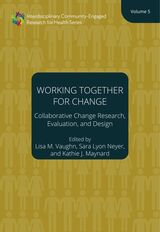 Working Together for Change: Collaborative Change Research, Evaluation, and Design, Volume 5
Edited by Lisa M. Vaughn, Sara Neyer, and Kathie Maynard
University of Minnesota Press, 2023 Strategies for engaging key stakeholders—evaluators, researchers, and designers—to discuss frameworks for promoting collaborative change.
Collaborative Change Research, Evaluation, and Design (CCRED) is a framework and collection of participatory practices that engage people and the systems around them to drive community outcomes. This framework emerged out of the recognition that deep participation (or engagement) is frequently missing in collaborative impact approaches. When collaborative change is implemented effectively, community members are viewed as valuable owners and experts instead of being seen as disinterested or unqualified partners.
CCRED is a social action process with dual goals of collective empowerment and the deepening of social knowledge. Executed successfully, CCRED has the potential to increase the rigor, reach, and relevance of research, evaluation, and design translated to meaningful action. Written in an easily accessible, narrative style, Working Together for Change, the fourth volume in the Interdisciplinary Community Engaged Research for Health series edited by Farrah Jacquez and Lela Svedin brings together evaluators, researchers, and designers to describe collaborative change by describing their own work in the space.
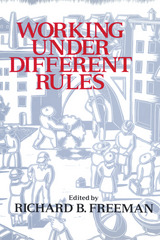 Working Under Different Rules
Richard B. Freeman
Russell Sage Foundation, 1994 For much of the 20th century, American workers were the world's leaders in productivity, wages, and positive workplace conditions. American unions championed free enterprise and high labor standards, and American businesses dominated the world market. But, as editor Richard B. Freeman cautions in Working Under Different Rules, despite our relatively high standard of living we have fallen behind our major trading partners and competitors in providing good jobs at good pay—what was once considered "the American dream." Working Under Different Rules assesses the decline in the well-being of American workers—evidenced by spiraling income inequality and stagnant real earnings—and compares our employment and labor conditions with those of Western Europe, Canada, Japan, and Australia. As these original essays demonstrate, the modern U.S. labor market is characterized by a high degree of flexibility, with rapid employee turnover, ongoing creation of new jobs, and decentralized wage setting practices. But closer inspection reveals a troubling flip side to this adaptability in the form of inadequate job training, more frequent layoffs, and increased numbers of workers pushed to the very bottom of the income scale, into the low wage occupations where much of the recent job growth has occurred. While the variety of works councils prevalent throughout the developed world have done much to foster democratic rights and economic protection for employees, the virtually union-free environment emerging in many areas of the private U.S. economy has stripped workers of a strong collective voice. German apprenticeship programs and the Japanese system of "job rotation" represent more effective approaches to preparing workers for the changing demands of lifetime employment. In addition, workers in European advanced economies and in Canada have greater social protection than Americans. But while this has some cost in unemployment and higher taxes, carefully designed social safety nets do not seriously jeopardize economic efficiency. Working Under Different Rules is an illuminating analysis of the often complex interaction of market institutions, social policy, and economic results. The authors' up-to-date international assessment of unions, wage setting, apprenticeship programs, welfare support, and works councils suggests alternate ways of training, paying, and empowering workers that, if effectively adapted, could facilitate the growth of a healthier American economy and better prospects for American workers.
 Working Watersheds: Water and Energy in the Lackawanna Valley
William Conlogue
Temple University Press, 2025 A personal narrative, an examination of literary texts, and a history of the Lackawanna Valley region, Bill Conlogue’s Working Watersheds explores how water has circulated in the former anthracite capital of the world. Conlogue not only recounts water’s use in anthracite mining and textile making, but also investigates its resulting pollution. He delves into the current natural gas boom, which threatens groundwater, and concludes with hopes of environmental renewal and restoration.
Offering a fresh way to think about the Anthropocene, this distinctive history of water and coal in the Lackawanna Valley discusses how both water abundance and scarcity might play out as global temperatures rise. Working Watersheds is designed to trigger debates about the nature of history, the significance of literature, and the importance of linking person, place, and planet in an era of climate change.
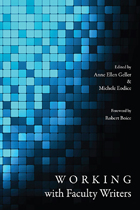 Working with Faculty Writers
Anne Ellen Geller and Michele Eodice
Utah State University Press, 2013 The imperative to write and to publish is a relatively new development in the history of academia, yet it is now a significant factor in the culture of higher education. Working with Faculty Writers takes a broad view of faculty writing support, advocating its value for tenure-track professors, adjuncts, senior scholars, and graduate students. The authors in this volume imagine productive campus writing support for faculty and future faculty that allows for new insights about their own disciplinary writing and writing processes, as well as the development of fresh ideas about student writing.
Contributors from a variety of institution types and perspectives consider who faculty writers are and who they may be in the future, reveal the range of locations and models of support for faculty writers, explore the ways these might be delivered and assessed, and consider the theoretical, philosophical, political, and pedagogical approaches to faculty writing support, as well as its relationship to student writing support.
With the pressure on faculty to be productive researchers and writers greater than ever, this is a must-read volume for administrators, faculty, and others involved in developing and assessing models of faculty writing support.
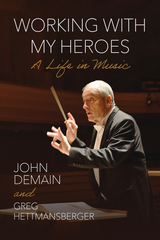 Working with My Heroes: A Life in Music
John L. DeMain and Greg Hettmansberger
University of Wisconsin Press, 2026 An internationally acclaimed Grammy and Tony Award–winning conductor, John DeMain has been a fixture of Madison, Wisconsin, for more than three decades, serving as music director of the Madison Symphony Orchestra and artistic director of the Madison Opera. In Working with My Heroes, written with the late Greg Hettmansberger, DeMain recounts incredible experiences—from his days studying piano in Youngstown, Ohio, to his years as an undergraduate and graduate student at Julliard, to his early jobs in summer stock productions, to his internationally acclaimed productions—without ever losing sight of the wonder and awe he felt as a young musician first learning his way in the world. With warmth and humor, he provides valuable insight into the business of music making, while also sharing behind-the-scenes stories of entertaining situations he found himself in throughout the years—from playing piano at a gangster’s wedding to conducting an opera with circus elephants.
DeMain has had many career-defining moments behind the podium, conducting world premieres of Leonard Bernstein’s A Quiet Place, John Adams’s Nixon in China, and Jeanine Tesori’s Blue, as well as the U.S. premiere of Philip Glass’s Akhnaten, among others. He has guest-conducted symphonies and operas in New York, Chicago, Los Angeles, and elsewhere, and cemented his reputation with the 1976 Houston Grand Opera performances of George and Ira Gershwin's Porgy and Bess, establishing its stature as a quintessentially American opera. The singers, musicians, and composers DeMain has worked with over the past six decades are a veritable Who’s Who of American classical music. This memoir places readers by his side, allowing them to experience all the wonders and joy of a life spent making music.
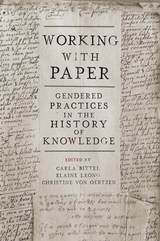 Working with Paper: Gendered Practices in the History of Knowledge
Carla Bittel
University of Pittsburgh Press, 2019 Working with Paper builds on a growing interest in the materials of science by exploring the gendered uses and meanings of paper tools and technologies, considering how notions of gender impacted paper practices and in turn how paper may have structured knowledge about gender. Through a series of dynamic investigations covering Europe and North America and spanning the early modern period to the twentieth century, this volume breaks new ground by examining material histories of paper and the gendered worlds that made them. Contributors explore diverse uses of paper—from healing to phrenological analysis to model making to data processing—which often occurred in highly gendered, yet seemingly divergent spaces, such as laboratories and kitchens, court rooms and boutiques, ladies’ chambers and artisanal workshops, foundling houses and colonial hospitals, and college gymnasiums and state office buildings. Together, they reveal how notions of masculinity and femininity became embedded in and expressed through the materials of daily life. Working with Paper uncovers the intricate negotiations of power and difference underlying epistemic practices, forging a material history of knowledge in which quotidian and scholarly practices are intimately linked.
Working with Truman: A Personal Memoir of the White House Years
Ken Hechler
University of Missouri Press, 1996 Available for the first time in paperback is the critically acclaimed Working with Truman, a warm and lighthearted memoir of what it was like to work behind the scenes in the White House during Truman's term as president. Focusing on the strengths and weaknesses of those who worked closely with Truman and on the Truman not seen by the public, Hechler provides insight into one of our greatest presidents.
Working with Water TG: Wisconsin Waterways
Bobbie Malone and Anika Fajardo
Wisconsin Historical Society Press, 2001 The companion to Working with Water engages students in hands-on exploration. It highlights historical processes and encourages multiple learning styles.
Working with Water: Wisconsin Waterways
Bobbie Malone and Jefferson J. Gray
Wisconsin Historical Society Press, 2001 "Water, water, everywhere . . ." Working with Water, the latest in the popular New Badger History series, teaches young readers about the many ways water has shaped Wisconsin’s history, from glaciers to stewardship. It touches on geography and hydrography; transportation networks of Indians and fur traders; the Erie Canal; shipwrecks, lighthouses, shipping, and shipbuilding; fishing, ricing, "pearling" (clamming), and cranberry cultivation; lumbering, milling, and papermaking; recreation, resorts, tourism, and environmentalism.
The companion Teacher’s Guide and Student Materials engages students in hands-on exploration. It highlights historical processes and encourages multiple learning styles.
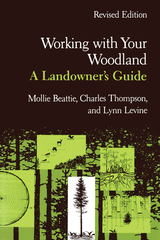 Working with Your Woodland: A Landowner’s Guide
Mollie Beattie, Charles Thompson, and Lynn Levine
University Press of New England, 1993 Packed with information and illustrations, Working with Your Woodland has given woodland owners all the basics necessary for making key decisions since it was first published in 1983. The revised edition reflects the fundamental changes in the way private woodlands are viewed. Today they must be seen as part of the whole earth rather than as owner-managed islands. Few owners are aware of the wide spectrum of compatible management objectives--such as encouragement of wildlife, development for recreation, and enhancement of scenic beauty--that can coexist with the more familiar timber and firewood potential of forested areas. Even fewer understand the purpose, techniques, environmental impacts, economics, or legalities of forest management. This edition provides necessary updating of the technological, environmental, tax, and legal concerns associated with woodland management. Three chapters have been completely rewritten, and there is new information on wetlands management, global warming, acid deposition, and rare or endangered species.
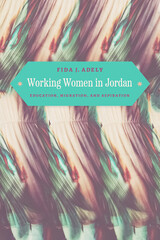 Working Women in Jordan: Education, Migration, and Aspiration
Fida J. Adely
University of Chicago Press, 2024 A surprising look at the meaningful social changes in Jordan as lived and navigated by educated women.
Jordan has witnessed tremendous societal transformation in its relatively short history. Today it has one of the most highly educated populations in the region, and women have outnumbered and outperformed their male counterparts for more than a decade. Yet, despite their education and professional status, many women still struggle to build a secure future and a life befitting of their aspirations.
In Working Women in Jordan anthropologist Fida J. Adely turns to college-educated women in Jordan who migrate from rural provinces to Amman for employment opportunities. Building on twelve years of ethnographic research and extensive interviews with dozens of women, as well as some of their family members, Adely analyzes the effects of developments such as expanded educational opportunities, urbanization, privatization, and the restructuring of the labor market on women’s life trajectories, gender roles, the institution of marriage, and kinship relations. Through these rich narrative accounts and the analysis of broader socio-economic shifts, Adely explains how educational structures can act as both facilitators and obstacles to workforce entry—along with cascading consequences for family and social life. Deeply thorough and compelling, Working Women in Jordan asks readers to think more critically about what counts as development, and for whom.
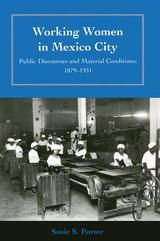 Working Women in Mexico City: Public Discourses and Material Conditions, 1879-1931
Susie S. Porter
University of Arizona Press, 2003 The years from the Porfiriato to the post-Revolutionary regimes were a time of rising industrialism in Mexico that dramatically affected the lives of workers. Much of what we know about their experience is based on the histories of male workers; now Susie Porter takes a new look at industrialization in Mexico that focuses on women wage earners across the work force, from factory workers to street vendors. Working Women in Mexico City offers a new look at this transitional era to reveal that industrialization, in some ways more than revolution, brought about changes in the daily lives of Mexican women. Industrialization brought women into new jobs, prompting new public discussion of the moral implications of their work. Drawing on a wealth of material, from petitions of working women to government factory inspection reports, Porter shows how a shifting cultural understanding of working women informed labor relations, social legislation, government institutions, and ultimately the construction of female citizenship. At the beginning of this period, women worked primarily in the female-dominated cigarette and clothing factories, which were thought of as conducive to protecting feminine morality, but by 1930 they worked in a wide variety of industries. Yet material conditions transformed more rapidly than cultural understandings of working women, and although the nation's political climate changed, much about women's experiences as industrial workers and street vendors remained the same. As Porter shows, by the close of this period women's responsibilities and rights of citizenship—such as the right to work, organize, and participate in public debate—were contingent upon class-informed notions of female sexual morality and domesticity. Although much scholarship has treated Mexican women's history, little has focused on this critical phase of industrialization and even less on the circumstances of the tortilleras or market women. By tracing the ways in which material conditions and public discourse about morality affected working women, Porter's work sheds new light on their lives and poses important questions for understanding social stratification in Mexican history.
Working Women of Collar City: Gender, Class, and Community in Troy, 1864-86
Carole Turbin
University of Illinois Press, 1992 Why have some working women succeeded at organizing in spite of obstacles to labor activity? Under what circumstances were they able to form alliances with male workers? Carole Turbin explores these and other questions by examining the case of Troy, New York. In the 1860s, Troy produced nearly all the nation's detachable shirt collars and cuffs. The city's collar laundresses were largely Irish immigrants. Their union was officially the nation's first women's labor organization, and one of the best organized. Turbin provides a new perspective on gender and shows that women's family ties are not necessarily a conservative influence but may encourage women's and men's collective action.
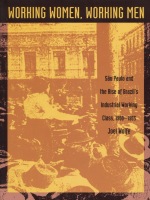 Working Women, Working Men: Sao Paulo & the Rise of Brazil’s Industrial Working Class, 1900–1955
Joel Wolfe
Duke University Press, 1993 In Working Women, Working Men, Joel Wolfe traces the complex historical development of the working class in Sào Paulo, Brazil, Latin America's largest industrial center. He studies the way in which Sào Paulo's working men and women experienced Brazil's industrialization, their struggles to gain control over their lives within a highly authoritarian political system, and their rise to political prominence in the first half of the twentieth century.
Drawing on a diverse range of sources—oral histories along with union, industry, and government archival materials—Wolfe's account focuses not only on labor leaders and formal Left groups, but considers the impact of grassroots workers' movements as well. He pays particular attention to the role of gender in the often-contested relations between leadership groups and thee rank and file. Wolfe's analysis illuminates how various class and gender ideologies influenced the development of unions, industrialists' strategies, and rank-and-file organizing and protest activities.
This study reveals how workers in Sào Paulo maintained a local grassroots social movement that, by the mid–1950s, succeeded in seizing control of Brazil's state-run official unions. By examining the actions of these workers in their rise to political prominence in the 1940s and 1950s, this book provides a new understanding of the sources and development of populist politics in Brazil.
 Working World: Careers in International Education, Exchange, and Development
Sherry L. Mueller and Mark Overmann
Georgetown University Press, 2008 Are you looking for a career with professional rewards and personal satisfaction? Perhaps you'd like to find meaningful employment in the field of international relations? Working World is the perfect resource for making sound career choices, and is particularly valuable for those interested in exploring a career in international education, exchange, and development. Sherry Mueller, president emeritus of a large nonprofit organization with an international focus, and Mark Overmann, a young professional on his way up, serve as spirited guidance counselors and offer valuable insight on launching a career, not just landing a job. The two authors—representing contrasting personalities, levels of experience, and different generations—engage in an entertaining dialogue designed to highlight alternative approaches to the same destination: making a difference in the world. With a rich mix of anecdotes and advice, the two authors present their individual perspectives on career development: identifying your cause, the art of networking, the value of mentors, and careers as "continuous journeys." Mueller and Overmann push job seekers to challenge assumptions about what it means to pursue a career in international relations and to recognize that the path to career success is rarely straight. To help the job seeker chart the best course, Working World provides specific resources including annotated lists of selected organizations, websites, and further reading. Profiles of twelve professionals, from promising young associates to presidents and CEOs, illustrate the book's main topics. Each professional provides insight into his or her career choices, distills lessons learned, and offers practical advice about building a career in international affairs. All of these resources were chosen specifically to help job seekers map the next steps toward the internship, job, or other opportunity that will give shape to the career they envision.
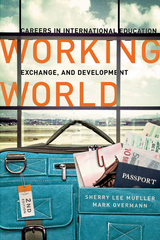 Working World: Careers in International Education, Exchange, and Development, Second Edition
Sherry Lee Mueller and Mark Overmann
Georgetown University Press, 2016 Now available in a new second edition, Working World: Careers in International Education, Exchange, and Development offers an engaging guide for cause-oriented people dedicated to begin or enhance careers in the now burgeoning fields of international affairs. Mueller and Overmann expand their original dialogue between a career veteran and a young professional to address issues that recognize the meteoric rise of social media and dramatic geopolitical events. They explore how the idea of an international career has shifted: nearly every industry taking on more and more international dimensions, while international skills—linguistic ability, intercultural management, and sensitivity—become ever more highly prized by potential employers. This second edition of Working World offers ten new and four significantly updated profiles as well as new and expanded concepts that include work-life balance, the importance of informational interviews, moving on, and key building blocks for international careers.
Like the award-winning first edition, Working World is a rare and valuable resource to students and graduates interested in careers in international affairs, mid-career professionals who want to make a career change or shift, as well as guidance counselors and career center specialists at universities.
Working-Class America: Essays on Labor, Community, and American Society
Edited by Michael H. Frisch and Daniel J. Walkowitz
University of Illinois Press, 1983 At the time of its original publication, Working-Class America represented the new labor history par excellence. A roster of noteworthy scholars in the field contribute original essays written during a pivotal time in the nation's history and within the discipline. Moving beyond historical-sociological analyses, the authors take readers inside the lives of the real men and women behind the statistics. The result is a classic collection focused on the human dimensions of the field, one valuable not only as a resource for historiography but as a snapshot of workers and their concerns in the 1980s.
Working-Class Life: The “American Standard” in Comparative Perspective, 1899-1913
Peter R. Shergold
University of Pittsburgh Press, 1982 This book challenges the commonly held theory that American workers had a far superior standard of living than their European counterparts in the early twentieth century. Peter R. Shergold bases his study on the cities of Pittsburgh, Pennsylvania and Birmingham, England, and compares statistical data on wage rates, labor hours, family income, retail prices, diet and budgets. He also presents information from medical investigators, travelers, charity workers, business organizations, diaries, speeches and a wide variety of other sources to breathe human life into his statistical data. Shergold reveals that skilled Americans did earn higher wages than the British, yet unskilled workers did not, while Americans worked longer hours, with a greater chance of injury, and had fewer social services.
Workingmen's Democracy: The Knights of Labor and American Politics
Leon Fink
University of Illinois Press, 1983 Focusing on the operation and influence of the Knights of Labor—the leading labor organization of the nineteenth century—Workingmen's Democracy explores the dreams, achievements, and failures of a movement that sought to renew the democratic potential of American institutions.
Runner-up in both the John H. Dunning Prize and Albert J. Beveridge Award competitions
Workings of the Spirit: The Poetics of Afro-American Women's Writing
Houston A. Baker Jr.
University of Chicago Press, 1990 Turning on inspired interpretations of Zora Neale Hurston, Toni Morrison, and Ntozake Shange, Workings of the Spirit weighs current critical approaches to black women's writing against Baker's own explanation of the founding, theoretical state of Afro-American intellectual history.
"Brilliant, and tenderly riveted to gratitude as an indispensable facet of analysis, Houston Baker arrives, yet again, bearing the loveliest flowers of his devotion and delight: thank God he's here!"—June Jordan
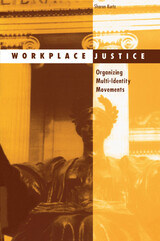 Workplace Justice: Organizing Multi-Identity Movements
Sharon Kurtz
University of Minnesota Press, 2002 An unheralded union battle offers new insight into identity politics. In 1991, Columbia University’s one thousand clerical workers launched a successful campaign for justice in their workplace. This diverse union-two-thirds black and Latina, three-fourths women-was committed to creating an inclusive movement organization and to fighting for all kinds of justice. How could they address the many race and gender injustices members faced, avoid schism, and maintain the unity needed to win? Sharon Kurtz, an experienced union activist and former clerical worker herself, was welcomed into the union and pursued these questions. Using this case study and secondary studies of sister clerical unions at Yale and Harvard, she examines the challenges and potential of identity politics in labor movements. With the Columbia strike as a point of departure, Kurtz argues that identity politics are valuable for mobilizing groups, but often exclude members and their experiences of oppression. However, Kurtz believes that identity politics should not be abandoned as a component in building movements, but should be reframed-as multi-identity politics. In the end she shows an approach to organizing with great potential impact not only for labor unions but for any social movement.
Workplace Learning and Leadership
Paul Signorelli
American Library Association, 2011 The best kind of learning is that which never ends—and a culture of training means that staff will be more flexible and responsive to new ideas and strategies, imperative in today's libraries. In this practical resource, leading workplace trainers Reed and Signorelli offer guidance on improving the effectiveness of training programs. Their book takes readers through the entire process of developing, implementing, and sustaining training programs and communities of learning, in order to - Empower individuals to become leaders and teachers by cultivating a culture of ongoing learning
- Connect library staff and users to information resources so they can effectively use them to their benefit
- Develop skills among both managers and workers for practicing continuous formal and informal training
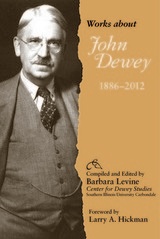 Works about John Dewey, 1886-2012
Compiled and Edited by Barbara Levine
Southern Illinois University Press, 2014 Works of John Dewey, 1886–2012 is an invaluable and meticulously compiled resource for the growing number of scholars and researchers seeking a deeper understanding of the work of the prominent American philosopher, psychologist, and educational reformer.
Dewey (1859–1952), an influential philosopher credited with the founding of pragmatism and also recognized as a pioneer in functional psychology and the progressive moment in education, was hailed by Life magazine in 1990 as one of the one hundred most important Americans of the twentieth century. This rich and continually expanding compendium of historical and more recent essays, research, and references is a testament to the growing interest in Dewey’s intellectual work and his measurable impact in the United States and throughout the world.
In Works of John Dewey, 1886–2012, some four thousand new entries are presented in ebook format, in addition to those from earlier print and electronic editions dating back to 1995. Copies of most of the works have been obtained and are stored at the Center for Dewey Studies. For the first time, users can access all items from all editions in one user-friendly format. Jump links to alphabetical sections facilitate movement through the vast collection of entries. Users can search by keyword and author.
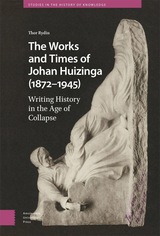 The Works and Times of Johan Huizinga (1872–1945): Writing History in the Age of Collapse
Thor Rydin
Amsterdam University Press, 2024 The lifetime of Johan Huizinga (1872–1945) was marked by dramatic transformations in Europe. Cityscapes, aesthetic codes, social orders, political cultures, international travel and means of warfare developed beyond recognition; entire catalogues of hopes and fears were torn asunder and replaced by new ones during not one but two wars. Amidst all these changes, Huizinga grew to become one of the most famous historians of his time. To this day, his works are treated as monuments in the cultural historical field.
This book examines how these transformations and ‘experiences of loss’ affected and informed Huizinga’s historical perspectives. Most centrally, this book contends that Huizinga’s historical works helped to accommodate and give meaning to his own experiences of uncertainty and rupture, thus offering him a way of life in turbulent times. This project offers an original and comprehensive analysis of an iconic historian writing in the age of collapse
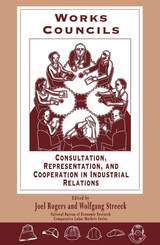 Works Councils: Consultation, Representation, and Cooperation in Industrial Relations
Edited by Joel Rogers and Wolfgang Streeck
University of Chicago Press, 1995 As the influence of labor unions declines in many industrialized nations, particularly the United States, the influence of workers has decreased. Because of the need for greater involvement of workers in changing production systems, as well as frustration with existing structures of workplace regulation, the search has begun for new ways of providing a voice for workers outside the traditional collective bargaining relationship.
Works councils—institutionalized bodies for representative communication between an employer and employees in a single workplace—are rare in the Anglo-American world, but are well-established in other industrialized countries. The contributors to this volume survey the history, structure, and functions of works councils in the Netherlands, Germany, France, Spain, Sweden, Italy, Poland, Canada, and the United States. Special attention is paid to the relations between works councils and unions and collective bargaining, works councils and management, and the role and interest of governments in works councils. On the basis of extensive comparative data from other Western countries, the book demonstrates powerfully that well-designed works councils may be more effective than labor unions at solving management-labor problems.
Works in Stone: Contemporary Perspectives on Lithic Analysis
Michael J. Shott
University of Utah Press, 2014 Whether done by Stone Age hunters or artisans in ancient civilizations, the transformation of resistant stone into useful implements required skills with a high level of sophistication. Because stone tools are durable, today we have a lithic record to explain past behavior and the evolution of culture over long spans. Interpretive and analytical approaches to the study of stone tools, however, are often treated as independent, disconnected specialties. Works in Stone provides a broad look at the field of lithic analysis by bringing together a cross section of recent research. Scholars present a diverse range of concepts and methods with case studies that extend to every continent and contexts ranging from the Paleolithic to late prehistory. Showcasing the latest research of lithic analysts, Works in Stone provides a cohesive overview of recent methods and conclusions.
The Works of Anne Bradstreet
Anne Bradstreet
Harvard University Press, 2010 Anne Bradstreet was one of our earliest feminists and the first true poet in the American colonies. This collection of her extant poetry and prose, scrupulously edited by Jeannine Hensley, has long been the standard edition of Bradstreet’s work. Hensley’s introduction sketches the poet’s life, and Adrienne Rich’s foreword offers a sensitive critique of Bradstreet as a person and as a writer. The John Harvard Library edition includes a chronology of Bradstreet’s life and an updated bibliography.
 The Works of Anne Bradstreet
Anne Bradstreet
Harvard University Press Anne Bradstreet, the first true poet in the American colonies, wrote at a time and in a place where any literary creation was rare and difficult and that of a woman more unusual still. Born in England and brought up in the household of the Earl of Lincoln where her father, Thomas Dudley, was steward, Anne Bradstreet sailed to Massachusetts Bay in 1630, shortly after her marriage at sixteen to Simon Bradstreet. For the next forty years she lived in the New England wilderness, raising a family of eight, combating sickness and hardship, and writing the verse that made her, as the poet Adrienne Rich says in her Foreword to this edition, "the first non-didactic American poet, the first to give an embodiment to American nature, the first in whom personal intention appears to precede Puritan dogma as an impulse to verse."
All Anne Bradstreet's extant poetry and prose is published here with modernized spelling and punctuation. This volume reproduces the second edition of Several Poems, brought out in Boston in 1678, as well as the contents of a manuscript first printed in 1857. Adrienne Rich's Foreword offers a sensitive and illuminating critique of Anne Bradstreet both as a person and as a writer, and the Introduction, scholarly notes, and appendices by Jeannine Hensley make this an authoritative edition.
Adrienne Rich observes, "Intellectual intensity among women gave cause for uneasiness" at this period--a fact borne out by the lines in the Prologue to the early poems: "I am obnoxious to each carping tongue/ Who says my hand a needle better fits." The broad scope of Anne Bradstreet's own learning and reading is most evident in the literary and historical allusions of The Tenth Muse, the first edition of her poems, published in London in 1650. Her later verse and her prose meditations strike a more personal note, however, and reveal both a passionate religious sense and a depth of feeling for her husband, her children, the fears and disappointments she constantly faced, and the consoling power of nature. Imbued with a Puritan striving to turn all events to the glory of God, these writings bear the mark of a woman of strong spirit, charm, delicacy, and wit: in their intimate and meditative quality Anne Bradstreet is established as a poet of sensibility and permanent stature.
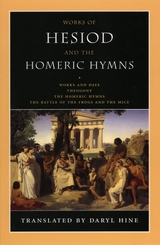 Works of Hesiod and the Homeric Hymns: Including Theogony and Works and Days
Edited by Daryl Hine
University of Chicago Press, 2004 Winner of the 2005 Harold Morton Landon Translation Award from the Academy of American Poets.
In Works of Hesiod and the Homeric Hymns, highly acclaimed poet and translator Daryl Hine brings to life the words of Hesiod and the world of Archaic Greece. While most available versions of these early Greek writings are rendered in prose, Hine's illuminating translations represent these early classics as they originally appeared, in verse. Since prose was not invented as a literary medium until well after Hesiod's time, presenting these works as poems more closely approximates not only the mechanics but also the melody of the originals.
This volume includes Hesiod's Works and Days and Theogony, two of the oldest non-Homeric poems to survive from antiquity. Works and Days is in part a farmer's almanac—filled with cautionary tales and advice for managing harvests and maintaining a good work ethic—and Theogony is the earliest comprehensive account of classical mythology—including the names and genealogies of the gods (and giants and monsters) of Olympus, the sea, and the underworld. Hine brings out Hesiod's unmistakable personality; Hesiod's tales of his escapades and his gritty and persuasive voice not only give us a sense of the author's own character but also offer up a rare glimpse of the everyday life of ordinary people in the eighth century BCE.
In contrast, the Homeric Hymns are more distant in that they depict aristocratic life in a polished tone that reveals nothing of the narrators' personalities. These hymns (so named because they address the deities in short invocations at the beginning and end of each) are some of the earliest examples of epyllia, or short stories in the epic manner in Greek.
This volume unites Hine's skillful translations of the Works of Hesiod and the Homeric Hymns—along with Hine's rendering of the mock-Homeric epic The Battle of the Frogs and the Mice—in a stunning pairing of these masterful classics.
The Works of Hrotsvit of Gandersheim: Facsimile of the First Edition (1581)
Hrotsvit of Gandersheim. Edited by David H. Price.
University of Illinois Press, 2017 Hrotsvit of Gandersheim, born circa 935, was a canoness at Gandersheim, a Benedictine monastery in Saxony. She may have come from the Saxon nobility, and she had the education to refer to ancient authors like Ovid and Virgil. Hrotsvit died around the year 975. David H. Price is professor of religious studies, history, and Jewish studies at the University of Illinois at Urbana-Champaign.
These works by a tenth-century woman, who wrote plays when no one else in Europe was writing plays and who imitated the style of Terence when most people thought the classics had been forgotten, caused a literary sensation when they were first published in 1501.
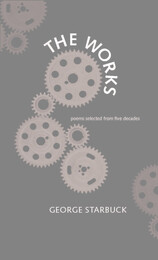 The Works: Poems Selected from Five Decades
George Starbuck
University of Alabama Press, 2003 Eighty-one poems spanning the career of the late George Starbuck, widely praised luminary of modern American verse. Starbuck was known in his lifetime and is remembered today as a practitioner of verse remarkable for its pathos, intelligence, and wit. A master of American vernacular, sensitive to the rhythms of everyday speech, Starbuck was also a brilliant lyricist, at once erudite and irreverent. He addressed some of the most profound issues of his day with a playful ingenuity and a virtuosity of talent that Glyn Maxwell, poetry editor of the New Republic, writing in The Oxford Companion to Twentieth Century Poetry, calls a "veritable arsenal of strategies against the darkness." Starbuck came to wide critical notice in 1960 with the publication of his first book, Bone Thoughts, which won the Yale Series of Younger Poets prize. He published work regularly in the New Yorker and other major literary journals in the United States. His work was consistently recognized with awards, among them the Prix de Rome, an Ingram-Merrill Fellowship, a Rockefeller Foundation Fellowship, the Beth Hokin Prize, a Notable Book of the Year designation from the New York Times, the Lenore Marshall poetry prize, and an Aiken-Taylor Lifetime Achievement Award. Grouped together by decades, the poems reveal Starbuck's developing genius. His technical agility and his singular voice are evident. As Anthony Hecht declares in his foreword, "I come to this posthumous collection with serene and justified confidence in finding enormous pleasure, astonishment, admiration, and genuine satisfaction. [This book] is a generous sampling of a profound poetic legacy, one for which readers ought to be deeply grateful."
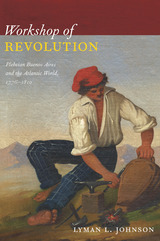 Workshop of Revolution: Plebeian Buenos Aires and the Atlantic World, 1776–1810
Lyman L. Johnson
Duke University Press, 2011 The plebeians of Buenos Aires were crucial to the success of the revolutionary junta of May 1810, widely considered the start of the Argentine war of independence. Workshop of Revolution is a historical account of the economic and political forces that propelled the artisans, free laborers, and slaves of Buenos Aires into the struggle for independence. Drawing on extensive archival research in Argentina and Spain, Lyman L. Johnson portrays the daily lives of Buenos Aires plebeians in unprecedented detail. In so doing, he demonstrates that the world of Spanish colonial plebeians can be recovered in reliable and illuminating ways. Johnson analyzes the demographic and social contexts of plebeian political formation and action, considering race, ethnicity, and urban population growth, as well as the realms of work and leisure. During the two decades prior to 1810, Buenos Aires came to be thoroughly integrated into Atlantic commerce. Increased flows of immigrants from Spain and slaves from Africa and Brazil led to a decline in real wages and the collapse of traditional guilds. Laborers and artisans joined militias that defended the city against British invasions in 1806 and 1807, and they defeated a Spanish loyalist coup attempt in 1809. A gravely weakened Spanish colonial administration and a militarized urban population led inexorably to the events of 1810 and a political transformation of unforeseen scale and consequence.
 Workshop of Silence: Poems
Jean D’Amérique; Translated from French by Conor Bracken
Vanderbilt University Press, 2025 Workshop of Silence, a book of poems by the Haitian writer Jean D’Amérique, was published in France by Cheyne éditeur in 2020. Across all of D’Amérique’s work, and especially in this third collection, he bridges the political and the personal, the aggrieved and the hopeful, the local and the global. The first three poems of Workshop offer a helpful overture. The first describes where the speaker’s poems come from (“gnaw[ed] nights sprung from guts”); the second imagines a world where tenderness alone can pay for groceries; and the third laments the inattention of “developed nations” toward places like Aleppo and Gaza, which are “married by force to the evening of bones.” Hope and horror, impatience and dreamy languor trade places throughout the book, as D’Amérique asks how poetry can be made of and resist silence, and how poems can be products of and inspirations toward hope and resistance even in the face of overwhelming, and sometimes violent, indifference.
Though D’Amérique’s poems grow out of soils strewn with stones and splotched with blood, they also grow out of play, one of the more daring and dangerous modes there is (“being happy is worth the price” he says in “worth the price”). Produced in a bilingual edition, with a side-by-side translation by Conor Bracken as well as a critical introduction, Workshop of Silence preserves and approximates this spirit of play and scrutiny so that the sound of the translation bears as much semantic heft as the signifying content of the words. This leads, oftentimes, to choices that may seem odd or tangential, but ultimately highlight D’Amérique’s experimentation with the French language in and on poetic form—the puns, the intricate play of assonance and consonance, the rhymes and kennings, the lineation and inversions. These all serve to recalibrate a reader’s relationship with the language he is writing in, one that has been used for centuries to subjugate people throughout the Global South. The more we recognize language as a mighty and strange substance that can be manipulated to do weird things and to effect arbitrary outcomes, the more we can both revel in its potential and question what it has led us to take for granted.
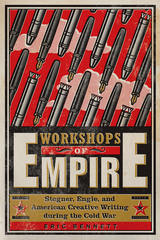 Workshops of Empire: Stegner, Engle, and American Creative Writing during the Cold War
Eric Bennett
University of Iowa Press, 2015 During and just after World War II, an influential group of American writers and intellectuals projected a vision for literature that would save the free world. Novels, stories, plays, and poems, they believed, could inoculate weak minds against simplistic totalitarian ideologies, heal the spiritual wounds of global catastrophe, and just maybe prevent the like from happening again. As the Cold War began, high-minded and well-intentioned scholars, critics, and writers from across the political spectrum argued that human values remained crucial to civilization and that such values stood in dire need of formulation and affirmation. They believed that the complexity of literature—of ideas bound to concrete images, of ideologies leavened with experiences—enshrined such values as no other medium could.
Creative writing emerged as a graduate discipline in the United States amid this astonishing swirl of grand conceptions. The early workshops were formed not only at the time of, but in the image of, and under the tremendous urgency of, the postwar imperatives for the humanities. Vivid renderings of personal experience would preserve the liberal democratic soul—a soul menaced by the gathering leftwing totalitarianism of the USSR and the memory of fascism in Italy and Germany.
Workshops of Empire explores this history via the careers of Paul Engle at the University of Iowa and Wallace Stegner at Stanford. In the story of these founding fathers of the discipline, Eric Bennett discovers the cultural, political, literary, intellectual, and institutional underpinnings of creative writing programs within the university. He shows how the model of literary technique championed by the first writing programs—a model that values the interior and private life of the individual, whose experiences are not determined by any community, ideology, or political system—was born out of this Cold War context and continues to influence the way creative writing is taught, studied, read, and written into the twenty-first century.
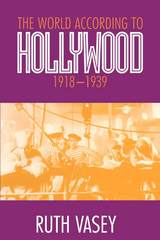 The World According to Hollywood, 1918–1939
Ruth Vasey
University of Wisconsin Press, 1997 The most visible cultural institution on earth between the World Wars, the Hollywood movie industry tried to satisfy worldwide audiences of vastly different cultural, religious, and political persuasions. The World According to Hollywood shows how the industry’s self-regulation shaped the content of films to make them salable in as many markets as possible. In the process, Hollywood created an idiosyncratic vision of the world that was glamorous and exotic, but also oddly narrow.
Ruth Vasey shows how the Motion Picture Producers and Distributors of America (MPPDA), by implementing such strategies as the industry’s Production Code, ensured that domestic and foreign distribution took place with a minimum of censorship or consumer resistance. Drawing upon MPPDA archives, studio records, trade papers, and the records of the U.S. Department of Commerce, Vasey reveals the ways the MPPDA influenced the representation of sex, violence, religion, foreign and domestic politics, corporate capitalism, ethnic minorities, and the conduct of professional classes.
Vasey is the first scholar to document fully how the demands of the global market frequently dictated film content and created the movies’ homogenized picture of social and racial characteristics, in both urban America and the world beyond. She uncovers telling evidence of scripts and treatments that were abandoned before or during the course of production because of content that might offend foreign markets. Among the fascinating points she discusses is Hollywood’s frequent use of imaginary countries as story locales, resulting from a deliberate business policy of avoiding realistic depictions of actual countries. She argues that foreign governments perceived movies not just as articles of trade, but as potential commercial and political emissaries of the United States. Just as Hollywood had to persuade its domestic audiences that its products were morally sound, its domination of world markets depended on its ability to create a culturally and politically acceptable product.
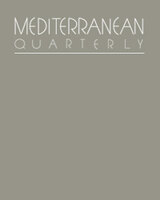 The World after Iraq: A Special Issue, Volume 14
Nikolaos A. Stavrou, ed.
Duke University Press Assembling high-profile policymakers, diplomats, and renowned foreign policy specialists, The World after Iraq investigates the state of global security in the wake of the U.S.-led war on Iraq and the ongoing “war on terrorism.” The collection examines the historical roots of global security as it relates to the Middle East and studies its implications for international relations and policy in a post–September 11 world. Given the complexity of the issues addressed, these essays do not pretend to offer definitive, prescriptive answers. Rather, the collection is intended to raise more questions than can be answered, thus setting in motion a serious and ongoing dialogue regarding the future of global security and the U.S. roles and responsibilities within it. Contributors from the Mediterranean Basin and the U.S.—both supporters and critics of U.S. foreign policy in pre- and postwar Iraq—investigate the U.S.’s “war on terrorism” and its associated concept of “preemptive war” as viable political strategies. Other essays weigh the ramifications of recent U.S. foreign policy in the Middle East for the institutions that have governed international relations since World War II and consider the political, social, and economic costs of this policy both for the U.S. itself and for the countries it targets. Contributors. Stephen C. Calleya, Vincent M. Cannistraro, Ted Galen Carpenter, Mohamed A. El-Khawas, Ivan Eland, William H. Lewis, Raymond Muhula, Bernard Reich, Burton M. Sapin, Joseph J. Sisco, Nikolaos A. Stavrou, Stansfield Turner
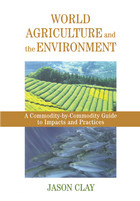 World Agriculture and the Environment: A Commodity-By-Commodity Guide To Impacts And Practices
Jason Clay; World Wildlife Fund
Island Press, 2003 World Agriculture and the Environment presents a unique assessment of agricultural commodity production and the environmental problems it causes, along with prescriptions for increasing efficiency and reducing damage to natural systems. Drawing on his extensive travel and research in agricultural regions around the world, and employing statistics from a range of authoritative sources including the United Nations Food and Agriculture Organization, the author examines twenty of the world’s major crops, including beef, coffee, corn, rice, rubber, shrimp, sorghum, tea, and tobacco. For each crop, he offers comparative information including: • a “fast facts” overview section that summarizes key data for the crop
• main producing and consuming countries
• main types of production
• market trend information and market chain analyses
• major environmental impacts
• management strategies and best practices
• key contacts and references With maps of major commodity production areas worldwide, the book represents the first truly global portrait of agricultural production patterns and environmental impacts.
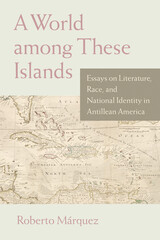 A World among These Islands: Essays on Literature, Race, and National Identity in Antillean America
Roberto Marquez
University of Massachusetts Press, 2010 Caribbean literature and culture have all too often been viewed in fragmented terms, without attention to the broader commonalities of the region. In this collection of essays written over many years, Roberto Márquez offers a more encompassing vision, one that respects the individual traditions of particular locales, languages, and cultures but also sees the larger themes that bind the area's literary heritage and history. Márquez begins by making the case for a genuinely Caribbean literary criticism, one that moves beyond the colonial history of fragmentation and isolation and the critical insularity of more conventional approaches. His pan-Caribbean perspective provides a point of departure for the scrutiny of the evolving dramas of race, nationality, nation-building, and cultural articulation in the region. Márquez then focuses specifically on Puerto Rico—its literary and socio—historical experience, the particularities of its "New Creole" incarnations, and the effects of waves of migration to the United States. In the final section of the book, he discusses writers and cultural figures from the other Spanish, Anglophone, and Francophone territories and the ways in which they engage or reflect the defining themes of literature, race, and national identity in Antillean America.
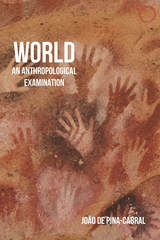 World: An Anthropological Examination
João de Pina-Cabral
HAU, 2016 What do we mean when we refer to world? How does the world relate to the human person? Are the two interdependent and, if so, in what way? What does world mean for an ethnographer or an anthropologist? Much has been said of worlds and worldviews, but do we really know what we mean by these words? Asking these questions and many more, this book explores the conditions of possibility of the ethnographic gesture, and how these shed light on the relationship between humans and the world in the midst of which they find themselves. As Pina-Cabral shows, recent decades have seen important shifts in the way we relate human thought to human embodiment—the relation between how we think and what we are. The book proposes a novel approach to the human condition: an anthropological outlook that is centered around the notions of personhood and sociality. Through a rich confrontation with ethnographic and historical material, this work contributes to the ongoing task of overcoming the theoretical constraints that have hindered anthropological thinking over the past century.
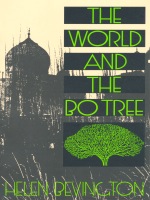 The World and the Bo Tree
Helen Bevington
Duke University Press, 1991 “Each time I leave home I seem to go in search of something—call it a bo tree, or Shangri-La, or paradise—which is only another name for peace itself and these days decidedly a fool’s errand.”
So writes Helen Bevington in The World and the Bo Tree, a book that describes her travels taken amid the turbulence of the 1980s. The “world” of the title is the one everybody knows, a fairly troubled, even threatening place to inhabit these days. The bo tree, which has flourished for centuries in India and Asia, is itself a meaningful symbol of peace, since under it the Buddha sat when he gained enlightenment and sought thereafter to share it with the world.
The book fashions a delightful fabric, a weave of exotic journeys and chaotic recent history. While we travel with Bevington to and from various destinations in Europe, Asia, South America, Africa, China, and elsewhere, we are conscious of the look of the world at home in striking contrast to the serenity occasionally glimpsed in distant places. At home she reminds us of such global disturbances as the demise of the Equal Rights Amendment, the Chernobyl nuclear disaster, the explosion of the space shuttle Challenger, and the possible destruction of the planet. Abroad, on some quest of their own, we may encounter such fascinating passersby as Mark Twain in Bangkok, Lord Byron in Italy, Goethe in Sicily, Marco Polo in China, Isak Dinesen in Africa, and Gladstone in the Blue Grotto of Capri.
Against the backdrop of the world, Bevington discovers moments of peace in unexpected and unlikely places—visible, she says, in Tibet or on the road to Mandalay, in the look of the midnight sun, or in the silence of Africa. Fleeting and elusive though these moments are, they are real and in themselves strangely enlightening.
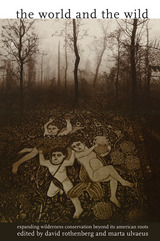 The World and the Wild: Expanding Wilderness Conservation Beyond its American Roots
Edited by David Rothenberg and Marta Ulvaeus
University of Arizona Press, 2001 Can nature be restored to a pristine state through deliberate action? Must the preservation of wilderness always subordinate the interests of humans to those of other species? Can indigenous peoples be entrusted with the guardianship of their own wild resources? This collection of international writings tackles tough questions like these as it expands wilderness conservation beyond its American roots. One of the first anthologies to consider wilderness as a global issue, it takes a stand against the notion that wilderness is a northern colonialist conceit and is irrelevant to the plans of third world countries. Contributions from all over the planet— Nepal, Borneo, Brazil, Chile, Mexico, Papua New Guinea, Kenya, South Africa, India, and the United States— show instead that wilderness has an important place in the environmental thought and policy of any nation, industrial or developing. The World and the Wild boldly advances the idea that our concept of wilderness must expand to take in new vistas. It breaks fresh ground in global environmentalism and is essential reading for anyone concerned with development issues related to conservation. Contents
Foreword: Whither World Wilderness? / Vance G. Martin
Introduction: Wilderness in the Rest of the World / David Rothenberg
How Can Four Trees Make a Jungle? / Pramod Parajuli
The Unpaintable West / Zeese Papanikolas
Restoring Wilderness or Reclaiming Forests? / Sahotra Sarkar
For Indian Wilderness / Philip Cafaro and Monish Verma
In the Dust of Kilimanjaro / David Western
Why Conservation in the Tropics Is Failing / John Terborgh
"Trouble in Paradise": An Exchange / David Western and John Terborgh
Zulu History / Ian Player
Bruno Manser and the Penan / William W. Bevis
Roads Where There Have Long Been Trails / Kathleen Harrison
Volcano Dreams / Tom Vanderbilt
Recycled Rain Forest Myths / Antonio Carlos Diegues
The Park of Ten Thousand Waterfalls / Dan Imhoff
Mapping the Wild / Edward A. Whitesell
Earth Jazz / Evan Eisenberg
They Trampled on Our Taboos / Damien Arabagali
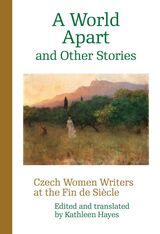 A World Apart and Other Stories: Czech Women Writers at the Fin de Siècle
Edited and Translated by Kathleen Hayes
Karolinum Press, 2021 A collection of short stories by Czech women from the turn of the twentieth century.
A World Apart brings together translations of eight stories by Czech women from the turn of the twentieth century—a period of female political emancipation and impressive literary development in Czechoslovakia. Though they’re little known to an English-language public today, all of the writers featured in the book were recognized in their own day and constitute a cross-section of the literary styles of the period. Anna Maria Tilschová’s “A Sad Time” is written in a naturalist style, while Růžena Jesenská’s “A World Apart” presents themes and motifs that appealed to the Decadents. Helena Malířová’s “The Sylph” is both diaristic and satirical, whereas Růžena Svobodová’s ironical “A Great Passion,” with its rural setting and folklore motifs, calls to mind the writings of Karel Jaromír Erben. Gabriela Preissová’s short story “Eva” may be read as a celebration of folk culture, and Božena Benešová’s “Friends” is interesting for its psychological presentation of a child’s point of view and its implicit criticism of anti-Semitism. The book is accompanied by the biographies of each author and an introduction by editor and translator Kathleen Hayes.
 The World as Abyss: The Caribbean and Critical Thought in the Anthropocene
Jonathan Pugh and David Chandler
University of Westminster Press, 2023 This book is about a distinctive ‘abyssal’ approach to the crisis of modernity. In this framing, influenced by contemporary critical Black studies, another understanding of the world of modernity is foregrounded – a world violently forged through the projects of Indigenous dispossession, chattel slavery and colonial world-making. Modern and colonial world-making violently forged the ‘human’ by dividing those with ontological security from those without, and by carving out the ‘world’ in a fixed grid of space and time, delineating a linear temporality of ‘progress’ and ‘development’. The distinctiveness of abyssal thought is that it inverts the stakes of critique and brings indeterminacy into the heart of ontological assumptions of a world of entities, essences, and universal determination. This is an approach that does not focus upon tropes of rescue and salvation but upon the generative power of negation. In doing so, it highlights how Caribbean experiences and writings have been drawn upon to provide an important and distinct perspective for critical thought. "How is it that ontology has come to be seen as the antidote for modernity? While Foucault denigrated ontology as a mistaken and parochial exercise, contemporary social theory holds out the promise that new modes of planetary knowledge will save us from our own excesses. Drawing together long traditions in Caribbean scholarship with Afro-pessimist thought, Pugh and Chandler illustrate how the search for more emancipatory ontologies - relational ontologies, indigenous ontologies, non-human ontologies, etc. – not only misunderstands the problem of modernity but (more importantly) works to veil the negative force that marks both the limit and cause of all such knowledge practices: what they term the abyss. To engage in abyssal thought – as they lay out – is to inhabit a site of refusal: a determination not to be drawn into the lure of ontological ‘correction’ and to recognise that the practice of world making cannot not bear the imprint of colonial violence. Articulated in passionate declarative prose, these authors powerfully illuminate the trap of the emancipatory instinct and the promise of a deconstructive ethic." — Mitch Rose, Senior Lecturer in Human Geography, Aberystwyth University, UK “A much-needed intellectual effort in the non-reductionist and non-essentialising style of Pugh and Chandler's previous book. The World as Abyss gives Caribbean thought and culture the place they deserve within critical theory and materialist studies.” — Mónica Fernández Jiménez, Valladolid University, Spain “For some time now scholars have questioned the overly general assumptions about the ‘anthropos’ of the Anthropocene, but much work needs to be done to flesh out what a decolonized Anthropocene might be. Pugh and Chandler’s The World as Abyss provides an original, intriguing and compelling counterpoint to bland Anthropocene humanism (and posthumanism). This timely work explores the poetics of the Caribbean and provides a way to think about the Anthropocene and the future beyond the managerialism of the present. This book is essential reading for those working in the environmental humanities or Anthropocene studies.” — Claire Colebrook, Professor, Penn State University, USA “This book names an apocalypse that began long ago. Pugh and Chandler patiently follow the journey of thought as it travels from the Middle Passage to the Caribbean. This brings them face-to-face with the horror of anti-Black violence, not as just another resource to strip-mine, but as an unavoidable abyss that confines all thought. Its reminder: that we have still not yet begun to think a truly Black world.” — Andrew Culp, Professor, California Institute of the Arts, USA "With the force of a manifesto, the intensity of a polemic, and the nuance of a treatise, thisbook sets out to disavow the disavowal of Colonial violence in the making of thecontemporary world and thought. Learning from Caribbean thinkers, writers, and poets, itsets to work unworking, desedimenting and deconstructing, the violent ontologicalfoundations by which anti-Black worlds maintain and reproduce their innocence andignorance. Replaying and reiterating, extending and multiplying, gestures of refusal –refusals of subjection, of History, of Geography, of meaning, of Being – there is the refusalof the World as it is and of the World as it could be. The World as Abyss artfully combines acritique of the historical forces which make and unmake the contemporary moment withthe suspension of horizons, of ends, of grounds. What emerges in the wake is anintensification of the generative capacity of this refusal; voids, arrhythmia, counter-times,displacements, dislocations, the abyssal. First as threat and then as promise" — PaulHarrison, Associate Professor of Human Geography, Durham University, UK
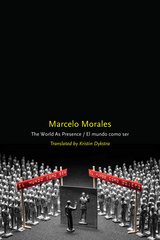 The World as Presence/El mundo como ser
Marcelo Morales, Introduced and Translated by Kristin Dykstra
University of Alabama Press, 2016 Marcelo Morales’s The World as Presence/El mundo como ser showcases, for the first time in English, a challenging, bold, and vivid new voice in Cuban literature.
Marcelo Morales was born in Cuba in 1977. He is an established, prize-winning writer, yet he is younger in comparison to most of the Cuban poets known internationally, many of whom were born prior to the 1959 revolution. While older generations of Cuban poets have wrestled in their work with social and political critique, those critiques have often been articulated through formal experimentation and abstraction, unsurprising given the censorship and the real threats of punishment that dissident writers have faced. Morales, however, directly interrogates both the Cuban past and present. References to many significant moments, people, and issues in Cuban history and culture can be found throughout his work.
Along with references to the activist group “The White Ladies,” the 1976 bombing of Cuban Airlines Flight 455, and the military aid that Cubans provided to Angola during its fight for independence, Morales’s poetry follows a timeline ranging from Martí to Guevara to the day of the 2014 announcement by Obama and Castro that diplomatic relations between the two nations would finally be restored. As Cuba experiences a series of historically remarkable transitions, Morales emerges from this context to offer an incisive poetic account of this critical moment in Cuban, as well as world, history.
The World as Presence/El mundo como ser is both the debut of this work in any language and the first English translation of a complete Morales collection. Given the bilingual format, this book will be of interest both to English and Spanish readers.
The World at Large: New and Selected Poems, 1971-1996
James McMichael
University of Chicago Press, 1996 The World at Large brings together the best of James McMichael's poetry and includes works that appear for the first time in this volume. With the publication of the new poems, McMichael surpasses even the formally daring and psychologically penetrating poetry that has characterized his work thus far.
 The World Bank: A Critical Primer
Eric Toussaint
Pluto Press, 2007 The World Bank is a controversial organisation. It is widely viewed with suspicion, as the international economic arm of the US, in thrall to the President who is responsible for appointing the head of the Bank.
Eric Toussaint gives a highly readable account of just why the World Bank has become so powerful. In short, clear chapters he shows how the bank operates, who funds it, and what it sets out to promote.
The Bank's main purpose is to grant loans to all the newly independent states of the developing world, to help them on their journey to recovery after colonial occupation. In reality, the conditions imposed on these states -- including enforced privatisation of all public services, and enforced neo-liberal rules on trade -- mean that the Bank has become the new colonial authority in everything but name.
This is a perfect book for anyone looking for a critical introduction to the history of the Bank and its role in world affairs.
 World Bank Literature
Amitava Kumar
University of Minnesota Press, 2002 A trailblazing interrogation of the cultural, political, and economic implications of World Bank hegemony. World Bank literature is more than a concept-it is a provocation, a call to arms. It is intended to prompt questions about each word, to probe globalization, political economy, and the role of literary and cultural studies. As asserted in this major work, it signals a radical rewriting of academic debates, a rigorous analysis of the World Bank and the International Monetary Fund (IMF), and a consideration of literature that deals with new global realities. Made more relevant than ever by momentous antiglobalization demonstrations in Seattle and Genoa, World Bank Literature brings together essays by a distinguished group of economists, cultural and literary critics, social scientists, and public policy analysts to ask how to understand the influence of the World Bank/IMF on global economic power relations and cultural production. The authors attack this question in myriad ways, examining World Bank/IMF documents as literature, their impact on developing nations, the relationship between literature and globalization, the connection between the academy and the global economy, and the emergence of coalitions confronting the new power. World Bank Literature shows, above all, the multifarious and sometimes nefarious ways that abstract academic debates play themselves out concretely in social policy and cultural mores that reinforce traditional power structures. Contributors: Anthony C. Alessandrini, Kent State U; Bret Benjamin, SUNY, Albany; John Berger; Suzanne Bergeron, U of Michigan, Dearborn; Lorrayne Carroll, U of Southern Maine; Manthia Diawara, NYU; Grant Farred, Duke; Barbara Foley, Rutgers; Claire F. Fox, U of Iowa; Rosemary Hennessy, SUNY, Albany; Doug Henwood, Left Business Observer; Caren Irr, Brandeis; Joseph Medley, U of Southern Maine; Cary Nelson, U of Illinois; Gautam Premnath, U of Massachusetts, Boston; Bruce Robbins, Columbia; Andrew Ross, NYU; Subir Sinha, U of London; Kenneth Surin, Duke; Rashmi Varma, U of North Carolina; Evan Watkins, U of California, Davis; Phillip E. Wegner, U of Florida; Richard Wolff, U of Massachusetts.
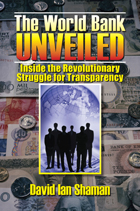 The World Bank Unveiled: Inside the revolutionary struggle for transparency
David Ian Shaman
Parkhurst Brothers, Inc., 2009 Nobel Prize winning economist and former World Bank Chief Economist, Joseph Stiglitz, has repeatedly discussed the importance of transparency in policymaking at the World Bank and International Monetary Fund. He believes a lack of transparency in the two institutions has lead to bad decisions. Bad decisions at IMF and the World Bank mean real pain for the world’s poor. There is a perception that “the suits” close the World Bank’s doors to deliberate the fate of earth’s poorest populations and only when the doors are unlocked do people living in poverty learn what has been decided about their future. Meanwhile donations are down. The bank’s critical International Development Association’s funding has dropped dramatically. Managers are discouraged by studies examining the World Bank’s effectiveness. How, they wonder, could such large beneficences have so little impact on poor populations? Events of the past two years have only increased the stakes. First, rising fuel prices caused a worldwide rise in the price of basic foods. Then the deepest economic downturn since the Great Depression sapped donor nation’s coffers. By the end of the Bush administration in 2009, giving by the USA lagged more than any other wealthy nation. In 1999, two Bank researchers understood the situation was already on a precipice. World Bank loans had ceased to make significant impact on poverty in many client nations. Certain governments and multi-national corporations were destroying environments and desecrating indigenous cultures, all to achieve short-term gains for a fortunate few. Demonstrable successes were few, and every World Bank conference became a melee of demonstrators and police. The two researchers asked themselves whether it was possible to open up the institution by increased transparency, improve its accountability, and mute criticism. They decided to launch an internet-based broadcast to disseminate unedited videos of internal discussions and debates. The bank’s culture and bureaucracy, hardened over a half-century, presented them with a formidable foe. Some powerful officials feared the transparency initiative; others withheld public support while standing on the sidelines. The World Bank Unveiled documents this epic struggle. It is the story of a revolution to transform the World Bank and a case study of the power of the Bank to transform people’s lives.
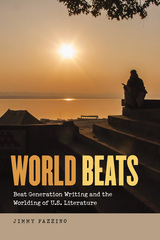 World Beats: Beat Generation Writing and the Worlding of U.S. Literature
Jimmy Fazzino
Dartmouth College Press, 2016 This fascinating book explores Beat Generation writing from a transnational perspective, using the concept of worlding to place Beat literature in conversation with a far-reaching network of cultural and political formations. Countering the charge that the Beats abroad were at best naïve tourists seeking exoticism for exoticism’s sake, World Beats finds that these writers propelled a highly politicized agenda that sought to use the tools of the earlier avant-garde to undermine Cold War and postcolonial ideologies and offer a new vision of engaged literature. With fresh interpretations of central Beat authors Jack Kerouac, Allen Ginsberg, and William Burroughs—as well as usually marginalized writers like Philip Lamantia, Ted Joans, and Brion Gysin—World Beats moves beyond national, continental, or hemispheric frames to show that embedded within Beat writing is an essential universality that brought America to the world and the world to American literature. This book presents an original treatment that will attract a broad spectrum of scholars.
The World Below: Body and Cosmos in Otomí Indian Ritual
Jacques Galinier
University Press of Colorado, 2004 In The World Below, Jacques Galinier surveys both traditional Otomí cosmology and colonial and contemporary Catholic rituals to illustrate the complexity of continuity and change in Mesoamerican religious ideology and practice. Galinier explores the problems of historical and family memory, models of space and time, the role of the human habitation in cosmology, shamanism and healing, and much more. He elucidates the way these realities are represented in a series of arresting oppositions - both Otomí oppositions and the duality of indigenous and Catholic ritual life - between the upper and lower human body. Drawing upon both Freud and theories of the carnivalesque, Galinier argues that the "world below" (the lower half of the body) provides the foundation for an indigenous metapsychology that is at once very close to and very far away from the Freudian conceptual apparatus.
A World Between Waves
Edited by Frank Stewart
Island Press, 1992 A World Between Waves is a collection of essays on the natural history of Hawaii by some of America's most renowned writers. It is a testament to the biological and geological wealth of this unique and threatened island landscape, and a passionate call to action on behalf of what may soon be gone.
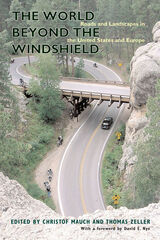 The World beyond the Windshield: Roads and Landscapes in the United States and Europe
Christof Mauch
Ohio University Press, 2008 For better or worse, the view through a car's windshield has redefined how we see the world around us. In some cases, such as the American parkway, the view from the road was the be-all and end-all of the highway; in others, such as the Italian autostrada, the view of a fast, efficient transportation machine celebrating either Fascism or its absence was the goal. These varied environments are neither necessary nor accidental but the outcomes of historical negotiations, and whether we abhor them or take delight in them, they have become part of the fabric of human existence.
The World beyond the Windshield: Roads and Landscapes in the United States and Europe is the first systematic, comparative look at these landscapes. By looking at examples from the United States and Europe, the chapters in this volume explore the relationship between the road and the landscape that it traverses, cuts through, defines, despoils, and enhances. The authors analyze the Washington Beltway and the Blue Ridge Parkway, as well as iconic roads in Italy, Nazi Germany, East Germany, and Great Britain. This is a story of the transatlantic exchange of ideas about environment and technology and of the national and nationalistic appropriations of such landscaping.
World Building: Transmedia, Fans, Industries
Edited by Marta Boni
Amsterdam University Press, 2017 Thanks to modern technology, we are now living in an age of multiplatform fictional worlds, as television, film, the Internet, graphic novels, toys and more facilitate the creation of diverse yet compact imaginary universes, which are often recognisable as brands and exhibit well-defined identities. This volume, situated at the cutting edge of media theory, explores this phenomenon from both theoretical and practical perspectives, uncovering how the construction of these worlds influences our own determination of values and meaning in contemporary society.
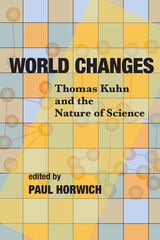 World Changes: Thomas Kuhn and the Nature of Science
Paul Horwich
University of Pittsburgh Press, 2024 Thomas Kuhn is viewed as one of the most influential (and controversial) philosophers of science, and this re-release of a classic examination of one of his seminal works reflects his continuing importance. In World Changes, the contributors examine the work of Kuhn from a broad philosophical perspective, comparing earlier logical empiricism and logical positivism with the new philosophy of science inspired by Kuhn in the early 1960s. The nine chapters offer interpretations of his major work The Structure of Scientific Revolutions and subsequent writings. The introduction outlines the significant concepts of Kuhn's work that are examined and is followed by a brief appraisal of Kuhn by Carl Hempel. The chapters discuss topics that include: a systematic comparison of Kuhn and Carnap viewing similarities and differences; the disputation of absolute truth; rational theory evaluation and comparison; applying theory to observation and the relation of models in a new conceptualization of theory content; and interpreting Kuhn's plurality-of-worlds thesis. The volume also presents four historical papers that speak to Kuhn's views on lexical structures and concept-formation and their antecedents. The afterward, by Kuhn himself, reviews his own philosophical development, his thoughts on the dynamics of scientific growth, and his response to issues raised by the contributors and other interpreters of his work.
World Checklist and Bibliography of Campanulaceae
Thomas G. Lammers
Royal Botanic Gardens, Kew, 2007 The bellflower Family Campanulaceae is found throughout the world, and includes a large number of species important in ornamental horticulture. For the past quarter century, Dr. Thomas Lammers has devoted his professional career to a better understanding of its relationships, classification, distribution, and evolution. In this volume, he provides a thorough accounting of the family, the first to be published since 1839. Eighty-four genera are recognized, encompassing 2319 species, 391 subspecies, and 27 named hybrids; another 8135 names are treated as synonyms. For each recognized species, subspecies, or hybrid, information is provided on its geographic distribution, life-form, and chromosome number. All this is fully documented by an encyclopaedic bibliography. As such, it is the ultimate resource from which to begin any inquiry into the family and its members.
World Checklist of Cyperaceae
Rafael Govaerts and Simpon David
Royal Botanic Gardens, Kew, 2007 The sedge family, Cyperaceae, is the third largest family of monocotyledonous plants. They are of significant economic importance, especially among rural communities in the tropics, where sedges are intensively used. The World Checklist of Cyperaceae is a unique resource that lists all validly published names of sedges, providing the source of their publication and indication of which names are currently accepted and which are synonyms. It will be a standard nomenclatural reference for further research into this important family.
World Checklist of Dioscoreales
Rafael Govaerts, Paul Wilkin, and Richard M. K. Saunders
Royal Botanic Gardens, Kew, 2000 Dioscoreales are a small but systematically and economically significant order of monocotyledons. The most diverse and important member is the yam genus, Dioscorea L., a source of dietary starch at macroeconomic to rural community levels. Other species of Dioscorea provided the chemical basis of corticosteroid drugs and oral contraceptives. Ally families comprise the unusual, largely achlorophyllous (heteromycotrophic) Burmanniaceae and the relatively unspecialised Nartheciaceae.
The World Checklist of Dioscoreales lists all validly published names of yams and their allies, providing the source of their publication and indication of which names are currently accepted and which are synonyms, making it a standard nomenclatural reference for further research into this important family.
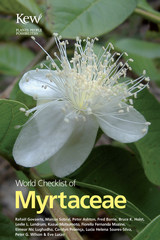 World Checklist of Myrtaceae
Rafael Govaerts, Marcos Sobral, Peter Ashton, and Fred Barrie
Royal Botanic Gardens, Kew, 2008 Myrtaceae is the ninth largest flowering plant family; it is economically important in the production of timber, gums, essential oils, fruits and spices, and contains many commonly cultivated ornamentals. The family is particularly rich in large genera, often found in some of the world's most threatened ecosystems, where their fruits comprise an important part of the diet of primates and birds. The similarity of Myrtaceae species is high, and its taxonomic and nomenclatural history is complex, resulting in notorious difficulties in basic identification, inventory compilation and floristic treatment.
The World Checklist of Myrtaceae is a much needed work that lists all validly published names in the family, providing the source of their publication and indicating which names are currently accepted and which are synonyms. It will be respected as the standard nomenclatural reference for further research into this important family.
World Checklist of Palms
Rafaël Govaerts and John Dransfield
Royal Botanic Gardens, Kew, 2005 The palm family, considered to be second only to the grasses among monocotyledonous plants of economic importance, is of immense significance to man, especially among rural communities in the tropics, where wild palms are intensively utilised. The 'World Checklist of Palms' is the unique resource that lists all validly published names of palms, providing the source of their publication and indication of which names are currently accepted and which are synonyms. Geographical distribution is also included for all accepted species.
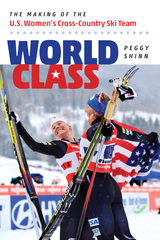 World Class: The Making of the U.S. Women's Cross-Country Ski Team
Peggy Shinn
University Press of New England, 2018 What makes a great team? Sports journalist Peggy Shinn answers this question in her enthralling account of the dramatic rise of the U.S. women’s cross-country ski team, winners of eight medals at three world championships over the past five years. Shinn’s story—based on dozens of interviews with athletes, coaches, parents, spouses, and friends—paints a vivid picture of the obstacles that America’s female athletes must overcome not just to ski with the world’s best, but to beat them. In a sport where U.S. women have toiled for decades, mostly in the middle or the back of the pack, the development of a world-class team attests to the heady combination of a transformational leader, a coach who connects with his athletes, the super-fast individual skiers who are also conscientious teammates—and a bit of good luck. This is the story of Kikkan Randall, Liz Stephen, Holly Brooks, Jessie Diggins, Ida Sargent, Sadie Bjornsen, Sophie Caldwell, Rosie Brennan, and coach Matt Whitcomb—and how they created the perfect team.
The World Color Survey
Paul Kay, Brent Berlin, Luisa Maffi, William R. Merrifield, and Richard Cook
CSLI, 2009 The 1969 publication of Brent Berlin and Paul Kay's Basic Color Terms proved explosive and controversial. Contrary to the then-popular doctrine of random language variation, Berlin and Kay's multilingual study of color nomenclature indicated a cross-cultural and almost universal pattern in the selection of colors that received abstract names in each language. The ensuing debate helped reform the views of anthropologists, linguists, and psychologists alike. After four decades in print, Basic Color Terms now has a sequel: in this book, the authors authoritatively extend the original survey, studying 110 additional unwritten languages in detail and in situ. The results are presented with charts showing the overall palette of color terms within each language as well as the levels of agreement among speakers.
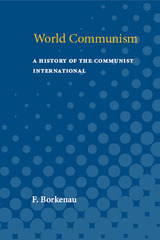 World Communism: A History of the Communist International
F. Borkenau
University of Michigan Press, 1962 World Communism: A History of The Communist International by F. Borkenau with a New Introduction by Raymond Aron covers topics such as the Russian Revolutionary Movement, Bolshevism, labor in the war, the German revolution, the foundation and various phases of the Communist International, China's revolution and soviets, and significant historical events up to the rise of Hitler and the role of the Comintern in colonial contexts. In the new introduction, Aron emphasizes the historical context of Borkenau's original work, written in 1939. He discusses the significance of the book's conclusions, its enduring relevance, and Borkenau's sound analysis of Bolshevik ideology and its incompatibility with Western proletarian movements. Aron reflects on the phases of the Comintern’s influence and its broader implications on revolutions in Europe and Asia, particularly noting the distinct revolutionary circumstances in China. The book includes significant chapter coverage of key historical moments and analyses the systematic echoes between Bolshevik principles and their global impact. It is an essential read for those studying the intricate developments and historical contexts of international Communism and Marxism.
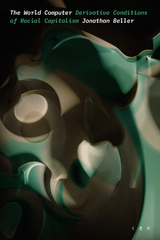 The World Computer: Derivative Conditions of Racial Capitalism
Jonathan Beller
Duke University Press, 2021 In The World Computer Jonathan Beller forcefully demonstrates that the history of commodification generates information itself. Out of the omnipresent calculus imposed by commodification, information emerges historically as a new money form. Investigating its subsequent financialization of daily life and colonization of semiotics, Beller situates the development of myriad systems for quantifying the value of people, objects, and affects as endemic to racial capitalism and computation. Built on oppression and genocide, capital and its technical result as computation manifest as racial formations, as do the machines and software of social mediation that feed racial capitalism and run on social difference. Algorithms, derived from for-profit management strategies, conscript all forms of expression—language, image, music, communication—into the calculus of capital such that even protest may turn a profit. Computational media function for the purpose of extraction rather than ameliorating global crises, and financialize every expressive act, converting each utterance into a wager. Repairing this ecology of exploitation, Beller contends, requires decolonizing information and money, and the scripting of futures wagered by the cultural legacies and claims of those in struggle.
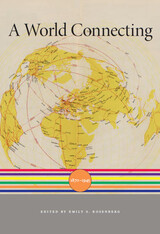 A World Connecting: 1870–1945
Emily S. Rosenberg
Harvard University Press, 2012 Between 1870 and 1945, advances in communication and transportation simultaneously expanded and shrank the world. New technologies erased distance and accelerated the global exchange of people, products, and ideas on an unprecedented scale. A World Connecting focuses on an era when growing global interconnectedness inspired new ambitions but also stoked anxieties and rivalries that would erupt in two world wars—the most destructive conflicts in human history.
In five interpretive essays, distinguished historians Emily S. Rosenberg, Charles S. Maier, Tony Ballantyne, Antoinette Burton, Dirk Hoerder, Steven C. Topik, and Allen Wells illuminate the tensions that emerged from intensifying interconnectedness and attempts to control and shape the effects of sweeping change. Each essay provides an overview of a particular theme: modern state-building; imperial encounters; migration; commodity chains; and transnational social and cultural networks. With the emergence of modern statehood and the fluctuating fate of empires came efforts to define and police territorial borders. As people, products, capital, technologies, and affiliations flowed across uneasily bounded spaces, the world both came together and fell apart in unexpected, often horrifying, and sometimes liberating ways.
A World Connecting goes beyond nations, empires, and world wars to capture the era’s defining feature: the profound and disruptive shift toward an ever more rapidly integrating world.
World Crisis Effects on Social Security in Latin America and the Caribbean: Lessons and Policies
Carmelo Mesa-Lago
University of London Press, 2010 Written by a top scholar on social security in Latin America and the Caribbean, this book assesses the effects of the world economic crisis on social security and welfare in the region. Drawing on the impact of and lessons from previous crises, Carmelo Mesa-Lago identifies the strengths and weakness of Latin American social security before the current global crisis. He evaluates the event's actual and potential effects on pensions, health care, and social assistance programs, based on a taxonomy of three groups of countries. The book ends with a summary of policies adopted by some countries and the author's own recommendations on social policies to lessen the adverse outcomes of the financial crisis. Latin America's pioneering social-welfare reforms make this book important for other regions of the world, both developed and developing.
 World Development: An Introduction
Prodromos Panayiotopoulos
Pluto Press, 2001 Do the structures of the world economy invariably work against the interests of the Third World? What is the impact of industrialisation? How does it affect people and their livelihoods, gender relations, the environment, movements for social justice and democracy?
World Development offers answers to these questions. A comprehensive introductory guide for students, teachers, volunteers and NGO workers in development, World Development examines the substantive issues surrounding development, industrialisation and globalization and places them within a historic context. It outlines the historical development of the world economy and assesses the current prospects for developing countries. The book contains in-depth analyses of how particular industries operate at local and global levels, drawing from case studies on textiles, tourism and copper. There are also case studies of specific countries, including South Korea, Cyprus, Mexico, China and Spain.
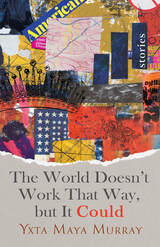 The World Doesn't Work That Way, but It Could: Stories
Yxta Maya Murray
University of Nevada Press, 2025 One of the Best Books of 2020, Buzzfeed News
The Millions' Most Anticipated: The Great Second-Half of 2020 Book Preview
The gripping, thought-provoking stories in Yxta Maya Murray’s latest collection find their inspiration in the headlines. Here, ordinary people negotiate tentative paths through wildfire, mass shootings, bureaucratic incompetence, and heedless government policies with vicious impacts on the innocent and helpless. A nurse volunteers to serve in catastrophe-stricken Puerto Rico after Hurricane Maria and discovers that her skill and compassion are useless in the face of stubborn governmental inertia. An Environmental Protection Agency employee, whose agricultural-worker parents died after long exposure to a deadly pesticide, finds herself forced to find justifications for reversing regulations that had earlier banned the chemical. A Department of Education employee in a dystopic future America visits a highly praised charter school and discovers the horrific consequences of academic failure. A transgender trainer of beauty pageant contestants takes on a beautiful Latina for the Miss USA pageant and brings her to perfection and the brink of victory, only to discover that she has a fatal secret.
The characters in these stories grapple with the consequences of frightening attitudes and policies pervasive in the United States today. The stories explore not only our distressing human capacity for moral numbness in the face of evil, but also reveal our surprising stores of compassion and forgiveness. These brilliantly conceived and beautifully written stories are troubling yet irresistible mirrors of our time.
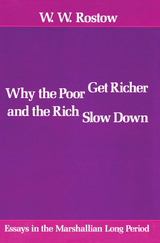 The World Economy: History & Prospect
By W. W. Rostow
University of Texas Press, 1978 This monumental study is an account of the world economy from the eighteenth century to the twentieth, an analysis and prescription for the future, and a challenge to the neo-Keynesian theories of income determination and growth. It is based on some forty years of research and teaching. Originally published in 1978, the volume looks back over the nineteenth and twentieth centuries. It includes an analysis of how the world's population expanded from about 1 billion in 1800 to 4 billion in 1976, with some 6.5 billion in sight for the year 2000; an account of the expansion and distribution of industrial production and trade during this period; and an analysis of price and relative price movements since the eighteenth century. Rostow gives a detailed description of the Kondratieff long cycles in the relative scarcity and abundance of food and raw materials and reasons that the world economy entered the fifth Kondratieff upswing at the close of 1972. He also examines the changing pattern of business cycles over the whole sweep of modern economic growth and the failure of the post-1945 world economy to control inflation. The volume also includes short economic histories of twenty national economies responsible for 80 percent of the world's production, based on a collection of computerized aggregate and sectoral data. Each historical section leads naturally into one or more of the major problems dealt with in the final portion of the book, which looks to the future of the world economy: food, population, energy, raw materials, the environment, and the tasks of national and international policy. Rostow argued, counter to the Limits to Growth doctrine, that the critical period for industrial civilization lay in the last twenty-five years of the twentieth century, rather than in the twenty-first century, and that what we did or failed to do in that generation would determine the shape of the longer future. No other economic history of this depth and breadth exists. It is a reference for economists, economic historians, and other social scientists as well as the informed lay reader.
World Elsewhere
Richard Poirier
University of Wisconsin Press, 1985 Richard Poirier’s A World Elsewhere, originally published in 1966 by the Oxford University Press, is a signal book in American literature and literary history. Widely acclaimed upon publication, it has since taken its place among a handful of books considered mandatory reading for all students and scholars in the field. Poirier’s classic work, hailed both for its original thesis and for its stylistic elegance and clarity, is once again made available in this new Wisconsin paperback edition.
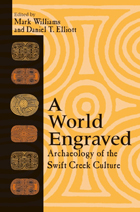 A World Engraved: Archaeology of the Swift Creek Culture
Edited by Mark Williams and Daniel T. Elliott
University of Alabama Press, 1998 This major summary of the current state of archaeological research on the Swift Creek culture is the first comprehensive collection ever published concerning the Swift Creek people. The Swift Creek people, centered in Georgia and surrounding states from A.D. 100 to 700, are best known from their pottery, which was decorated before firing with beautiful paddle-stamped designs--some of the most intricate and fascinating in the world. Comprehensive in scope, this volume details the discovery of this culture, summarizes what is known about it at the present time, and shows how continued improvements in the collection and analysis of archaeological data are advancing our knowledge of this extinct society. Although they know nothing of Swift Creek language and little about its society, archaeologists have collected valuable information about the
economic strategies of Swift Creek inhabitants. What archaeologists know best, however, is that the Swift Creek people were some of the best wood carvers the world has seen, and their pottery will stand as their lasting legacy for all time. This book presents and preserves their legacy.
The World Falls Away
Wanda Coleman
University of Pittsburgh Press, 2011
The burnings from which Coleman culls her work casts a glow and unique warmth that invites the reader to sit by her metaphorical hearth, to laugh and enjoy their “conversation.” The contemplative and philosophical have entered her voice as she continues to explore the conflicts and confusions that shape the aesthetic terrain of Southern California and beyond—as she continues to grapple with cultural bias, malignant domestic neglect, poverty, and the damages of racism, yet broadening her palette of social ills to include the privacies of grief, loss and transcendence. A nominee and finalist for Poet Laureate of California, she continues to reflect the ethnic scramble of Los Angeles, where she has been honored by proclamations from the city’s elected officials, including the mayor’s office, the city council and the Department of Cultural Affairs.
 World Film Locations: Athens
Edited by Anna Poupou, Afroditi Nikolaidou, and Eirini Sifaki
Intellect Books, 2014 A filmic guidebook of the Greek capital, World Film Locations: Athens takes readers to film locations in the central historical district, with excursions to the periphery of Athens—popular neighborhoods, poor suburbs, and slums often represented in postwar neorealist films—and then on to garden cities and upper-class suburbs, especially those preferred by the auteurs of the 1970s. Of course, no Grecian vacation would be complete without a visit to the sea, and summer resorts, hotels, and beaches near Athens are frequent backdrops for international productions. However, more recent economic strife has emptied city neighborhoods, created urban violence, and caused an increase in riots in the Mediterranean city, and representations of this on film are juxtaposed with images of the eternal and idyllic city.
Featuring both Greek and foreign productions from various genres and historical periods, the book ultimately works to establish connections between the various aesthetics of dominant representations of Athens.
 World Film Locations: Barcelona
Edited by Helio San Miguel and Lorenzo J. Torres Hortelano
Intellect Books, 2013 Barcelona is one of the world’s most beautiful cities. A permanent showcase of the work of acclaimed architect Antoni Gaudí, it also has a long and rich cinematic legacy. Great directors from all over the world—among them Woody Allen, Pedro Almodóvar, and Michelangelo Antonioni—have set their films there. World Film Locations: Barcelona is the first book of its kind to explore the rich cinematic history of this seductive Catalonian city.
The illuminating essays collected here cover essential themes of the city’s cinematic history, including the origins of cinema in Barcelona; the role of Ciutat Vella (old quarter) as a film set; the influential Barcelona School of the 1960s; the film presence of Gaudí and his work; changing attitudes and urban renewal before and after the 1992 Olympics; and the emergence of a new generation of female filmmakers that have made Barcelona the center of their cinematic explorations. This book will be a welcome addition to the libraries of anyone enchanted by the beauty of Barcelona, whether in person on the big screen.
 World Film Locations: Beijing
Edited by John Berra and Liu Yang
Intellect Books, 2012 The title of Li Yu’s film Lost in Beijing evokes the experience of many first-time visitors to China’s bustling capital. The city’s sprawling structure and rapid redevelopment—embodied by the high-rise apartments taking over historic districts—render Beijing’s streets hard to navigate and its culture is just as difficult to penetrate. World Film Locations: Beijing is a revealing and engrossing introduction to both. In a series of spotlight essays and illustrated scene reviews, a cast of seasoned scholars and fresh new voices explore the vast range of films—encompassing drama, madcap comedy, martial arts escapism, and magical realism—that have been set in Beijing. Unveiling a city of hidden courtyards, looming skyscrapers, and traditional Hutong neighborhoods, these contributors depict a distinctive urban culture that reflects the conflict and tumult of a nation in transition. With considerations of everything from the back streets of Beijing Bicycle to the forbidden palace of The Last Emperor to the tourist park of The World, this volume is a definitive cinematic guide to an ever-changing and endlessly fascinating capital city.
 World Film Locations: Berlin
Edited by Susan Ingram
Intellect Books, 2012 One of the most dynamic capital cities of the twenty-first century, Berlin also has one of the most tumultuous modern histories. A city that came of age, in many senses, with the cinema, it has been captured on film during periods of exuberance, devastation, division, and reconstruction. World Film Locations: Berlin offers a broad overview of these varied cinematic representations. Covering an array of films that ranges from early classics to contemporary star vehicles, this volume features detailed analyses of forty-six key scenes from productions shot on location across the city, as well as spotlight essays in which contributors with expertise in German studies, urban history, and film studies focus on issues central to understanding Berlin cinema. Among the topics discussed are the roles of rubble, construction sites, and music in films set and shot in Berlin, as well as key personalities, including Marlene Dietrich and Leni Riefenstahl. With the help of full-color illustrations that include film stills and contemporary location shots, World Film Locations: Berlin cinematically maps the city’s long twentieth century, taking readers behind the scenes and shedding new light on the connections between many favorite and possibly soon to be favorite films.
 World Film Locations: Boston
Edited by Marcelline Block
Intellect Books, 2014 Founded by the Puritans in 1630 and the site of many of the American Revolution's major precursors and events (including the Boston Massacre, the Boston Tea Party, and Paul Revere’s midnight ride, among others), Boston has played—and continues to play—an influential role in the shaping of the historic, intellectual, cultural, and political landscapes of the United States. And Boston has a significantly rich tradition of cinematic representation. While Harvard is central to many of the films set in the Greater Boston area, World Film Locations: Boston considers the full spectrum of Boston’s abundant aesthetic potential, reviewing films located within as well as far beyond Harvard’s hallowed halls and ivy-covered gates.
Many iconic American classics, blockbusters, romantic comedies, and legal thrillers, as well as films examining Boston’s criminal underside, particularly in juxtaposition to the city’s elitist high society, were filmed on location in the city’s streets and back lots. World Film Locations: Boston looks in depth into a highly select group of forty-six films such as Love Story, Good Will Hunting, The Friends of Eddy Coyle, and The Social Network, among many others, presented at the intersection of critical analysis and stunning visual critique (with material from the films themselves as well as photographs of the contemporary city locations). Featuring articles and film scene reviews written by a variety of leading contemporary film writers, critics, and scholars, this book is a multimedia resource that will find a welcome audience in movie lovers in Beantown and beyond.
 World Film Locations: Buenos Aires
Edited by Santiago Oyarzabal and Michael Pigott
Intellect Books, 2014 World Film Locations: Buenos Aires explores this picturesque and passionate city (the second-largest in South America) as a stage for sociopolitical transformations, and a key location in the international imagination as a site of cultural export. The book uncovers the many reasons why Buenos Aires attracts not only tourists but also artists and filmmakers, who explore the city and its iconography as well as its cultural and sociopolitical turbulence. A set of six essays anchors this volume; contributors consider a range of key topics related to the city onscreen, including tango, villas miseria (shantytowns), dictatorship and democracy, and science fiction and the future of the city. The volume is rounded out with in-depth reviews of nearly fifty key films—The Hour of the Furnaces, Nine Queens, and Evita among them—each illustrated by screen shots, current location imagery, and corresponding maps for travelers and movies buffs to use as they navigate this rich cinematic city.
 World Film Locations: Chicago
Edited by Scott Jordan Harris
Intellect Books, 2013 While some call it the Second City, Chicago is no stranger to the silver screen. Director Christopher Nolan transformed Chicago into the darkly foreboding Gotham City for The Dark Knight. Ferris Bueller rode a parade float down Dearborn and made stops during his epic day off at a host of landmarks, from Buckingham Fountain to Wrigley Field. Everyone’s favorite foul-mouthed blues act ended their film’s climactic chase by taking the Bluesmobile through the plate-glass windows of the Richard J. Daley Center.
With World Film Locations: Chicago, critic Scott Jordan Harris takes readers on a cinematic tour of the city, featuring modern blockbusters and beloved classics. Along the way, scenes from almost fifty films made or set in the city are discussed, accompanied by full-color stills and interspersed with essays examining the city’s unique character onscreen. Among the contributors are Gordon Quinn, cofounder of Chicago’s Kartemquim Films; Elizabeth Weitzman, film critic for the New York Daily News; the BBC’s Samira Ahmed; and Steve James, director of the coming-of-age classic Hoop Dreams. For readers hoping to locate landmarks from favorite films, the book also includes detailed maps that point out key scenes.
A fun and fact-packed read, World Film Locations: Chicago will be welcomed by film fans and anyone planning a trip to the Windy City.
 World Film Locations: Cleveland
Edited by Alberto Zambenedetti
Intellect Books, 2016 The prototypical rust belt city, Cleveland has long served as an emblem of late twentieth-century urban decay. But recent decades have brought a cultural and economic renaissance—a revival that has been reflected and aided by the growing number of films being shot on location there.
This new entry in the World Film Locations series offers the first-ever extended look at Cleveland on screen. Richly illustrated with images from dozens of productions, it reveals Cleveland to be usefully chameleonic, appealing to some filmmakers for its modern downtown’s ability to mimic more prominent (and more expensive) cities, to others for the way its shuttered factories and decaying docks signify contemporary urban distress. With entries on such classics as The Fortune Cookie, The Deer Hunter, A Christmas Story, and Marvel’s The Avengers, as well as lesser-known films, the volume reveals Cleveland to be a far more compelling, and far more varied, on-screen presence than even most film buffs would expect.
Like all the books in this series, World Film Locations: Cleveland is designed to appeal to cinephiles and scholars alike, while also serving as a silver screen souvenir for those who make the city their home as well as for those who visit it.
 World Film Locations: Dublin
Edited by Jez Conolly and Caroline Whelan
Intellect Books, 2011 With its rich political and literary history, Dublin is a sought after destination for cinematographers who have made use of the city’s urban streetscapes and lush pastoral settings in many memorable films—among them Braveheart, The Italian Job, and the 2006 musical drama Once. World Film Locations: Dublin offers an engaging look at the many incarnations of the city onscreen through fifty synopses of the key scenes—either shot or set in Dublin—accompanied by a generous selection of full-color film stills. Throughout the book, a series of essays by leading film scholars spotlight familiar actors, producers, and directors as well as some of the themes common to films shot in Dublin, including literature, politics, the city’s thriving music scene, and its long history of organized crime. Also included is a look at the representations of Dublin before, during, and after the Celtic Tiger era. Sophisticated yet accessible, this volume will undoubtedly take its place on the shelves of film buffs and those interested in Irish culture.
 World Film Locations: Florence
Edited by Alberto Zambenedetti
Intellect Books, 2014 Florence, with its rich history, privileged place in the canon of Western art, and long-standing relationship with the moving image, is a cinematic city equal to Venice or Rome. This edition in the well-established World Film Locations series explores Florence as it is manifested in the minds of filmmakers and filmgoers. Contributors to the collection consider a wide range of topics, including the tourist’s perception of Florence, representations of art and artists on screen, the camera-friendly Tuscan countryside and mouthwatering local cuisine, and filmic adaptations of canonical Italian literature. Through scene reviews of films including Bobby Deerfield, A Room with a View, Tea with Mussolini, and Under the Tuscan Sun, contributors delve deeper into the makeup of the city, looking at both familiar and unfamiliar locations through the lens of such filmmakers as Roberto Rossellini, Mario Monicelli, Brian DePalma, and Ridley Scott.
From the Duomo to the Uffizi gallery, Florence is filled with history, art, and culture. For those who crave a passport to this Tuscan capital, World Film Locations: Florence will take you there without you ever having to leave your library.
 World Film Locations: Glasgow
Edited by Nicola Balkind
Intellect Books, 2013 World Film Locations: Glasgow explores Scotland’s biggest city and the many locations in which its films are viewed, set, and shot. Taking in the important moments and movements in its rich cinematic history, this book seeks to discover the city’s culture, character, and comedy through its cinematic identity. Essays cover a variety of topics including a background of Glasgow’s cinema-goers and picture houses, the evolution of Scots comedy, and the role of the city as inspiration for grassroots and underground filmmakers, as well as big Hollywood productions. Thirty-eight films are featured, from classics like Forsyth’s Gregory’s Girl and Loach’s Carla’s Song to cult hits like Boyle’s Trainspotting. Bollywood is also represented, alongside European titles and grim Scots realism like Sweet Sixteen, My Name is Joe, and Red Road, and new titles including Fast Romance, Perfect Sense, and NEDs, making this an essential guide to Scotland in film.
 World Film Locations: Havana
Edited by Ann Marie Stock
Intellect Books, 2014 Havana is among the world’s leading cinematic locales. In films made beyond the island as well as those created by local cineastes, Havana is depicted as a vibrant Caribbean city. The quantity and quality of the works representing this tropical cityscape attest to the prominence of this film location and underscore the need for a book dedicated to it.
World Film Locations: Havana situates Havana as a modern city in prerevolutionary times, noting the architectural and cultural shifts evident during the revolution, and comments on recent reconfigurations of the city and its inhabitants in the wake of global forces. Among the forty-six scene reviews chosen to show the city in all its multifaceted glory, films such as Our Man in Havana, I Am Cuba, Hello Hemingway, Habana Blues and Chico and Rita are bookended by seven insightful essays. The essays look at the history of revolutionary cinema in Cuba and consider documentary films, from the Latin American Newsreel to avant-garde experimental work, including the island’s documentary tradition showcasing local faces and places that have paved the way for present-day media and audiovisual art. The essays also explore the multifaceted film culture of the capital, the cine club movement, historic cinemas and film venues around the city, the abundance of film festivals such as the International Festival of New Latin American Cinema, and film-themed cafeterias, restaurants, bookstores, and markets.
World Film Locations: Helsinki
Edited by Pietari Kääpä and Silja Laine
Intellect Books, 2013 Part of Intellect’s World Film Locations series, World Film Locations: Helsinki explores the relationship between the city, cinema, and Finnish cultural history. Cinematic representations of Helsinki range from depictions of a northern periphery to a space of cosmopolitanism, from a touristic destination to a substitute for Moscow and St. Petersburg during the Cold War. The city also looks different depending on one’s perspective, and World Film Locations: Helsinki illustrates this complexity by providing a visual collection of cinematic views of Helsinki.
This cinematic city is a collective work where individual pieces construct a whole, and one which we, as viewers, then shape according to our perspectives. The contributors emphasize the role of the city in identity and cultural politics throughout Finnish film history and its central role as the locus for negotiating Finland’s globalization.
 World Film Locations: Hong Kong
Edited by Linda Chiu-Han Lai and Kimburley Wing-Yee Choi
Intellect Books, 2013 The rapid development of Hong Kong has occasioned the demolition of buildings and landscapes of historic significance, but film acts as a repository for memories of lost places, vanished vistas, and material objects. Location shoots in Hong Kong have preserved many disappearing landmarks of the city, and the resulting films function as valuable and irreplaceable archives of the city’s evolution.
Far more than a simple collection of movie locations, this book delivers a rare glimpse into the history of film production practices in Hong Kong. The locations described here are often not the most iconic; rather, they are the anonymous streets and back alleys used by local film studios in the 1960s and 70. They are the garden cafes with outdoor seating near the Chinese University of Hong Kong where moments of conflict in romantic comedies erupt and dissipate. They are the old Kai Tak Airport, which channels rage and desire, and the tenement housing, which splits citizens into greedy landlords and the diligent working class and embodies old-day communal values. Modern Hong Kong horror films draw their power from the material character of home-grown convenient stores, shopping arcades, and lost mansions found under modern high rises.
As in the films of Wong Kar-wai and Johnnie To, readers will drift and dash through the streets of Central to the district’s periphery, almost recklessly, automatically, or for the sheer pleasure of roaming. The first of its kind in English, this book is more than a city guide to Hong Kong through the medium of film; it is a unique exploration of relationship between location and place and genre innovations in Hong Kong cinema.
 World Film Locations: Istanbul
Edited by Özlem Köksal
Intellect Books, 2012 From Head-On to Murder on the Orient Express, World Film Locations: Istanbul offers a compelling look at the many films shot on location in this multicultural metropolis on the Black Sea. Central to this volume are the film industry’s changing representations of Istanbul, which have ranged from progressive cultural center to the authoritarian police state of Alan Parker’s Midnight Express. Evident in both in films made in the West and throughout Turkey over time, these divergent accounts are analyzed with regard to their role in continually reshaping our perception of the city. Essays explore this topic and many others, including the significance of Istanbul to the works of critically-acclaimed directors, among them Nuri Bilge Ceylan. Illustrated throughout with film stills as well as photographs of featured locations as they appear today, World Film Locations: Istanbul visits all of the important cinematic landmarks, including the Topkapi Palace and the Haydarpasa train station and offers a vivid picture of this historic and culturally stimulating city.
 World Film Locations: Las Vegas
Edited by Marcelline Block
Intellect Books, 2011 Sin and redemption. The ridiculous and the sublime. The carnivalesque excess of the Strip and the barrenness of the desert surrounding the city. Visited by millions of fortune seekers—and starry-eyed lovers—each year, Las Vegas is a city with as many apparent contradictions as Elvis impersonators, and this complexity is reflected in the diversity of films that have been shot on location there. A copiously illustrated retrospective of Vegas’s appearances on the big screen, this new volume in Intellect’sWorld Film Locations series presents synopses of scenes from a broad selection of films—from big-budget blockbusters like Oceans 11 to acclaimed classics Rain Man,Casino, and The Godfather to cult favorites like Showgirls and Fear and Loathing in Las Vegas. Insightful essays throughout explore a range of topics, including the Rat Pack’s Las Vegas, the cinematized Strip, Las Vegas as a frequent backdrop for science fiction, and the various film portrayals of iconic pop-cultural figures like Elvis and Frank Sinatra. Rounding out this information are film stills juxtaposed with photographs of the locations as they appear today. World Film Locations: Las Vegas goes beyond the clichés of Sin City to examine what Hal Rothman and Mike Davis called “the grit beneath the glitter,” thus providing an opportunity to find out more about the unique position Vegas occupies in the popular imagination.
 World Film Locations: Liverpool
Edited by Jez Conolly and Caroline Whelan
Intellect Books, 2013 Outside of the capital London, no other British city has attracted more filmmakers than Liverpool. Sometimes standing in for London, New York, Chicago, Paris, Rome, or Moscow, and sometimes playing itself—or a version of its own past in Beatles biopics—Liverpool is an adaptable filmic backdrop that has attracted filmmakers to its ports for decades. A place of passion, humor, and pride, Liverpool evokes caverns and cathedrals, ferries and football grounds; it is a city so vivid we see it clearly even if we’ve never been there. From the earliest makers of moving images—among them the Mitchell & Kenyon film company, the Lumière brothers, and pioneering early cinematographer Claude Friese-Greene—who preserved the city, the river, the docks, the streets, and the people, Liverpool has endured as a cinematic destination. This collection celebrates that survival instinct and will be welcomed by enthusiasts of British cities, films, and culture.
World Film Locations: London
Edited by Neil Mitchell
Intellect Books, 2011 An exciting and visually focused tour of the diverse range of films shot on location in London, World Film Locations: London presents contributions spanning the Victorian era, the swinging ’60s, and the politically charged atmosphere following the 2005 subway bombings. Essays exploring key directors, themes, and historical periods are complemented by reviews of important scenes that offer particular insight into London's relationship to cinema. The book is illustrated throughout with full-color film stills and photographs of cinematic landmarks as they appear now—as well as city maps to aid those keen to investigate them. From Terror on the Underground to Thames Tales to Richard Curtis's affectionate portrayal of the city in Love Actually, this user-friendly guide explores the diversity and distinctiveness of films shot in location in London.
 World Film Locations: Los Angeles
Edited by Gabriel Solomons
Intellect Books, 2011 The heart of Hollywood’s star-studded film industry for more than a century, Los Angeles and its abundant and ever-changing locales—from the Santa Monica Pier to the infamous and now-defunct Ambassador Hotel—have set the scene for a wide variety of cinematic treasures, from Chinatown to Forrest Gump, Falling Down to the coming-of-age classic Boyz n The Hood. This volume marks an engaging citywide tour of the many films shot on location in this birthplace of cinema and the screen spectacle. World Film Locations: Los Angeles pairs fifty incisive synopses of carefully chosen film scenes—both famous and lesser-known—with an accompanying array of evocative full-color film stills, demonstrating how motion pictures have contributed to the multifarious role of the city in our collective consciousness, as well as how key cinematic moments reveal aspects of its life and culture that are otherwise largely hidden from view. Insightful essays throughout turn the spotlight on the important directors, thematic elements, and historical periods that provide insight into Los Angeles and its vibrant cinematic culture. Rounding out this information are city maps with information on how to locate key features, as well as photographs showing featured locations as they appear now. A guided tour of the City of Angels conducted by the likes of Robert Altman, Nicholas Ray, Michael Mann, and Roman Polanski, World Film Locations: Los Angeles is moreover a concise and user-friendly guide to how Los Angeles has captured the imaginations of both filmmakers and those of us sitting transfixed in theatres worldwide.
 World Film Locations: Madrid
Edited by Lorenzo J. Torres Hortelano
Intellect Books, 2011 From Death of a Cyclist to Open Your Eyes to The Limits of Control, Madrid has graced the big screen countless times across a wide variety of genres enacted by a similarly eclectic array of directors, including Carlos Saura, Luis Buñuel, and Pedro Almodovar. With the aim of capturing the full range of portrayals of the city onscreen, this volume pairs short synopses of scenes from fifty films with an accompanying array of dynamic full-color film stills. These scenes are set in context through a series of incisive essays that examine significant periods from Madrid’s rich film history, as well as its key industry figures and recurring themes. Packed with fun facts, World Film Locations: Madrid offers a fascinating—and often surprising—tour of the many film representations of Madrid. For jetsetters planning a jaunt to this richly cinematic city, the book also includes photographs of locations as they appear now and city maps with information on how to locate key features.
World Film Locations: Malta
Edited by Jean Pierre Borg and Charlie Cauchi
Intellect Books, 2015 Malta has served as a beautiful backdrop for films for nearly as long as there has been a film industry. This entry in the World Film Locations series traces the history of Malta on screen, from big-budget blockbusters to modest indie pictures. The locations Malta offers range widely, from grand fortified harbors and stunning cliffs to quaint villages and Baroque palaces. That diversity has enabled the island to double for countless locations, including ancient Troy and Alexandria, as well as Greece, Israel, and other Mediterranean and Middle Eastern regions, while its well-known water tanks have proved to be perfect for shooting ocean scenes. Packed with illustrations, World Film Locations: Malta examines a number of films made in Malta to date, and will be a must-read for tourists, film buffs, and scholars alike.
 World Film Locations: Marseilles
Edited by Marcelline Block
Intellect Books, 2013 As France’s oldest city, Marseilles has a significant cinematic culture, dating back to the 1890s when the Lumière brothers shot many films there. Due to its prolific film industry in the 1920s, Marseilles was referred to as “the French Los Angeles.”
World Film Locations: Marseilles examines the representations of this port city in cinema, through essays and film scene reviews devoted to an exploration of its topography as depicted by Jean Epstein, Jean-Luc Godard, Jean-Pierre Melville, Jean Renoir, Jean-Jacques Beineix, and many others. This volume showcases Marseilles’s diversity as articulated onscreen: from the winding streets of the Panier to the Old Port’s noisy markets, from the bustling Canebière to the dockyards of the Grand Port Maritime, from the cliffs of Provençal encircling the city to sun-drenched calanques leading to the dazzling cerulean sea. World Film Locations: Marseilles features maps of film scenes, high-quality screengrabs, and images of movie locations as they appear today, accompanied by original texts penned by leading international film scholars and critics and an interview with Marseillais director Robert Guédiguian. Marseilles has been named a 2013–14 European Capital of Culture and this book is a fitting and timely tribute.
 World Film Locations: Melbourne
Edited by Neil Mitchell
Intellect Books, 2012 Tracing cinematic depictions of life in Melbourne from the Victorian era to the present day, World Film Locations: Melbourne serves as an illuminating and visually rich guide to films set wholly or partially in one of Australia’s most diverse and culturally important cities. In a series of short analyses of iconic scenes and longer essays focusing on key directors, recurring themes, and notable locations, the contributors examine the city’s relationship to cinema from a variety of angles. Covering everything from sporting dramas to representations of the outlaw Ned Kelly to the coming-of-age films of the 1980s and beyond, this accessible trip around the birthplace of Australian cinema validates Melbourne’s reputation as a creative hotbed and reveals the true significance of the films and filmmakers associated with the city. Illustrated throughout with full-color film stills and photographs of the locations as they are now, World Film Locations: Melbourne also contains city maps for those wishing to explore Melbourne’s cinematic streets with this volume’s expert guidance.
 World Film Locations: Moscow
Edited by Birgit Beumers
Intellect Books, 2014 A megalopolis of more than twelve million inhabitants, Moscow is a city with a rich and varied history. In 1918, following the Revolution, Moscow became the capital of the Soviet Union, and it remained capital of the Russian Federation after 1991. Moscow’s status as capital, from 1918 to the present, more or less coincides with its life on the silver screen, since there are very few preserved filmic depictions of the city from pre-Revolutionary years. In the Soviet era, film often served propaganda purposes; therefore, the image of Moscow on celluloid echoes the political ambitions of the country, and film locations and settings reflect the cultural agenda of the times.
World Film Locations: Moscow compares and contrasts images from the past and present, giving the forty-six carefully selected scene reviews and seven spotlight essays a historical focus. With an inside look at the city’s film studio, Mosfilm, the book is essential for all armchair travelers and cinephiles alike.
 World Film Locations: Mumbai
Edited by Helio San Miguel
Intellect Books, 2012 Mumbai, formerly known as Bombay, is a megalopolis of dramatic diversity and heartbreaking extremes, with wealthy areas located just steps away from the searing poverty of its huge slums. The home of Bollywood, Mumbai is also the epicenter of India’s film industry and its foremost film location. Through the lens of Mumbai’s manifold cinematic representations, World Film Locations: Mumbai explores the sheer complexity of this incomparable city. This volume comprises insightful essays and beautifully illustrated scene analyses by leading scholars and film critics who explore the ways filmmakers from India and abroad have represented Mumbai’s astonishing urban and human landscape. Taken together, these contributions show how movies have created in the imaginations of billions of spectators the vivid image of a city that constantly tempts people to escape their dreary existence and offers them chances to fulfill their dreams. The first book to focus on cinematic representations of what is perhaps the world’s most-filmed city, World Film Locations: Mumbai will be necessary reading for scholars and film buffs alike.
 World Film Locations: New Orleans
Edited by Scott Jordan Harris
Intellect Books, 2012 With more and more filmmakers taking advantage of its rich and varied settings, New Orleans has earned star-studded status as the “Hollywood of the South.” From the big-screen adaptation of the stage classic A Streetcar Named Desire to the Elvis Presley musical King Creole, many well-known films have a special connection with the Big Easy, and this user-friendly guide explores the integral role of New Orleans in American film history. World Film Locations: New Orleans features essays that reflect on the city’s long-standing relationship with the film industry. Among the topics discussed are popular depictions of Hurricane Katrina on film, the prevalence of the supernatural in New Orleans cinema, and recent changes to city ordinances that have made New Orleans even more popular as a film destination. As the most frequently filmed area of New Orleans, the French Quarter is given particular attention in this volume with synopses of scenes shot or set there, including The Big Easy, Interview with the Vampire, and the much-loved Bond film Live and Let Die. Additional synopses highlight numerous other film scenes spanning the city, and all are accompanied by evocative full-color stills. The historic neighborhoods and landmarks of New Orleans have provided the backdrop for some of the most memorable moments in film history, and World Film Locations: New Orleans offers fans a guided tour of the many films that made the city their home.
 World Film Locations: New York
Edited by Scott Jordan Harris
Intellect Books, 2011 Be they period films, cult classics, or elaborate directorial love letters, New York City has played—and continues to play—a central role in the imaginations of filmmakers and moviegoers worldwide. The stomping grounds of King Kong, it is also the place where young Jakie Rabinowitz of The Jazz Singer realizes his Broadway dream. Later, it is the backdrop against which taxi driver Travis Bickle exacts a grisly revenge. The inaugural volume in an exciting new series from Intellect, World Film Locations: New York pairs incisive profiles of quintessential New York filmmakers—among them Woody Allen, Martin Scorsese, Sidney Lumet, and Spike Lee—with essays on key features of the city’s landscape that have appeared on the big screen, from the docks to Coney Island, Times Square to the Statue of Liberty. More than forty-five location-specific scenes from films made and set in New York are separately considered and illustrated with screen shots and photographs of the locations as they appear now. For film fans keen to follow the cinematic trail either physically or in the imagination, this pocket-sized guide also includes city maps with information on how to locate key features. Presenting a varied and thought-provoking collage of the city onscreen—from the silent era to the present—World Film Locations: New York provides a fascinating and historic look back at the rich diversity of locations that have provided the backdrop for some of the most memorable films.
 World Film Locations: Paris
Edited by Marcelline Block
Intellect Books, 2011 “We’ll always have Paris,” Humphrey Bogart assures Ingrid Bergman in the oft-quoted farewell scene from Casablanca in which Bogart’s character, hard-hearted restaurateur Rick Blaine, bids former lover Ilsa Lund goodbye. The backdrop against which they first fell in love, Paris later serves as a reminder of their deep mutual longings. And with a host of different realizations by filmmakers from Philip Kaufman to Julien Leclercq to Woody Allen, there is no question that Paris has likewise endured in the memories of cinephiles worldwide. World Film Locations: Paris takes readers on an unforgettable tour of the City of Lights past and present through the many films that have been set there. Along the way, we revisit iconic tourist sites from the Eiffel Tower—whose stairs and crossbars inspired more than one famous chase scene—to the Moulin Rouge overlooking the famously seedy Place Pigalle. Other films explore lesser-known quartiers usually tucked away from the tourist’s admiring gaze. Handsomely illustrated with full-color film stills and contemporary photographs, more than fifty scenes are individually considered with special attention to their use of Paris’s topography as it intersects with characters, narrative, and plot. A host of important genres and cinematic movements are featured, including poetic realism, the New Wave, cinéma-verité, the literary works of the Left Bank Group, and Luc Besson’s slickly stylized cinéma du look. Meanwhile, essays foreground contributions from Francophone African directors and émigré filmmakers. For centuries, Paris has reigned over the popular imagination. For those who have visited or those who have only imagined it through art, literature, and film, World Film Locations: Paris presents a wonder-filled cinematic exploration of the mythical city that fans of French cinema—and new initiates—will appreciate.
 World Film Locations: Prague
Edited by Marcelline Block
Intellect Books, 2013 Prague, the “Hollywood of the East,” has played an important role in the history of cinema and World Film Locations: Prague traverses the city’s topography to examine an internationally diverse range of movies made in the Czech capital: landmark early films such as Ecstasy, controversial due to the female nudity that catapulted Hedy Lamarr into stardom in the United States; Steven Soderbergh’s biopic Kafka, starring Jeremy Irons; adaptations of Kafka’s literary works such as The Trial, with a screenplay by Harold Pinter and starring Anthony Hopkins; and action blockbusters like Mission Impossible, The Bourne Identity, and Casino Royale. Exploring legendary Prague landmarks as they appear onscreen—including the Charles Bridge, Old Town, Malá Strana, Liechtenstein Palace, Wenceslas Square, and Prague Castle—the book also discusses the intersection of the capital city and its cinematic representations; Prague and the Czech New Wave; the iconic Barrandov Studios; and the impact of political events such as the Prague Spring, the Soviet Invasion of 1968, and the Velvet Revolution on the city’s film industry.
An invaluable resource for scholars, students, and aficionados of film and cinematic psychogeography, this collection will be heralded by students of East European literary, cultural, and sociopolitical history.
 World Film Locations: Reykjavík
Edited by Jez Conolly and Caroline Whelan
Intellect Books, 2012 Though the creative community of Reykjavík, Iceland, has earned a well-deserved reputation for its unique artistic output—most notably the popular music that has emerged from the city since the 1980s—Reykjavík’s filmmakers have received less attention than they merit. World Film Locations: Reykjavík corrects this imbalance, shedding new light on the role of cinema in a country that, partly because of its small population, produces more films per capita than any other in the world. The contributors to this volume trace cinema in Iceland from the 1979 establishment of the Icelandic Film Fund—before which the country’s film industry barely existed—through today. In a series of illuminating scene reviews, they show how rapidly the city has changed over the past thirty years. In thematic spotlight articles, they go on to explore such topics as the relationship between Iceland and its capital city; youth culture and night life; the relationship between film and the local music community; cinematic representations of Scandinavian crime; and filmmakers’ response to the 2008 banking crisis. Together, these varied contributions show how films shot in Reykjavík have been shaped both by Iceland’s remoteness from the rest of the world and by Icelandic filmmakers’ sense that the city remains forever on the brink of desolate and harsh wilderness.
 World Film Locations: Rome
Edited by Gabriel Solomons
Intellect Books, 2014 This volume of the World Film Locations series explores the city of Rome, a city rich in history and culture and imbued with a realism and romanticism that has captured the imaginations of filmmakers throughout the twentieth and twenty-first centuries. With over two and a half thousand years of continuing history, Rome has served as the setting for countless memorable films, creating a backdrop that spans all genres and emotions.
World Film Locations: Rome takes the reader on a cinematic journey through the city with stops at key locations that include the Pantheon, Piazza Navona, Via Veneto, Piazza del Popolo, Sant'Angelo Bridge and, of course, the Trevi Fountain, made famous worldwide in its appearances in Federico Fellini’s La Dolce Vita and Jean Negulesco’s Three Coins in the Fountain. A carefully selected compilation of forty-six key films set in Rome, including The Belly of an Architect, The Facts of Murder, The Bicycle Thief, Roman Holiday, and The Talented Mr. Ripley, is complemented by essays that further examine the relationship between the city and cinema to provide an engaging, colorful, and insightful page-turning journey for both travelers and film buffs alike.
 World Film Locations: San Francisco
Edited by Scott Jordan Harris
Intellect Books, 2013 An extraordinarily beautiful city that has been celebrated, criticized, and studied in many films, San Francisco is both fragile and robust, at once a site of devastation caused by 1906 earthquake but also a symbol of indomitability in its effort to rebuild afterwards. Its beauty, both natural and manmade, has provided filmmakers with an iconic backdrop since the 1890s, and this guidebook offers an exciting tour through the film scenes and film locations that have made San Francisco irresistible to audiences and auteurs alike.
Gathering more than forty short pieces on specific scenes from San Franciscan films, this book includes essays on topics that dominate the history of filmmaking in the city, from depictions of the Golden Gate Bridge, to the movies Alfred Hitchcock, to the car chases that seem to be mandatory features of any thriller shot there. Some of America’s most famous movies—from Steven Spielberg’s Raiders of the Lost Ark to Hitchcock’s Vertigo to Don Siegel’s Dirty Harry —are celebrated alongside smaller movies and documentaries, such as The Wild Parrots of Telegraph Hill, to paint a complete picture of San Francisco in film. A range of expert contributors, including several members of the San Francisco Film Critics Circle, discuss a range of films from many genres and decades, from nineteenth-century silents to twentieth-century blockbusters
Audiences across the world, as well as many of the world’s greatest film directors—including Buster Keaton, Orson Welles, George Lucas, Francis Ford Coppola, David Fincher, and Steven Soderbergh—have been seduced by San Francisco. This book is the ideal escape to the city by the bay for arm chair travelers and cinephiles alike.
 World Film Locations: São Paulo
Edited by Natália Pinazza and Louis Bayman
Intellect Books, 2013 São Paulo is the largest city in South America and the powerhouse of Brazil’s economy. A multi-racial metropolis with a diverse population of Asian, Arabic, and European immigrants as well as migrants from other parts of Brazil, it is a global city with international reach. Films set in São Paulo often replace the postcard images of beautiful tropical beaches and laidback lifestyles with working environments and the search for better opportunities. Bikinis and flip flops give way to urban subcultures, sport, entertainment, and artistic movements. The ability to transcend national boundaries, and its resistance to stereotypical images of an “exotic” Brazil, make São Paulo a fascinating location in which to explore Brazil’s changing economic and cultural landscapes.
The first comprehensive guide to filmic representations of São Paulo, this book serves as an introduction to the city for film enthusiasts, visitors, and tourists while simultaneously opening scholarly debates on global concerns such as marginalization, rapid urbanization, and child poverty.
 World Film Locations: Shanghai
Edited by John Berra and Wei Ju
Intellect Books, 2014 Celebrating Shanghai’s rich cinematic history, the films covered here represent a lengthy time period, from the first Golden Age of Chinese Cinema in the 1930s to the city’s status as an international production hub in 2013. Given the enduring status of Shanghai as the “Paris of the East,” World Film Locations: Shanghai emphasizes the city’s cosmopolitan glamour through locations that are steeped in cinematic exoticism, while also probing the reality behind the image by investigating its backstreets and residential zones. To facilitate this study of Shanghai’s dual identity through reference to film locations, the book includes films from both the commercial and independent sectors, with a balance between images captured by local filmmakers and the visions of Western directors who have also utilized the city for their projects.
With numerous essays that reflect Shanghai’s relationship to film and scene reviews of such iconic titles as Street Angel, Temptress Moon, Kung Fu Hustle, and Skyfall, World Film Locations: Shanghai is essential reading for all scholars of China’s urban culture.
 World Film Locations: Singapore
Edited by Lorenzo Codelli
Intellect Books, 2014 A vibrant city and country nestled at the foot of the Malaysian peninsula, Singapore has long been a crossroads, a stopping point, and a cultural hub where goods, inventions, and ideas are shared and traded.
Though Singapore was home to a flourishing Chinese and Malay film industry in the 1950s and 1960s, between independence in 1965 and the early 1990s, few movies were made there. A new era for cinema in the sovereign city-state started with the international recognition of Eric Khoo’s first features, followed by a New Wave comprised of graduates from local film schools. In recent years the Singapore film industry has produced commercially successful fare, such as the horror movie The Maid, as well as more artistic films like Sandcastle, the first Singaporean film to be selected for International Critic’s Week at Cannes, and Ilo Ilo, which won the Caméra d’or at Cannes in 2013. Covering the myths that surround Singaporean film and exploring the realities of the movies that come from this exciting city, World Film Locations: Singapore introduces armchair travelers to a rich, but less known, national cinema.
World Film Locations: Tokyo
Edited by Chris MaGee
Intellect Books, 2011 From Tokyo Story to Godzilla, You Only Live Twice to Enter the Void, World Film Locations: Tokyo presents a kaleidoscopic view of one of the world’s most exciting cities through the lens of cinema. Illustrated throughout with dynamic screen shots, this volume in Intellect’s World Film Locations series spotlights fifty key scenes from classic and contemporary films shot in Tokyo, accompanied by insightful essays that take us from the wooden streets of pre-nineteenth-century Edo to the sprawling “what-if” megalopolis of science fiction and fantasy anime. Important themes and players—among them Akira Kurosawa, Samuel Fuller, and Sofia Coppola—are individually considered. For the film scholar, or for all those who love Japanese cinema and want to learn more, World Film Locations: Tokyo will be an essential guide.
 World Film Locations: Toronto
Edited by Tom Ue
Intellect Books, 2014 Toronto is a changing city that has been a source of reflection and inspiration to writers and artists whose work focuses on the conditions and prospects of human life. A city on the move, it demands policies and regulation, and it offers the pleasures and perils of the massive and the anonymous. As a site of study, the city is inherently multidisciplinary, with natural ties to history, geography, sociology, architecture, art history, literature, and many other fields.
World Film Locations: Toronto explores and reveals the relationship between the city and cinema using a predominately visual approach. The juxtaposition of the images used in combination with insightful essays helps to demonstrate the role that the city has played in a number of hit films, including Cinderella Man, American Psycho, and X-Men and encourages the reader to frame an understanding of Toronto and the world around us. The contributors trace Toronto’s emergence as an international city and demonstrate the narrative interests that it has continued to inspire among filmmakers, both Canadian and international.
With support from experts in Canadian studies, the book’s selection of films successfully shows the many facets of Toronto and also provides insider’s access to a number of sites that are often left out of scholarship on Toronto in films, such as the Toronto International Film Festival. The 2014 release of this attractive volume will be a particularly welcome addition to the international celebrations of the city’s 180th anniversary.
 World Film Locations: Vancouver
Edited by Rachel Walls
Intellect Books, 2013 Vancouver, the fourth largest film and television production center in North America, has hosted Hollywood filmmakers from Robert Altman and Dennis Hopper to Jason Reitman and Brad Bird, and is home to independent talent such as Bruce Sweeney and Mina Shum. World Film Locations: Vancouver offers insight into how so-called “runaway” productions from Hollywood use Vancouver as a stand-in for other locations and it highlights the work of Canadian filmmakers who deserve more attention. Thirty-eight analyses of different film scenes reveal the cinematic city in its myriad forms, while spotlight essays provide insight into the creativity and contradictions of Vancouver’s film industry throughout the ages. The volume presents Vancouver’s rich diversity and complexity, where magnificent marine and mountain views are both showcased and masked, downtown landmarks provide the backdrop for thrilling sequences, and lesser-known neighborhoods frame intriguing characters and plotlines. This book offers new perspectives on the relationship between the movies and the metropolis.
 World Film Locations: Venice
Edited by Michael Pigott
Intellect Books, 2013 This book explores the rich history of films that have used the floating city as evocative backdrop and integral character. Few cities are as densely packed with picturesque cinematic locations. Extensively illustrated with maps, film stills, and present-day location photos, this book provides both a colorful guide to, and an incisive examination of, Venice on film. It contains insightful film entries describing carefully chosen scenes from each film, as well as six thematic essays, written by an impressive international selection of film critics, academics, and Venice experts. The grand and familiar tourist spots take on new significances, and the book highlights less well-known spots beyond the tourist trail, including gondola repair yards and legendary, but well-hidden, restaurants. From one of the earliest mobile shots in film history—a voyage up the Grand Canal shot in 1896—to classic depictions of the city like Summertime, Death in Venice, and Don’t Look Now, as well as recent big budget productions such as The Tourist, this book spans the history of filmmaking in Venice.
 World Film Locations: Vienna
Edited by Robert Dassanowsky
Intellect Books, 2012 Vienna appears in cinema as, among other things, a historical crossroads, a source of great music, and a site of world-famous architecture ranging from gothic cathedrals and baroque palaces to landmark modern structures. A panorama that encompasses all these perspectives, World Film Locations: Vienna sheds new light on the movies shot in the former imperial capital—and on the city itself. The first English-language book to explore Vienna’s relationship with film beyond the waltz fantasies once shot in studios around the world, this volume shows how specific urban sites contribute to films that, in turn, play a role in our changing ideas about the city. In addition to reviews of key scenes from forty-six films from the silent era to the present, contributors explore such wide-ranging topics as the Austro-Hungarian Empire as cinematic myth; the Viennese film and Golden Age Hollywood; Jewish filmmakers and their take on lost cultural imagery; postwar nation building through film: and the startling “other Vienna” in the New Wave films of Michael Haneke, Barbara Albert, Ulrich Seidl, and Götz Spielmann. Illuminating the rich multicultural cinematic history that eventually gave rise to the new Austrian films that began to capture international attention more than a decade ago, World Film Locations: Vienna will fascinate readers interested in film, art, architecture, literature, music, Jewish studies, or Central European history.
 World Film Locations: Washington D.C.
Edited by Katherine Larsen
Intellect Books, 2015 Freedom and democracy. Bills and laws. Bureaucracy and red tape. Washington, DC, the capital of the United States, is known for many things, mostof them related to the inner workings of the government. But it is also a city of carefully planned parks, trees exploding with cherry blossoms in spring, and bright sunshine polishing the gleaming white of stately memorials. With no shortage of iconic American landscapes, such as the vast National Mall; buildings, from the White House and the Capitol to the Watergate Hotel and the Kennedy Center for the Performing Arts; and monuments, including the Washington Monument and the Vietnam Veterans Memorial, it is at once synonymous with the country it governs and a world apart.
This friction animates and attracts filmmakers, who use the District's landmarks as a shorthand to express and investigate contemporary ideals and concerns about American society. Films set there both celebrate and castigate the grand American experiment it symbolizes. From Frank Capra’s 1939 Mr. Smith Goes to Washington to the alien invasion blockbuster Independence Day, films set in Washington depict our most ardent hopes and bring to life our darkest fears.
World Film Locations: Washington, D.C., collects essays and articles about Washington film history and locations. Featuring explorations of carefully chosen film scenes and key historical periods, the book examines themes, directors, and depictions and is illustrated with evocative movie stills, city maps, and location photographs. Taken as a whole, this is essential reading for any cinephile who has ever wondered how a bill becomes a law.
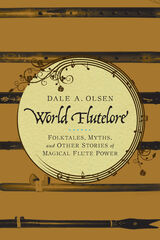 World Flutelore: Folktales, Myths, and Other Stories of Magical Flute Power
Dale A. Olsen
University of Illinois Press, 2013 In many places around the world, flutes and the sounds of flutes are powerful magical forces for seduction and love, protection, vegetal and human fertility, birth and death, and other aspects of human and nonhuman behavior. This book explores the cultural significance of flutes, flute playing, and flute players from around the world as interpreted from folktales, myths, and other stories--in a word, ""flutelore."" A scholarly yet readable study, World Flutelore: Folktales, Myths, and Other Stories of Magical Flute Power draws upon a range of sources in folklore, anthropology, ethnomusicology, and literary analysis. Describing and interpreting many examples of flutes as they are found in mythology, poetry, lyrics, and other narrative and literary sources from around the world, veteran ethnomusicologist Dale Olsen seeks to determine what is singularly distinct or unique about flutes, flute playing, and flute players in a global context. He shows how and why flutes are important for personal, communal, religious, spiritual, and secular expression and even, perhaps, existence. This is a book for students, scholars, and any reader interested in the cultural power of flutes.
 A World for Julius: A Novel
Alfredo Bryce Echenique
University of Wisconsin Press, 2004 Julius was born in a mansion on Salaverry Avenue, directly across from the old San Felipe Hippodrome. Life-size Disney characters and cowboy movie heroes romp across the walls of his nursery. Out in the carriage house, his great-grandfather’s ornate, moldering carriage takes him on imaginary adventures. But Julius’s father is dead, and his beautiful young mother passes through her children’s lives like an ephemeral shooting star. Despite the soft shelter of family and money, hard realities overshadow Julius’s expanding world, just as the rugged Andes loom over his home in Lima.
This lyrical, richly textured novel, first published in 1970 as Un mundo para Julius, opens new territory in Latin American literature with its focus on the social elite of Peru. In this postmodern novel Bryce Echenique incisively charts the decline of an influential, centuries-old aristocratic family faced with the invasion of foreign capital in the 1950s.
Winner of the Outstanding Translation Award of the American Literary Translators Association and the Columbia University Translation Center Award.
 A World Free from Nuclear Weapons: The Vatican Conference on Disarmament
Edited by Drew Christiansen, SJ and Carole Sargent. With an Address by Pope Francis . With Contributions from Seven Nobel Peace Prize Laureates
Georgetown University Press, 2023 On November 10, 2017, Pope Francis became the first pontiff in the nuclear era to take a complete stand against nuclear weapons, even as a form of deterrence. At a Vatican conference of leaders in the field of disarmament, he made it clear that the possession of the bomb itself was immoral. A World Free from Nuclear Weapons presents the pope’s address and original testimony from Nobel Peace Prize laureates, religious leaders, diplomats, and civil society activists. These luminaries, which include the pope and a Hiroshima survivor, make the moral case against possessing, manufacturing, and deploying nuclear arms. Drew Christiansen, a member of the Holy See delegation to the 2017 United Nations conference that negotiated the Treaty to Prohibit Nuclear Weapons, helps readers to understand this conference in its historical context. A World Free from Nuclear Weapons is a critical companion for scholars of modern Catholicism, moral theology, and peace studies, as well as policymakers working on effective disarmament. It shows how the Church’s revised position presents an opportunity for global leaders to connect disarmament to larger movements for peace, pointing toward future action.
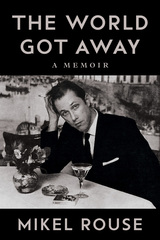 The World Got Away: A Memoir
Mikel Rouse. Foreward by Kyle Gann
University of Illinois Press, 2024 One of the most innovative composers of his generation, Mikel Rouse is known for a trilogy of operas that includes Dennis Cleveland and a gift for superimposing pop vernaculars onto avant-garde music. This memoir channels Rouse’s high energy personality into an exuberant account of the precarity and pleasures of artistic creation. Raconteur and starving artist, witty observer and acclaimed musician, Rouse emerged from the legendary art world of 1980s New York to build a forty-year career defined by stage and musical successes, inexhaustible creativity, and a support network of famous faces, loyal allies, and high art hustlers. Rouse guides readers through a working artists’ hardscrabble life while illuminating the unromantic truth that a project’s reception may depend on a talented cast and crew but can depend on reliable air conditioning. Candid and hilarious, The World Got Away is a one-of-a-kind account of a creative life fueled by talent, work, and luck.
 A World Growing Old
Jeremy Seabrook
Pluto Press, 2004 For the first time in history, the world's population is ageing. For rich countries in the west, economies rely on youthful populations to provide for those who have retired. We face a profound economic and social crisis - how do we care for the elderly when pensions and social security systems are under threat, housing is short and fewer young people are entering the workplace?
Yet this is only half the story. Populations in the poorer countries of the South are also ageing. Life-expectancy has increased due the availability of lifesaving medicine. Child mortality has decreased, so people are having smaller families. India will soon have one of the largest populations of over-sixties. The one-child policy in China will similarly lead to a severe imbalance in the age-profile of the people.
In A World Grown Old, Jeremy Seabrook examines the real implications of the ageing phenomenon and challenges our preconceptions about how it should be tackled. Arguing that the accumulated skills of the elderly should be employed to enrich society, rather than being perceived as a 'burden', he calls for a radical rethinking of our attitude to population issues, migration, social structures and employment policy.
 A World Growing Old: The Coming Health Care Challenges
Daniel Callahan, Editor
Georgetown University Press For much of the developed world, health care for a surging elderly population looms as one of the most daunting problems of the coming decade. In this book, contributors from diverse disciplinary backgrounds and countries discuss resource allocation for the elderly and debate plans for the years ahead. Essays focus on five general issues: the meaning of old age, the goals of medicine and health care for the elderly, the balance between the needs of the young and old, the pressures of other social priorities, and the role of families, especially the burden on women, in long-term care. In consideration of the difficult moral and practical issues involved, the editors conclude the volume with a special report containing policy recommendations from representatives of eight countries (the United States, Belgium, the Czech Republic, Germany, Hungary, the Netherlands, Sweden, and the United Kingdom). This important volume will be of interest to policymakers and a broad spectrum of health care professionals, as well as to anyone interested in the fate of the elderly or in coming health care challenges.
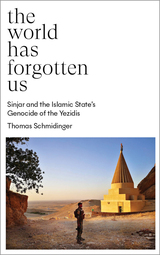 The World Has Forgotten Us: Sinjar and the Islamic State’s Genocide of the Yezidis
Thomas Schmidinger
Pluto Press, 2022 The persecution of the Yezidis, a religious community originating in Upper Mesopotamia, has been ongoing since at least the 10th century. On 3 August 2014, Islamic State attacked the Yezidi community in Sinjar, Kurdistan. Thousands were enslaved or killed in this genocide, and 100,000 people fled to Mount Sinjar, permanently exiled from their homes. Here, Thomas Schmidinger talks to the Yezidis in Iraq who tell the history of their people, why the genocide happened and how it affects their lives today. This is the first full account of these events, as told by the Yezidis in their own words, to be published in English. The failure of the Kurdistan Peshmerga of the PDK in Iraq to protect the Yezidis is explored, as is the crucial support given by the Syrian-Kurdish YPG. This multi-faceted and important history brings the fight and trauma of the Yezidis back into focus, calling for the world to remember their struggle.
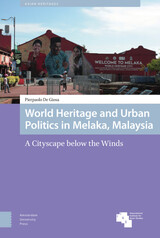 World Heritage and Urban Politics in Melaka, Malaysia: A Cityscape below the Winds
Pierpaolo De Giosa
Amsterdam University Press, 2021 Already celebrated as a busy entrepôt and the most glorious of the Malay kingdoms of the past, Melaka has been on the UNESCO World Heritage List (together with George Town) since 2008 on the strength of its multi-ethnic and multi-religious urban fabric. Yet, contrary to the expectations of heritage experts and aficionados, the global mission of safeguarding cultural heritages has become a tumultuous issue on the ground.
In World Heritage and Urban Politics in Melaka, Malaysia: A Cityscape below the Winds how the World Heritage 'label' has been, and continue to be used by different actors – such as international organizations, nation states, and society at large – to generate new economic revenues as well as to attract tourists and investments for large-scale real estate development projects is analyzed, revealing the complex and often contradictory stories behind heritage designations in urban milieus.
World History - A Genealogy: Private Conversations with World Historians, 1996–2016
Edited by Carolien Stolte and Alicia Schrikker
Leiden University Press, 2017 World History—A Genealogy charts the history of the discipline through twenty-five in-depth conversations with historians whose work has shaped the field of world history in fundamental ways. These conversations, which took place over a period of twenty years for the world history journal Itinerario, cover these historians’ lives, work, and views of the academy in general and the field of world history in particular. An extensive introduction distills the most important developments in the field from these conversations, and sheds light on what these historians have in common, as well as—perhaps more importantly—what separates them.
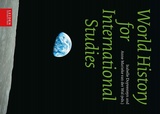 World History for International Studies
Edited by Isabelle Duyvesteyn and Anne Marieke van der Wal
Leiden University Press, 2022 Studying change in the course of human history, in different places, through the lens of a diverse set of core themes, World History for International Studies offers readers a set of windows into different debates historians have been conducting. Key themes, such as communication, trade, order, slavery, religion, war, identity, modernity, norms and ecology, are linked to specific world regions, which tell a story about how local ideas and individual contacts developed, started to overlap and became globally understood and used by ever larger groups of people. These themes are brought to life by a diverse set of key primary sources, such as a book, a letter, a medal, a temple and an epic, to showcase how historians have used sources to tell these stories and conduct debates. The book provides an introductory resource into the study of history and includes detailed suggestions for further study.
A World I Never Made
James T. Farrell, with an Introduction by Charles Fanning
University of Illinois Press, 2006 A sprawling tale of two families' struggles with harsh urban realities The first book in Farrell's five-volume series to be republished by the University of Illinois Press, A World I Never Made introduces three generations from two families, the working-class O'Neills and the lower-middle-class O'Flahertys. The lives of the O'Neills in particular reflect the tragic consequences of poverty, as young Danny O'Neill's parents--unable to sustain their large family--send him to live with his grandmother. Seen here at the age of seven, Danny is fraught with feelings of anxiety and dislocation as he learns the ins and outs of life on the street, confronting for the first time a world he never made.
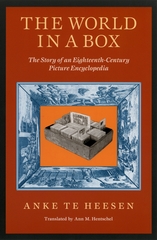 The World in a Box: The Story of an Eighteenth-Century Picture Encyclopedia
Anke te Heesen
University of Chicago Press, 2002 This is a book about a box that contained the world. The box was the Picture Academy for the Young, a popular encyclopedia in pictures invented by preacher-turned-publisher Johann Siegmund Stoy in eighteenth-century Germany. Children were expected to cut out the pictures from the Academy, glue them onto cards, and arrange those cards in ordered compartments—the whole world filed in a box of images.
As Anke te Heesen demonstrates, Stoy and his world in a box epitomized the Enlightenment concern with the creation and maintenance of an appropriate moral, intellectual, and social order. The box, and its images from nature, myth, and biblical history, were intended to teach children how to collect, store, and order knowledge. te Heesen compares the Academy with other aspects of Enlightenment material culture, such as commercial warehouses and natural history cabinets, to show how the kinds of collecting and ordering practices taught by the Academy shaped both the developing middle class in Germany and Enlightenment thought. The World in a Box, illustrated with a multitude of images of and from Stoy's Academy, offers a glimpse into a time when it was believed that knowledge could be contained and controlled.
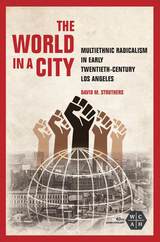 The World in a City: Multiethnic Radicalism in Early Twentieth-Century Los Angeles
David M. Struthers
University of Illinois Press, 2019 A massive population shift transformed Los Angeles in the first decades of the twentieth century. Americans from across the country relocated to the city even as an unprecedented transnational migration brought people from Asia, Europe, and Mexico. Together, these newcomers forged a multiethnic alliance of anarchists, labor unions, and leftists dedicated to challenging capitalism, racism, and often the state. David M. Struthers draws on the anarchist concept of affinity to explore the radicalism of Los Angeles's interracial working class from 1900 to 1930. Uneven economic development created precarious employment and living conditions for laborers. The resulting worker mobility led to coalitions that, inevitably, remained short lived. As Struthers shows, affinity helps us understand how individual cooperative actions shaped and reshaped these alliances. It also reveals social practices of resistance that are often too unstructured or episodic for historians to capture. What emerges is an untold history of Los Angeles and a revolutionary movement that, through myriad successes and failures, produced powerful examples of racial cooperation.
The World in a Frame: What We See in Films
Leo Braudy
University of Chicago Press, 1976 "An exciting, entertaining exploration of films. . . . [Braudy] attempts to understand rather than promulgate rules and categories, and somehow to keep the criteria of enjoyment in some meaningful connection with the criteria of judgment."—Robert Kirsch, Los Angeles Times
The World in a Frame: What We See in Films, 25th Anniversary Edition
Leo Braudy
University of Chicago Press, 2002 Now a classic, The World in a Frame covers the history of popular American films from the 1930s to the 1970s. Leo Braudy, one of America's leading film critics, gives an account of the histories of visual style and film genres, as ell as techniques of characterization—all in an evolving cultural context. This twenty-fifth anniversary edition includes a new preface addressing developments in film since 1976.
 The World in a Phrase: A Brief History of the Aphorism, Second Edition
James Geary
University of Chicago Press, 2025 Celebrating the short, witty, philosophical phrases known as aphorisms, this delightful history is an entertaining tour through the wisest and wittiest sayings in the world.
Aphorisms are literature’s hand luggage. Light and compact, they contain everything you need to get through a rough day at the office or a dark night of the soul. Aphorisms, the oldest written art form on the planet, have been going viral for thousands of years, delivering the short, sharp shock of old forgotten truths. Today, visual artists are mixing pithy language with compelling imagery and using social media to take the form into the future. In a world of disinformation and deepfakes, aphorisms point to the power of fresh debate over tired dogma and inconvenient truths over comfortable lies.
Starting in ancient China and ending with contemporary meme-makers and street artists, The World in A Phrase tells the story of the aphorism through brief biographies of some of its greatest practitioners: sages like Lao-tzu and the Buddha, philosophers like Schopenhauer and Nietzsche, writers like George Eliot and Marie von Ebner-Eschenbach, humorists like Mark Twain and Dorothy Parker, activists like James Baldwin and Audre Lorde, poets like Langston Hughes and Kay Ryan, and artists like Jenny Holzer and David Byrne.
The World in A Phrase is for lovers of words and seekers of wisdom. This new edition of The New York Times bestseller features 26 additional aphorists and explores the aphorism in the age of social media, showing why these short sentences are the ultimate deep dives in an era when TL;DR has become a cultural catchphrase.
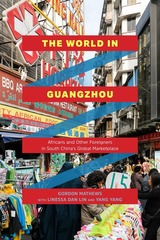 The World in Guangzhou: Africans and Other Foreigners in South China’s Global Marketplace
Gordon Mathews, Linessa Dan Lin, and Yang Yang
University of Chicago Press, 2017 Only decades ago, the population of Guangzhou was almost wholly Chinese. Today, it is a truly global city, a place where people from around the world go to make new lives, find themselves, or further their careers. A large number of these migrants are small-scale traders from Africa who deal in Chinese goods—often knockoffs or copies of high-end branded items—to send back to their home countries. In The World in Guangzhou, Gordon Mathews explores the question of how the city became a center of “low-end globalization” and shows what we can learn from that experience about similar transformations elsewhere in the world.
Through detailed ethnographic portraits, Mathews reveals a world of globalization based on informality, reputation, and trust rather than on formal contracts. How, he asks, can such informal relationships emerge between two groups—Chinese and sub-Saharan Africans—that don't share a common language, culture, or religion? And what happens when Africans move beyond their status as temporary residents and begin to put down roots and establish families?
Full of unforgettable characters, The World in Guangzhou presents a compelling account of globalization at ground level and offers a look into the future of urban life as transnational connections continue to remake cities around the world.
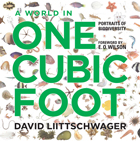 A World in One Cubic Foot: Portraits of Biodiversity
David Liittschwager
University of Chicago Press, 2012 Twelve inches by twelve inches by twelve inches, the cubic foot is a relatively tiny unit of measure compared to the whole world. With every step, we disturb and move through cubic foot after cubic foot. But behold the cubic foot in nature—from coral reefs to cloud forests to tidal pools—even in that finite space you can see the multitude of creatures that make up a vibrant ecosystem.
For A World in One Cubic Foot, esteemed nature photographer David Liittschwager took a bright green metal cube—measuring precisely one cubic foot—and set it in various ecosystems around the world, from Costa Rica to Central Park. Working with local scientists, he measured what moved through that small space in a period of twenty-four hours. He then photographed the cube’s setting and the plant, animal, and insect life inside it—anything visible to the naked eye. The result is a stunning portrait of the amazing diversity that can be found in ecosystems around the globe. Many organisms captured in Liittschwager’s photographs have rarely, if ever, been presented in their full splendor to the general reader, and the singular beauty of these images evocatively conveys the richness of life around us and the essential need for its conservation. The breathtaking images are accompanied by equally engaging essays that speak to both the landscapes and the worlds contained within them, from distinguished contributors such as Elizabeth Kolbert and Alan Huffman, in addition to an introduction by E. O. Wilson. After encountering this book, you will never look at the tiniest sliver of your own backyard or neighborhood park the same way; instead, you will be stunned by the unexpected variety of species found in an area so small.
A World in One Cubic Foot puts the world accessibly in our hands and allows us to behold the magic of an ecosystem in miniature. Liittschwager’s awe-inspiring photographs take us to places both familiar and exotic and instill new awareness of the life that abounds all around.
World in the Balance: Behind the Scenes of World War II
Gerhard L. Weinberg
Brandeis University Press, 1981 The purpose of Weinberg’s text is to suggest a way in which the dramatic events of World War II may be seen. Weinberg argues that the war must be seen as a whole, and that the presentation of it in discrete segments covering the European and Pacific portions separately distorts reality and obscures important aspects of the war on both sides of the world. In addition, any understanding of the great struggle requires a mental self-liberation from the certain knowledge of its outcome. In desperate struggles millions fought and died, hopeful or fearful--or both--but without awareness of the end.
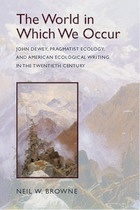 The World in Which We Occur: John Dewey, Pragmatist Ecology, and American Ecological Writing in the Twentieth Century
Neil W. Browne
University of Alabama Press, 2007 Where nature meets democracy—John Dewey’s vision for a more connected world. American philosopher John Dewey considered all human endeavors to be one with the natural world. In his writings, particularly Art as Experience (1934), Dewey insists on the primacy of the environment in aesthetic experience. Dewey’s conception of environment includes both the natural and the man-made. The World in Which We Occur highlights this notion in order to define “pragmatist ecology,” a practice rooted in the interface of the cultural and the natural. Neil Browne finds this to be a significant feature of some of the most important ecological writing of the last century. To fully understand human involvement in the natural world, Browne argues that disciplinary boundaries must be opened, with profound implications for the practice of democracy. The degradation of the physical environment and democratic decay, for Browne, are rooted in the same problem: our persistent belief that humans are somehow separate from their physical environment. Browne probes the work of a number of major American writers through the lens of Dewey’s philosophy. Among other texts examined are John Muir’s My First Summer in the Sierra (1911); Sea of Cortez (1941) by John Steinbeck and Edward Ricketts; Rachel Carson’s three books about the sea, Under the Sea-Wind (1941), The Sea Around Us (1951), and The Edge of the Sea (1955); John Haines’s The Stars, the Snow, the Fire (1989); Barry Lopez’s Arctic Dreams (1986); and Terry Tempest Williams’s Refuge (1991). Together, these texts—with their combinations of scientific observation and personal meditation—challenge the dichotomies that we have become accustomed and affirm the principles of a pragmatist ecology, one in which ecological and democratic values go hand in hand.
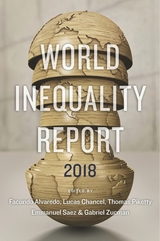 World Inequality Report 2018
Facundo Alvaredo
Harvard University Press, 2018 World Inequality Report 2018 is the most authoritative and up-to-date account of global trends in inequality. Researched, compiled, and written by a team of the world’s leading economists of inequality, it presents—with unrivaled clarity and depth—information and analysis that will be vital to policy makers and scholars everywhere.
Inequality has taken center stage in public debate as the wealthiest people in most parts of the world have seen their share of the economy soar relative to that of others, many of whom, especially in the West, have experienced stagnation. The resulting political and social pressures have posed harsh new challenges for governments and created a pressing demand for reliable data. The World Inequality Lab at the Paris School of Economics and the University of California, Berkeley, has answered this call by coordinating research into the latest trends in the accumulation and distribution of income and wealth on every continent. This inaugural report analyzes the Lab’s findings, which include data from major countries where information has traditionally been difficult to acquire, such as China, India, and Brazil. Among nations, inequality has been decreasing as traditionally poor countries’ economies have caught up with the West. The report shows, however, that inequality has been steadily deepening within almost every nation, though national trajectories vary, suggesting the importance of institutional and policy frameworks in shaping inequality.
World Inequality Report 2018 will be a key document for anyone concerned about one of the most imperative and contentious subjects in contemporary politics and economics.
 World Inequality Report 2022
Lucas Chancel, Thomas Piketty, Emmanuel Saez, Gabriel Zucman
Harvard University Press, 2022 Produced by a team of world-leading economists, this is the benchmark account of recent and historical trends in inequality.
World Inequality Report 2022 is the most authoritative and comprehensive account available of global trends in inequality. Researched, compiled, and written by a team of world-leading economists, the report builds on the pioneering edition of 2018 to provide policy makers and scholars everywhere up-to-date information about an ever broader range of countries and about forms of inequality that researchers have previously ignored or found hard to trace.
Over the past decade, inequality has taken center stage in public debate as the wealthiest people in most parts of the world have seen their share of the economy soar relative to that of others. The resulting political and social pressures have posed harsh new challenges for governments and created a pressing demand for reliable data. The World Inequality Lab, housed at the Paris School of Economics and the University of California, Berkeley, has answered this call by coordinating research into the latest trends in the accumulation and distribution of income and wealth on every continent. This new report not only extends the lab’s international reach but provides crucial new information about the history of inequality, gender inequality, environmental inequalities, and trends in international tax reform and redistribution.
World Inequality Report 2022 will be a key document for anyone concerned about one of the most imperative and contentious subjects in contemporary politics and economics.
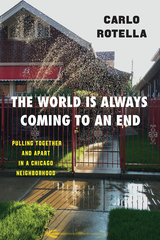 The World Is Always Coming to an End: Pulling Together and Apart in a Chicago Neighborhood
Carlo Rotella
University of Chicago Press, 2019 An urban neighborhood remakes itself every day—and unmakes itself, too. Houses and stores and streets define it in one way. But it’s also people—the people who make it their home, some eagerly, others grudgingly. A neighborhood can thrive or it can decline, and neighbors move in and move out. Sometimes they stay but withdraw behind fences and burglar alarms. If a neighborhood becomes no longer a place of sociability and street life, but of privacy indoors and fearful distrust outdoors, is it still a neighborhood?
In the late 1960s and 1970s Carlo Rotella grew up in Chicago’s South Shore neighborhood—a place of neat bungalow blocks and desolate commercial strips, and sharp, sometimes painful social contrasts. In the decades since, the hollowing out of the middle class has left residents confronting—or avoiding—each other across an expanding gap that makes it ever harder for them to recognize each other as neighbors. Rotella tells the stories that reveal how that happened—stories of deindustrialization and street life; stories of gorgeous apartments with vistas onto Lake Michigan and of Section 8 housing vouchers held by the poor. At every turn, South Shore is a study in contrasts, shaped and reshaped over the past half-century by individual stories and larger waves of change that make it an exemplar of many American urban neighborhoods. Talking with current and former residents and looking carefully at the interactions of race and class, persistence and change, Rotella explores the tension between residents’ deep investment of feeling and resources in the physical landscape of South Shore and their hesitation to make a similar commitment to the community of neighbors living there.
Blending journalism, memoir, and archival research, The World Is Always Coming to an End uses the story of one American neighborhood to challenge our assumptions about what neighborhoods are, and to think anew about what they might be if we can bridge gaps and commit anew to the people who share them with us. Tomorrow is another ending.
 The World Is Always Coming to an End: Pulling Together and Apart in a Chicago Neighborhood
Carlo Rotella
University of Chicago Press, 2019 This is an audiobook version of this book.
An urban neighborhood remakes itself every day—and unmakes itself, too. Houses and stores and streets define it in one way. But it’s also people—the people who make it their home, some eagerly, others grudgingly. A neighborhood can thrive or it can decline, and neighbors move in and move out. Sometimes they stay but withdraw behind fences and burglar alarms. If a neighborhood becomes no longer a place of sociability and street life, but of privacy indoors and fearful distrust outdoors, is it still a neighborhood?
In the late 1960s and 1970s Carlo Rotella grew up in Chicago’s South Shore neighborhood—a place of neat bungalow blocks and desolate commercial strips, and sharp, sometimes painful social contrasts. In the decades since, the hollowing out of the middle class has left residents confronting—or avoiding—each other across an expanding gap that makes it ever harder for them to recognize each other as neighbors. Rotella tells the stories that reveal how that happened—stories of deindustrialization and street life; stories of gorgeous apartments with vistas onto Lake Michigan and of Section 8 housing vouchers held by the poor. At every turn, South Shore is a study in contrasts, shaped and reshaped over the past half-century by individual stories and larger waves of change that make it an exemplar of many American urban neighborhoods. Talking with current and former residents and looking carefully at the interactions of race and class, persistence and change, Rotella explores the tension between residents’ deep investment of feeling and resources in the physical landscape of South Shore and their hesitation to make a similar commitment to the community of neighbors living there.
Blending journalism, memoir, and archival research, The World Is Always Coming to an End uses the story of one American neighborhood to challenge our assumptions about what neighborhoods are, and to think anew about what they might be if we can bridge gaps and commit anew to the people who share them with us. Tomorrow is another ending.
The World Is Gone: Philosophy in Light of the Pandemic
Gregg Lambert
University of Minnesota Press, 2021 Exploring the existential implications of the Covid-19 crisis through meditations Part personal memoir, part philosophical reflection and written in the midst of the pandemic in 2021, The World Is Gone employs the Robinson Crusoe fable to launch an existential investigation of the effects of extreme isolation, profound boredom, nightly insomnia, and the fear of madness associated with the loss of a world populated by others.
Forerunners: Ideas First is a thought-in-process series of breakthrough digital publications. Written between fresh ideas and finished books, Forerunners draws on scholarly work initiated in notable blogs, social media, conference plenaries, journal articles, and the synergy of academic exchange. This is gray literature publishing: where intense thinking, change, and speculation take place in scholarship.
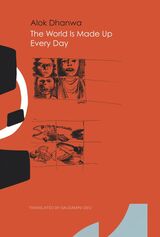 The World Is Made Up Every Day: Collected Poems
Alok Dhanwa
Seagull Books, 2025 A prominent Hindi poet’s compelling testament to the struggles and resilience of India’s marginalized communities.
A voice of the marginalized and a staunch critic of the establishment, Alok Dhanwa brilliantly captures the ethos of a turbulent era in India through his poetry. Born in 1948, in Munger, Bihar, he witnessed the rise and fall of political movements and wrote against the backdrop of the Maoist and Naxalite struggles. This collection, the first book-length translation of his work into English, brings a glimpse of a volatile nation coming to grips with its own existence to new readers.
His poetry highlights the ongoing fight for justice and identity in an ever-changing state that remains starkly relevant to the contemporary Indian polity. Dhanwa’s writing is a beacon for the working class, a testament to resistance, and a reminder that the struggle for a better world is both eternal and essential. In his universe, love, rebellion, armed resistance, and the everyday coexist. With World Is Made Up Every Day, he paints a vivid portrait of rural India’s landscapes and humanity’s capacity to defy power in all its forms. This book is not just a collection of poems; it is a call to keep the spirit of resistance alive and to live meaningfully in a world that constantly evolves but often remains unchanged.
The World Is One Place: Native American Poets Visit the Middle East
Diane Glancy
BkMk Press, 2017 This anthology explores how the Middle East has captured the imaginations of a significant group of Native American poets, most of whom have traveled to the Middle East (broadly defined to include the Arab world, Israel, Turkey, Afghanistan). What qualities of the region drew them there? What did they see? How did their cultural perspectives as Native Americans inform their reactions and insights? Three thematic sections—Place, People, Spirit—feature poems and notes inspired by the poets' experiences of Middle Eastern cultures. Contributors include Jim Barnes, Kimberly Blaeser, Trevino L. Brings Plenty, Natalie Diaz, Diane Glancy, Joy Harjo, Allison Hedge Coke, Travis Hedge Coke, Linda Hogan, LeAnne Howe, Bojan Louis, Craig Santos Perez, Linda Rodriguez, Kim Shuck, and James Thomas Stevens.
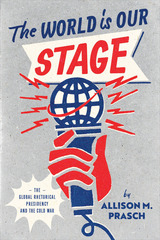 The World Is Our Stage: The Global Rhetorical Presidency and the Cold War
Allison M. Prasch
University of Chicago Press, 2023 A fresh account of the US presidential rhetoric embodied in Cold War international travel.
Crowds swarm when US presidents travel abroad, though many never hear their voices. The presidential body, moving from one secured location to another, communicates as much or more to these audiences than the texts of their speeches. In The World is Our Stage, Allison M. Prasch considers how presidential appearances overseas broadcast American superiority during the Cold War. Drawing on extensive archival research, Prasch examines five foundational moments in the development of what she calls the “global rhetorical presidency:” Truman at Potsdam, Eisenhower’s “Goodwill Tours,” Kennedy in West Berlin, Nixon in the People’s Republic of China, and Reagan in Normandy. In each case, Prasch reveals how the president’s physical presence defined the boundaries of the “Free World” and elevated the United States as the central actor in Cold War geopolitics.
 The World Is Round: Poems
Nikky Finney
Northwestern University Press, 2013 The World Is Round, Nikky Finney’s third volume of poetry, collects the wisps of memory we carry with us throughout our earthly lives and weaves them into deft and nuanced poems that emphasize understanding the cycles of life. The settings offer a view into the kaleidoscope of human experience: the sweetness and shock of family life, the omnipresent wash of memory, and the ebullience of warm Southern air. The World Is Round carries with it an implicit challenge—to the author as a poet, and to the reader as a fellow human—to see the characters and details and events of our lives with clarity, fearlessness, and love. The result is poems that range the gamut of human reach and resilience, fury and frailty. The poet’s vision of community requires understanding and tolerance from every breathing soul. Finney illuminates the cruelties of the sometimes gawking, narrow-minded world and makes a plea for compassion inspired by our common humanity.
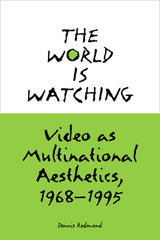 The World is Watching
Dennis Redmond
Southern Illinois University Press, 2003
Evolving rapidly from the movie screen to the television screen to the computer screen, video culture has blossomed from its origins as an obscure spin-off of the 1960s Anglo-American media culture into one of the leading art forms of the late twentieth century. And as such, video culture has grown from being the dominion of small but dedicated cult followings to becoming a near mainstream cinematic interest. The World Is Watching: Video as Multinational Aesthetics, 1968–1995 explores the origins and implications of this powerful visual medium which crosses national, cultural, and political boundaries to present provocative tales of the highest quality. Dennis Redmond’s probing study is rooted in close readings of three stylish and highly successful video efforts—The Prisoner (1967), The Decalogue (1988), and Neon Genesis: Evangelion (1995).
Irish director and star Patrick McGoohan’s classic science fiction vision, The Prisoner, established many of the basic conventions of video for such elements as shot selection, set design, scripting, scoring, and editing techniques. In The Prisoner, a government agent has resigned his position only to be immediately abducted and confined to an isolated town. Thus imprisoned, the agent faces the sinister and surreal efforts of his captors to break him and learn the secret cause of his resignation. Saturated with Cold War allegory, this seventeen-part series was groundbreaking in its exploration of new types of global content, ranging from gender and ethnic identity to the politics of information. Part futuristic thriller, part James Bond parody, the cult series remains hugely popular among partisans of science fiction, and has had an indelible influence on its mainstream descendants.
Set in a Polish housing complex, each episode of The Decalogue examines one of the ten commandments. The provocative series synthesized elements of the Eastern European auteur film with the consumerism of its Western European counterparts, establishing the new genre of Eurovideo. Paying special attention to director Krzysztof Kieslowski's micropolitics of gender, as well as his innovations in scripting, lighting, and framing, Redmond locates The Decalogue within the broader context of Polish filmmaking and as a harbinger of the subsequent Velvet Revolutions of Eastern Europe. Now available on DVD for English-speaking audiences, The Decalogue remains a stunning specimen of video artistry.
Aided by transcripts that are far superior to the flawed English dubbing in some video versions, Redmond’s analysis of Hideaki Anno’s acclaimed television series Neon Genesis: Evangelion explores the increasingly popular narrative form of anime. This animated series is set in the post-apocalyptic future, where young pilots in robotic battle suits combat alien invaders. In discussing this twenty-six part epic undertaking, Redmond identifies the impact of the Godzilla narratives, videogame culture, the Japanese mecha, the Hong Kong action thriller and the American sci-fi blockbuster on the formation of a uniquely East Asian identity and aesthetic sensibility. Anime is proving itself to be exceedingly apt and able at crossing national borders and is now enjoying mass popularity among global audiences, thus making it an ideal subject for Redmond’s telling assessment of the impact of video culture worldwide.
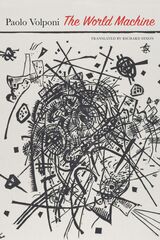 The World Machine
Paolo Volponi
Seagull Books, 2024 A vivid and unforgettable novelistic portrait of rural Italy, exploring the nature of reality and the human condition.
A small-time farmer living in central Italy in the 1960s is the keeper of a great truth: that people are machines built by other beings who are machines themselves. Our true destiny is to build ever better machines so that society can become a techno-utopia in which friendship can be established among all people on earth. These ideas bring him into conflict with everyone, especially his wife, against whom he is accused of ill-treatment. His quest takes him to Rome, where he presents his truth, hoping it will bring him worldwide recognition. Behind his poetical reveries and unfathomable scientific notions lies the disturbing fragility of a lone, paranoid, and deluded man in conflict with everyone, including himself.
Paolo Volponi’s unique novel The World Machine examines the relationship between rural life and the modern city, as well as the subversive idealism of a society still firmly anchored in the past, dominated by the Church, and unable to grasp the need for change.
 World Making in Nepantla: Feminists of Color Navigating Life and Work in the Pandemic
Gloria González-LópezSharmila RudrappaChristen A. Smith
University of Texas Press, 2025 Writings from feminist scholars of color about their experiences during the pandemic. Bringing uncertainty, fear, and change, the COVID-19 pandemic shook the world, altered people’s lives, and sparked a wave of introspection. Underserved communities—people of color, women, and queer people among them—were affected the most, and their experiences, in turn, reflected hope and opportunities to reinvent themselves individually and collectively. Drawing on Gloria Anzaldúa’s use of nepantla—the Náhuatl word meaning “in-between space,” the en medio and a liminal space between worlds imbued with change—World Making in Nepantla collects writings about the hurdles feminist scholars of color faced during the pandemic years. Contributors explore how COVID affected feminist scholars of color while recognizing the ways in which inequality influences experience and also celebrating the resilience of communities all over the world. Dispatches from classrooms and quarantined homes and introspective essays on disability, mutual aid, and borders are included among the essays here. These pieces serve as a concrete record, capturing an ephemeral time already being lost to memory. Created during the heart of the pandemic, World Making in Nepantla is an honest and intimate recording of how feminist scholars of color navigated struggles and found strength during an era that forever changed the modern world.
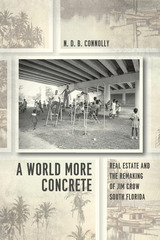 A World More Concrete: Real Estate and the Remaking of Jim Crow South Florida
N. D. B. Connolly
University of Chicago Press, 2014 Many people characterize urban renewal projects and the power of eminent domain as two of the most widely despised and often racist tools for reshaping American cities in the postwar period. In A World More Concrete, N. D. B. Connolly uses the history of South Florida to unearth an older and far more complex story. Connolly captures nearly eighty years of political and land transactions to reveal how real estate and redevelopment created and preserved metropolitan growth and racial peace under white supremacy. Using a materialist approach, he offers a long view of capitalism and the color line, following much of the money that made land taking and Jim Crow segregation profitable and preferred approaches to governing cities throughout the twentieth century.
A World More Concrete argues that black and white landlords, entrepreneurs, and even liberal community leaders used tenements and repeated land dispossession to take advantage of the poor and generate remarkable wealth. Through a political culture built on real estate, South Florida’s landlords and homeowners advanced property rights and white property rights, especially, at the expense of more inclusive visions of equality. For black people and many of their white allies, uses of eminent domain helped to harden class and color lines. Yet, for many reformers, confiscating certain kinds of real estate through eminent domain also promised to help improve housing conditions, to undermine the neighborhood influence of powerful slumlords, and to open new opportunities for suburban life for black Floridians.
Concerned more with winners and losers than with heroes and villains, A World More Concrete offers a sober assessment of money and power in Jim Crow America. It shows how negotiations between powerful real estate interests on both sides of the color line gave racial segregation a remarkable capacity to evolve, revealing property owners’ power to reshape American cities in ways that can still be seen and felt today.
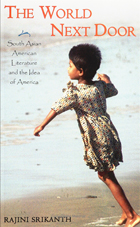 World Next Door: South Asian American Literature
Rajini Srikanth
Temple University Press, 2004 This book grows out of the question, "At this particular moment of tense geopolitics and inter-linked economies, what insights can South Asian American writing offer us about living in the world?"
South Asian American literature, with its focus on the multiple geographies and histories of the global dispersal of South Asians, pulls back from a close-up view of the United States to reveal a wider landscape of many nations and peoples.
South Asian American poets, novelists, and playwrights depict the nation as simultaneously discrete and entwined with the urgencies of places as diverse as Bangladesh, Sri Lanka, India, Burma, Pakistan, and Trinidad. Drawing on the cosmopolitan sensibility of scholars like Anthony Appiah, Vinay Dharwadker, Martha Nussbaum, Bruce Robbins, and Amartya Sen, this book exhorts North American residents to envision connectedness with inhabitants of other lands. The world out there arrives next door.
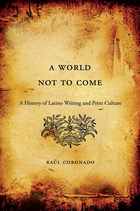 A World Not to Come: A History of Latino Writing and Print Culture
Raúl Coronado
Harvard University Press, 2013 A shift of global proportions occurred in May 1808. Napoleon Bonaparte invaded Spain and deposed the Spanish king. Overnight, the Hispanic world was transformed forever. Hispanics were forced to confront modernity, and to look beyond monarchy and religion for new sources of authority. A World Not to Come focuses on how Spanish Americans in Texas used writing as a means to establish new sources of authority, and how a Latino literary and intellectual life was born in the New World.
The geographic locale that became Texas changed sovereignty four times, from Spanish colony to Mexican republic to Texan republic and finally to a U.S. state. Following the trail of manifestos, correspondence, histories, petitions, and periodicals, Raúl Coronado goes to the writings of Texas Mexicans to explore how they began the slow process of viewing the world as no longer being a received order but a produced order. Through reconfigured publics, they debated how best to remake the social fabric even as they were caught up in a whirlwind of wars, social upheaval, and political transformations.
Yet, while imagining a new world, Texas Mexicans were undergoing a transformation from an elite community of "civilizing" conquerors to an embattled, pauperized, racialized group whose voices were annihilated by war. In the end, theirs was a world not to come. Coronado sees in this process of racialization the birth of an emergent Latino culture and literature.
|
|

